
What Size Catamaran To Sail Around The World

Last Updated by
Daniel Wade
August 30, 2022
Catamarans are generally longer than monohulls, but their accommodations and handling vary widely between sizes.
The best size catamaran to sail around the world is 45 to 50 feet. The smallest catamaran with space for long-term provisions and a cabin is around 30 feet in length, and a 55 to 60-foot catamaran is the largest that can be accommodated at most marinas.
In this article, we'll go over the different sizes of catamarans and how they handle in the open ocean. Additionally, we'll cover each size category and the best sizes for traveling the Pacific and Atlantic Oceans.
We sourced the information used in this article from marine design guides and the consensus of experienced catamaran sailors.
Table of contents

What Sizes Are Catamarans?
Catamarans come in all shapes and sizes, but the smallest models don't have the accommodations required to sail around the world. Most catamarans under 30 feet in length don't have a cabin at all, which is a stark difference that they have with monohulls.
Small monohull sailboats often have cabins, as there's plenty of room below on a wide single-hulled sailboat. Monohulls can be as small as 16 to 18 feet and still have a cabin, but catamarans must be much larger to have suitable accommodations.
The smallest catamarans are about 12 to 15 feet long. These are small recreational craft used primarily for racing, and they aren't designed for the open ocean. Larger catamarans in the 20-foot range can (and have) been used on the ocean, but they're usually classified as day boats.
Catamarans become practical for longer excursions once they hit about 30 feet in length. A boat of this size is large enough for a cabin and can usually accommodate between two and four people comfortably. Catamarans commonly stretch beyond 50 feet, which is where they're the most useful and comfortable.
Smallest Catamaran to Sail Around the World
So, what's the smallest catamaran you could use to sail around the world? In theory, any catamaran can sail long distances—but you need one that's large enough for shelter and storing provisions. Generally speaking, 30 feet is the bottom limit for an ocean-crossing catamaran.
Let's take the ME Cat 30 (Maine Cat) as an example. This small and nimble 30-foot catamaran makes use of its limited space and provides comfortable accommodations for a few adults. The ME Cat 30 is a split design that houses the basic accommodations in either hull, with an open seating area between them.
Inside the ME Cat 30, there's barely enough room for all the living spaces. It features a head and a large bed in one hull and a galley and a smaller berth in the other. With that, all the useful cabin space is filled—and this is considered a very good design for the size. As you can see, the best catamarans for sailing across the world are usually much larger.
Typical Ocean Crossing Catamaran Size
Based on what we discussed above, a 30-foot cruising catamaran is really pushing the limits on size. However, it doesn't take a whole lot more length to make a catamaran exponentially more comfortable and suitable for long journeys.
The typical ocean-crossing catamaran is usually about 40 to 45 feet long. With the addition of 10 feet in length, designers can fit an enormous amount of additional accommodations in the hulls.
This is because adding a little extra length allows designers and boatbuilders to widen each hull significantly, which makes room for luxuries like private bedrooms, multiple bathrooms, and entirely separate dining and cooking spaces.
Cruising Catamaran Floor Plans
A 40-foot to 50-foot catamaran usually comes with a mirrored floor plan. The traditional catamaran has an identical layout in each hull. That means if one hull has a private berth in the bow and a shower and a toilet in the stern, the other hull will have the exact same layout except opposite.
This is usually because spaces like the galley and sitting area are kept in the center console, where there's much more space to move around. Spaces that are used at night or only occasionally are kept in the narrow hulls, as this has proven to be a more comfortable layout for crews.
Storage is usually kept deep in the hulls as well, as there's extra space to work with when the only other design purpose is for sleeping in bathing. Catamarans in this size range can also have separate hull layouts, but the mirrored design is by far the most common.
Best Catamaran Size for Pacific Ocean Cruising
Catamarans are very versatile craft, but some function better in the Pacific Ocean than others. One of the main considerations when choosing a catamaran for Pacific Travel is that the Pacific usually has greater distances between ports and stopping points.
This is especially true on the US West Coast, where there are only a handful of ports and safe anchorages. The best Pacific cruising catamaran size is between 45 and 50 feet in length, as you're likely to need more space to store provisions for extended cruising.
If you're starting in San Francisco or Seattle, even a 'short' trip along the coastline could mean you'll pass hundreds of miles of steep rocky cliffs and no stopping points insight. When crossing the Pacific, you may travel thousands of miles before you encounter a port or island with any infrastructure at all, let alone stocks of provisions and a full-service marina.
The Pacific is a huge ocean, and the last thing you want to do is run out of food or fuel a thousand miles from your destination. Larger boats store more supplies, and they also give you more breathing room when you're surrounded by empty blue water for months on end.
Best Catamaran Size for Atlantic Ocean Cruising
The Atlantic Ocean is smaller than the Pacific Ocean, and the coastlines of many countries that border it tend to be well-developed. This makes it easier to get away with owning a smaller boat, as you don't need to store as many supplies, and your voyages will be shorter.
Another factor to consider is that not all marinas on the Atlantic can accommodate extremely large catamarans, or it may be prohibitively expensive to dock a 55-foot or 60-foot double-wide vessel. That's why the ideal size for an Atlantic-crossing catamaran is between 40 feet and 50 feet. Today, 45 feet seems to be average.
The boat of this size will fit in at most marinas in developed countries around the Atlantic, and its draft is shallow enough for island hopping and exploring the coral reefs that the Atlantic Islands are known for. Additionally, 40 to 50-foot catamarans are usually just as seaworthy as the larger boats, and they're less expensive to maintain.
Unlike the US West Coast, where ports are few and far between, the Atlantic in the Gulf of Mexico is littered with marinas and safe anchorages. You can travel for weeks along the coastline of the United States and parts of South America and never be further than a hundred miles from a full-service marina.
There are also hundreds of islands, tourist destinations, and service locations that reduce your need for large stores of provisions aboard your catamaran. This gives you a lot more flexibility in choosing a size and a floor plan, as your needs are different than that of a Pacific sailor.
Best Catamaran Size for World Cruising
If you're planning to go on a world tour or a circumnavigation, you're going to need a catamaran that's large enough to fit your crew and your provisions comfortably.
You'll also need a boat that is small enough to be serviced and accommodated in most locations but also seaworthy enough to whether anything you're likely to encounter out of the water.
For most people, the sweet spot seems to be around 45 to 50 feet in length. A 50-foot catamaran is more than large enough to store enough provisions for many months of sailing. It's also roomy enough to house two to six people comfortably for many weeks at a time.
Catamarans between 40 and 50 feet in length are also extremely seaworthy and have been known to make circumnavigation frequently. You're almost guaranteed to find a 50-foot catamaran in almost any remote anchorage in the world where sailors are known to frequent.
Also, almost any marina can accommodate a 50-foot catamaran, and most boatyards can perform at least basic repairs on a boat of this size. Most marinas have fee schedules for boats based on size, and the cutoff for large boats is usually 60 feet. This keeps you in the 'medium' boat category, which can save you thousands.
How to Choose a Catamaran Size
Choosing the right size catamaran can be challenging, but there are a few things you can do to narrow it down. First, examine how you plan to use the vessel. You can travel the oceans in a catamaran between 30 and 40 feet long, so if you have a small crew, you may want to consider a compact model.
Larger catamarans can sleep eight or more people comfortably. This is large enough for most people, though some charter captains may need additional room. A 40 to 45-foot catamaran is usually large enough for a small family, though a 50-footer would be more comfortable, especially if there are kids running around.
Related Articles
I've personally had thousands of questions about sailing and sailboats over the years. As I learn and experience sailing, and the community, I share the answers that work and make sense to me, here on Life of Sailing.
by this author
Most Recent

What Does "Sailing By The Lee" Mean?
October 3, 2023

The Best Sailing Schools And Programs: Reviews & Ratings
September 26, 2023
Important Legal Info
Lifeofsailing.com is a participant in the Amazon Services LLC Associates Program, an affiliate advertising program designed to provide a means for sites to earn advertising fees by advertising and linking to Amazon. This site also participates in other affiliate programs and is compensated for referring traffic and business to these companies.
Similar Posts

How To Choose The Right Sailing Instructor
August 16, 2023

Cost To Sail Around The World
May 16, 2023

Why Do Catamarans Have Trampolines?
April 17, 2023
Popular Posts

Best Liveaboard Catamaran Sailboats
December 28, 2023

Can a Novice Sail Around the World?
Elizabeth O'Malley
June 15, 2022

4 Best Electric Outboard Motors

How Long Did It Take The Vikings To Sail To England?

10 Best Sailboat Brands (And Why)
December 20, 2023

7 Best Places To Liveaboard A Sailboat
Get the best sailing content.
Top Rated Posts
Lifeofsailing.com is a participant in the Amazon Services LLC Associates Program, an affiliate advertising program designed to provide a means for sites to earn advertising fees by advertising and linking to Amazon. This site also participates in other affiliate programs and is compensated for referring traffic and business to these companies. (866) 342-SAIL
© 2024 Life of Sailing Email: [email protected] Address: 11816 Inwood Rd #3024 Dallas, TX 75244 Disclaimer Privacy Policy

My Cruiser Life Magazine
Best Catamaran for Sailing Around the World — Best Cruising Catamarans
Sailing around the world is a dream of many. It’s the grandest adventure you can have in a sailing vessel—or at least one of the top five. But what kind of boat do you choose?
For many, the go-to answer has become a bluewater catamaran. These boats offer outstanding comfort and living space. They outperform most monohull sailboats of their size, and their bright and airy salons and cockpits will convert non-sailors to the ideas of what is possible with such a boat.
Here’s a look at some of the best long distance cruising catamarans and why these boats are great choices for many crews.
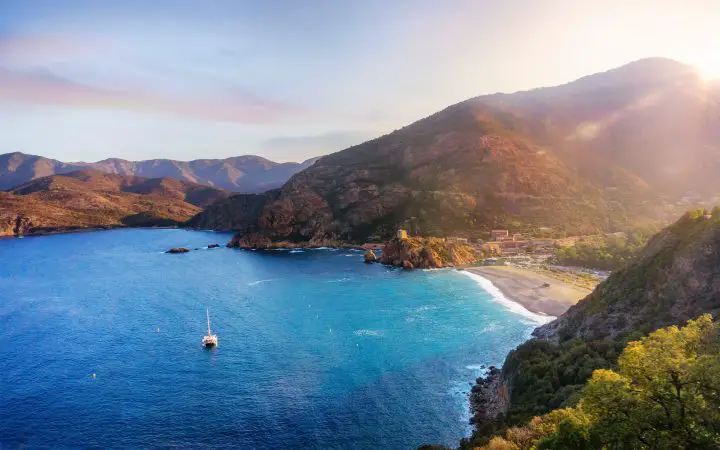
Table of Contents
Lagoon 440/450/46, leopard catamarans 42/43 (circa 2000-2007), pdq antares 44/44i, catana 471/47, fountaine pajot orana / helia 44, balance 482, what is a cruising catamaran, cruising catamaran pros, cons of catamaran offshore cruising, what to look for — best catamaran for sailing around the world, best cruising catamarans faqs, 8 popular choices for best cruising catamarans.
Every boat has strengths and weaknesses, and every list is biased. There are tons of boats out there, and it’s impossible to be familiar with every single one. Furthermore, as time passes and our needs change, the types of boats that catch our attention change.
Sailing long distances, like around the world, is a very specific mission. It’s not something you wake up one morning and say, “Today, I’m setting off around the world!”
No, a circumnavigation is the culmination of years of preparation and research. Just finding the right boat is a big part of that. Some experienced cruisers make their business helping people find the right boat to suit their needs. If you’re completely lost in the boat-buying process, reaching out to an experienced expert (not just a yacht broker!) is an important step.
One such person is John Neal. Neal runs Mahina Offshore Services and is a consultant for folks wanting to cast off the lines. He’s written extensively about what makes a good bluewater cruiser and specializes in boat consultations. Be sure to visit his website and download his free ebook, Selecting and Purchasing an Ocean Cruising Sailboat.
Another great resource, especially if you’re considering voyaging with your kids, are Jamie and Behan Gifford of Sailing Totem . They work as consultants helping couples and families find their path to a successful circumnavigation—what they call “from dream worthy to seaworthy.” Totem and crew crossed their wake a few years back, and they write for Cruising World and often speak at events like Cruiser University at the Annapolis Sailboat Show in the fall.
Here’s a look at some of the most popular long-distance cruising catamarans. This isn’t an all-inclusive list, nor are these really recommendations. Rather, they’re a look at some boats, both good and bad, to consider for the ultimate sailing adventure.
View this post on Instagram A post shared by Katamarans (@katamarans)
Lagoons are the ubiquitous production boat of the catamaran world. Next to Leopard, they dominate nearly every list of catamarans since the company makes so many of them. They’ve been cranking these boats out for over 20 years, longer than many other manufacturers. When you do the math, there’re more examples of individual Lagoon models out there than hulls made by many other manufacturers combined.
What does all that mean for the buyer? For one thing, it means it’s not hard to find a Lagoon for sale. If you pick your model, you’ll probably find a few dozen for sale worldwide at any given time. A cursory look at Yacht World shows 23 listings for the 440 and another 77 for the 450 (not including those listed separately as 450F and 450S!).
The 440 was the first of Lagoon’s popular flybridge models. This offers an upper level so that the helmsperson can see all points of the boat and is separate from the salon and cockpit area. Many liveaboard 440 owners have converted the upper flybridge with an enclosure to make it an all-weather helm.
The 450 took the 440’s success and improved all the details. The updated design was one of the most popular boats Lagoon ever made. They eventually divided the lineup it the 450F, with the standard flybridge, and the 450S, with a “sporty” helm on the aft coachroof.
Both are very popular boats and are sized right for world voyaging. They aren’t without problems, however. Around 2020, many owners began discovering serious problems with bulkheads delaminating from the hulls. However, Lagoon has an official fix, and many boats have been successfully repaired. As always, get a good survey, research, and ask the right questions!
Lagoon 450s are currently listed for anywhere between $400,000 and $800,000. 440s are older and can be found between $275,000 and $450,000. As always, keep your eyes peeled for the less common and much more comfortable owners’ version layouts with one huge master cabin.
View this post on Instagram A post shared by Solo Deniz (@solo_deniz)
Leopard is another ubiquitous brand in the catamaran world. The company’s newer models, like the current (2023) Leopard 45, have a forward seating area and a large opening door on the front of the salon. In short, they’re perfect charter boats. Leopard habitually reuses their model numbers repeatedly, making getting the right model confusing. The newest Leopard 42 started production in 2020 and features the forward patio lounge.
The Leopards included on this list are much older and lack this forward patio design. Instead, these original Leopards have a low-profile aesthetic perfect for ocean sailing. They’re comfortable and functional. They’re a little on the small size for world cruising but would be perfectly suited for a couple that wants the smallest boat they can get.
The difference between the two models was only one thing—the 42 included a soft-top bimini, while the 43 had a hard top. Most owners have now converted their 42’s soft top to a hard one.
Leopard 42s and 43s from 2000 to 2007 are currently listed between $250,000 and $350,000. The 43s, which are a bit newer, go for just a little more. Since so many saw charter use, finding good examples with owner’s layouts is hard. When you do, they’re worth the trouble to bring home.
If you’re looking for a bargain, the older Leopard 45 and 47 were remarkably similar in design. They are less common on the used market today, but if you find one in good shape, it’s worth a look.
This boat started life built by Canadian catamaran builder PDQ. The design was wildly successful. However, when PDQ shut down, the hull molds made their way to Argentina and found new life. This is one of the few catamarans out there that is built for the specific mission we’re addressing here—a long distance cruising catamaran for a couple or a small family.
The Antares is built from the keels up to be reliable, simple, comfortable, and safe. She’s not winning any races against the Outremers, Gunboats, or fastest catamarans of the world, but she makes up for it with her sturdy design and comfortable handling.
At 44 feet long, she’s the perfect length for a voyaging catamaran. She has impressive bridgedeck clearance and can handle most anything King Neptune throws her way. Her fit and finish are above average—excellent, in fact—and her layout is supremely functional. This is one catamaran that must be on your shortlist if you’re considering a circumnavigation.
Currently, two Antares are listed on the market, from $595,000 to $798,000. Only a handful of 44s are out there, and while the boat has been in production since around the year 2000, there just aren’t many to choose from. Those that are out there are coveted for their build quality and seaworthiness, so they don’t come cheap.
Catana is a French builder that makes performance catamarans with retractable daggerboards. These improve upwind performance dramatically and reduce your draft when gunkholing. Proponents of daggerboard designs will also point to their improved handling at sea, allowing the boat to slip freely down waves, thereby reducing the likelihood of capsizing in extreme conditions.
Catanas also feature a unique helm layout. Twin helms are located outboard on each stern, so you can pick your driving position for the best visibility, the best shade, or the best breeze. You’ll be driving with the autopilot from the nav station at sea anyway. It keeps sailing a little more fun when you’re out there for the fun of it.
The 47 and 47OC (Ocean Class) are the newer versions of the boat. All versions feature Catana’s uniquely strong, lightweight composite layups and distinctive asymmetric narrow hulls. They’ve got outstanding bridgedeck clearance and
Catana 47s and 47OCs are listed between $360,000 and $700,000. The older 471 is a little harder to find. Catana has always been a higher-end, low-volume brand that makes fewer hulls each year than other makes.
Fountaine Pajot is the third of the “big three” catamaran makers. The French brand is often compared to Lagoon and Leopard, but their designs have always stuck more on the performance side than the bulky cruiser side. In the ocean-going length, their 44-footers are just about right.
Regarding layouts and features, it’s hard to imagine a more perfectly suited boat than the FP 44s. These boats are big enough to carry all your stuff and give you space to spread out. But they’re also good sailors and stable at sea. They feature the preferred coachroof-mounted helm, which is raised enough to provide good visibility without being disconnected from the action in the cockpit.
Oranas are currently listed from $295,000 to $468,000, while the newer and more popular Helias go for anywhere from $447,000 to $649,000. These were popular boats with private owners, and in charter, so there are usually quite a few available.
View this post on Instagram A post shared by David & Amy (@outchasingstars)
Mantas are a well-built, American-made catamaran sailboat that went through several revisions. Overall, the hulls and layouts never changed from the early 38s to the last 42 Mark IVs. But the transoms were extended for speed and better handling, and the extra length of the later models makes them just right for a small ocean-going cat.
Balance is a South African company that has made their business to produce a modern sailing catamaran for a new age of sailing. This isn’t a legacy brand, so you aren’t going to find one at a bargain price. Instead, these boats are being built on a semi-custom basis for owners like us who want to sail their boats around the world.
The company describes the Balance 482 as a “trend-setting circumnavigator.” It won Boat of the Year from Sailing World Magazine in 2022.
HH boats are built in Asia as cutting-edge sailing catamarans for the owner/sailor market. They’re designed by Morrelli and Melvin, one of the multihull world’s top design firms.
These boats are also semi-custom, so you won’t find many on the used market. They’re known for their modern innovations, including a fold-down swim platform and an EcoDrive hybrid system. You can spec your boat with either mini keels (OC or “ocean cruising”) or daggerboards (SC or “sport cruising”).
The HH50 is the company’s best bet for circumnavigating with a small family. There’s also the capable, smaller sistership, the HH44.
Why Are Catamarans Great for Long-Distance Voyaging?
Catamarans are immensely popular for a few reasons. For one thing, they’re some of the most comfortable boats for long-term living aboard. They offer lots of living space, storage, and tankage. They have panoramic views, with huge windows letting light and air into the open salon. Unlike classic monohull sailboats, they are not dark and stuffy at all.
Catamarans also don’t heel like monohull sailboats do. This is good and bad, but most people (especially non-sailors) prefer it. It means when you’re sailing, you aren’t at an angle for days or weeks at a time. Your stuff isn’t constantly rolling downhill on the counter and falling out of the medicine cabinet whenever you open the door. They still move and rock on the waves, but the motion is always more upright than heeled to one side.
There are a dozen other reasons folks prefer catamarans to monohulls for long-distance or long-term traveling. And, like all things in boating, every sailor is a little different. Some don’t like catamarans and prefer a beefy bluewater monohull’s stability and solid feel. Your mileage may vary, as the saying goes.
Of course, the longest voyage of them all is sailing around the world. The typical downwind circumnavigation involves several long-distance passages and many months of hopping through remote island nations. The longest leg is typically from Panama or the Galapagos Islands to French Polynesia (The Marquesa Islands), a leg of at least 3,000 nm that typically takes 20 days or more.
In total, a circumnavigation takes at least 18 months but commonly even longer. That’s a long time to spend on any vessel, so the comfort of a cruising catamaran makes a lot of sense.
A cruising catamaran is roughly defined as one designed to carry passengers and crew long distances. Obviously, this means it needs to be equipped with staterooms and heads, a galley, and a salon. But that also means it must hold enough fuel and water to keep its passengers safe for long voyages.
The cat also needs to be designed to be stable enough for all of that to be used to capacity. Two to four people, plus enough supplies to keep them fed and healthy for months, weighs quite a lot. Then you add in spare parts, water toys, and other goodies, and it adds up. Catamaran speed and stability come from its lightweight design. If you make it too heavy and overload it, it will be slow and less stable in rough conditions.
When you consider all of this, you’ll come up with a minimum size for a catamaran to carry all the stuff you need for such a long voyage. Generally, the smallest cats in this class will be around 42 feet long. This is the right size for a cruising couple that doesn’t often sail with others. A 44-footer will be a little more comfortable and make having occasional guests onboard a more pleasant experience. Once you get to 50 feet or longer, the boat is a bit large for most private owner skippers to handle. Costs start to balloon at this length and above, as well.
What about a small catamaran ? Many people have successfully done the trip in smaller boats, of course. Generally, however, these smaller cats are pushed to their limits in terms of load carrying capacity. In most cases, circumnavigators will take on extra crew for longer legs (this is sometimes even an insurance requirement!). The ride in rough seas is not as good in shorter cats, which tend to hobby horse more in a chop. So, overall, 42 feet and above is about the sweet spot.
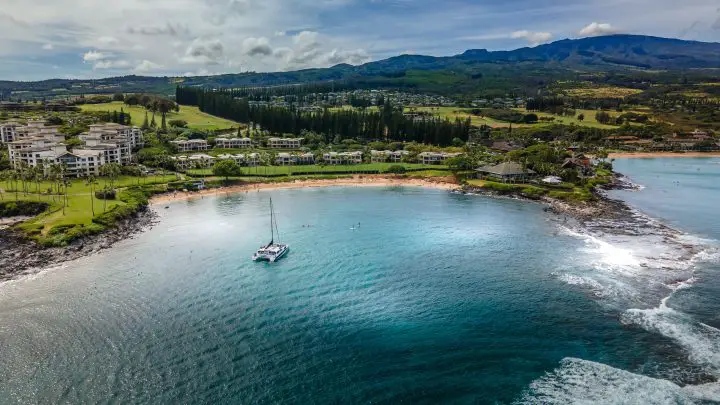
Comfortable Living Space
The huge salons and cockpits catamarans offer, with comfortable seating at big tables, truly improve your life at sea. The importance of all the light and air coming through those windows can’t be underestimated—it’s great at anchor when enjoying the sunset. But it’s also great to have an interior nav station where you can keep watch from the comfort of the salon. In short, a liveaboard catamaran is one of the most comfortable options for any type of cruising.
Better Speed, Especially Downwind
Compared to monohulls of similar length, catamarans are nearly always faster. This goes for fast catamarans, sure, but also for cruising catamarans. This becomes very apparent when traveling downwind, something that most monohulls struggle with. And downwind is the preferred direction to travel on a sail around the world route .
Comfort at Sea
The lack of heeling makes catamarans the preferred choice for long distance sailing. When given the choice of doing a 20-day passage perfectly upright or at a 10-degree tilt, which would you pick? Even the saltiest of sailors has to agree that heeling over is fun for a while but gets tiring quickly.
Redundant Systems and Structures
With two hulls, two engines, two water tanks, two fuel tanks, two sets of bilge pumps, and tons of other redundancy built in, catamarans offer owners extra layers of safety.
If all of this sounds too good to be true, it’s because we haven’t discussed the most limiting factor for most sailors—the cost of the boat! Catamarans are expensive from the outset. When juggling all of the factors with an around-the-world cruise, boat cost is the biggest.
Catamarans cost more than monohulls for many reasons. They are larger, but even still, they often sell for more. One reason is their popularity. These boats are in demand. Far fewer examples are on the market than monohulls, and more buyers are looking to purchase them. So prices are high and are likely to stay high. On the other hand, Monohull prices are much lower because there are more monohulls out there than there are monohull buyers.
With any boat, there is also the cost of keeping it once you own it. The larger the boat, the greater your expenses will be. This is true for everything from maintenance to storage. Catamarans cost more than monohulls in nearly every instance. For maintenance, you’ll be limited to facilities that can haul a boat with your width—which will be more expensive. You’ll have two engines, which means twice the maintenance and twice the replacement cost when that time comes.
Choppy Motion
Despite all the plusses and the flat ride, plenty of sailors out there just don’t like the ride a catamaran offers. You have to take one to sea to understand fully. A catamaran is light and tries to fly across the water, from wave to wave. It smacks each wave twice and always tries to come back upright after each impact. This leads to a choppy, jarring ride sometimes.
A monohull is built heavy and is designed to slice through the waves and push the water out of its way. The wind pressure on the sails keeps the boat’s angle steady (in most cases). So, a heavy monohull can ride quite comfortably in a chop, whereas a catamaran might feel like it’s taking a pounding. Many heavy-displacement monohulls built for long-distance travel were designed to provide a soft, comfortable ride that allows the crew to rest.
All sea conditions are different, as are all sailors and their expectations. So this is a personal choice as to which method you like better. And for every condition uncomfortable in a catamaran but smoother in a monohull, there’s something smooth and lovely in the cat and uncomfortable in the monohull. The ocean is just like that.
All cruising cats over about 40 feet are capable, and most have become proven circumnavigators in the past few decades. The right one for you simply comes down to the balance of cruising amenities versus performance. Fast catamarans are all the rage, but you’ll have to put a price on exactly how much performance you can afford.
To learn more about other boats before deciding, check out:
- Catamaran vs Pontoon
- Yacht vs Sailboat
What type of boat is best for sailing around the world?
The type of boat best suited to sailing around the world is a well-built, long-distance cruising boat. Many sailboats fall into the camp, both monohulls and catamarans.
This question has a million answers. Ask every sailor who wants to go around the world, and you’ll get a different one. And, once they’ve sailed around the world on that boat, they’d choose a different boat. The only rule is that there is no perfect boat.
What is the best catamaran to sail Caribbean?
Catamarans are extremely popular in the Caribbean because their open-air living space allows cooling airflow. Their living space is supremely suited for the tropical environment—imagine living al fresco on the waterfront all the time!
The right catamaran for the job depends on your group size and how long you intend to spend aboard. Full-time liveaboard couples prefer cats in the 38 to 44-foot range, while small families opt for something slightly larger.
Are catamarans easier to sail?
Catamarans are easy to sail—but similar to sailing a similar-length monohull sailboat. Beginners sometimes find them less intimidating because they do not heel and therefore seem more stable. However, monohulls are more forgiving of errors. Catamarans have large sails and rigging, and reefing early to avoid overloading the rig is extremely important on these boats. For more on beginner boats, check out my post: Best Boat for Beginners .
Matt has been boating around Florida for over 25 years in everything from small powerboats to large cruising catamarans. He currently lives aboard a 38-foot Cabo Rico sailboat with his wife Lucy and adventure dog Chelsea. Together, they cruise between winters in The Bahamas and summers in the Chesapeake Bay.
Leave a comment
Your email address will not be published. Required fields are marked *
Save my name, email, and website in this browser for the next time I comment.

- BOAT OF THE YEAR
- Newsletters
- Sailboat Reviews
- Boating Safety
- Sails and Rigging
- Maintenance
- Sailing Totem
- Sailor & Galley
- Living Aboard
- Destinations
- Gear & Electronics
- Charter Resources

Best Cruising Catamarans
- By Cruising World Editors
- Updated: July 1, 2021
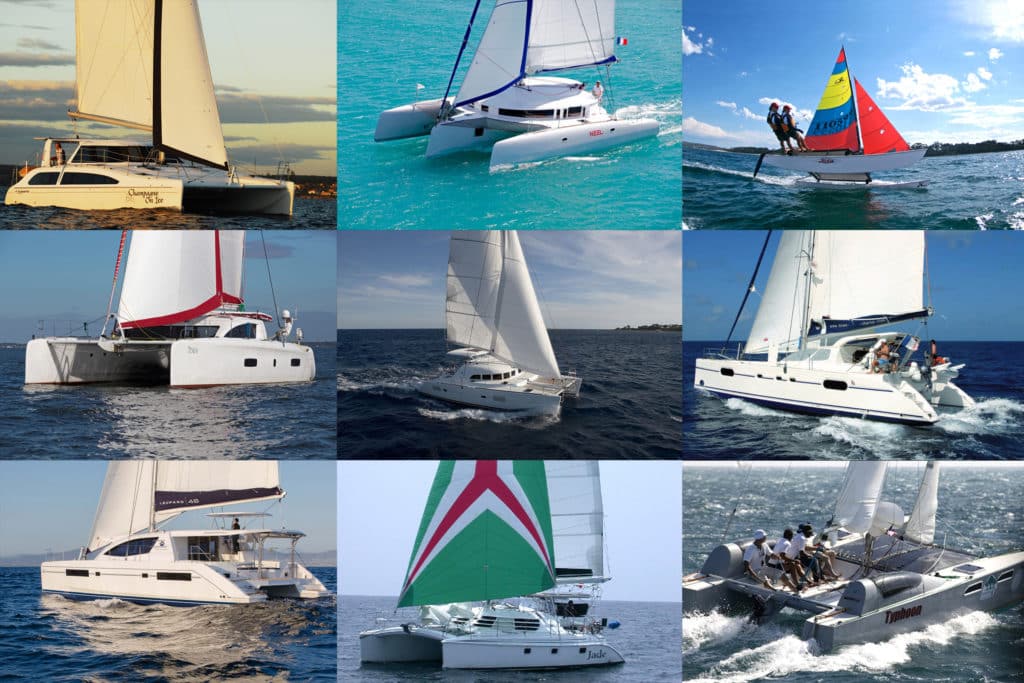
Cruising catamarans have been around for decades, but early models—often plywood and fiberglass vessels built by their owners from plans and kits, kept the boats on the fringes of mainstream sailing. That all changed, though, as big roomy cats were discovered by sailors who went off to charter in the Caribbean, where the multihulls proved their worth as comfortable liveaboard and party boats.
Today’s bluewater catamarans roam the globe, carrying families to exotic destinations across the Pacific and beyond. Just as with their monohull cousins, there is no best catamaran. Instead there is a wide variety of designs, ranging from small catamarans that offer the ease of maintenance a couple might enjoy to performance catamarans capable of easily knocking off 250-mile days. Today, the best catamaran brands offer a range of size models and layouts that can be optimized for an owner sailing with family and friends, or for the charter market, where there’s a demand for four, five and even six cabins worth of accommodations.
The most prolific catamaran manufacturers are in France and South Africa where yards include both large-run production builders and niche companies building fewer than 10 boats a year.
The best cruising catamarans offer good load-carrying ability and respectable performance. As with any sailboat , a modern catamaran’s design is a result of compromises. Daggerboards or keels? Galley up or galley down? Spacious owner’s cabin or extra bunks? There are lots of options to choose from—and that’s what makes looking at these sailboats fun!
Here, then is an eclectic A to Z list of some of the best catamarans that have helped shaped the evolution of how we live and sail on two hulls.
Antares 44i
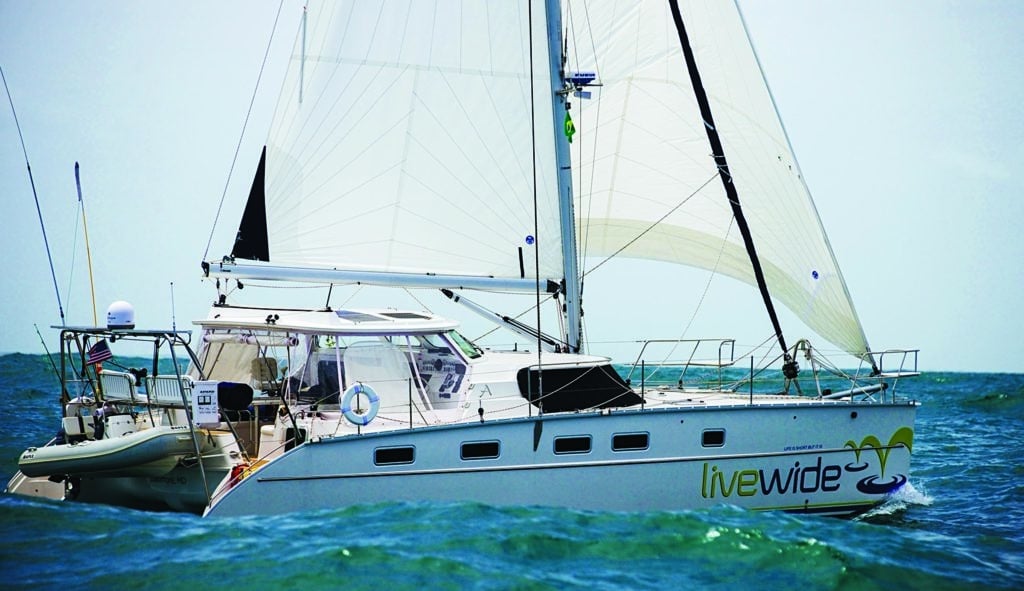
Now built in Argentina as a full-fledged, bluewater catamaran and cruiser that can be safely operated by a shorthanded couple or family crew, the Antares 44i features a fully covered cockpit with a quartet of big, standard solar panels recessed within the hardtop, one example of a yacht capable of long-range passagemaking.
Atlantic 42
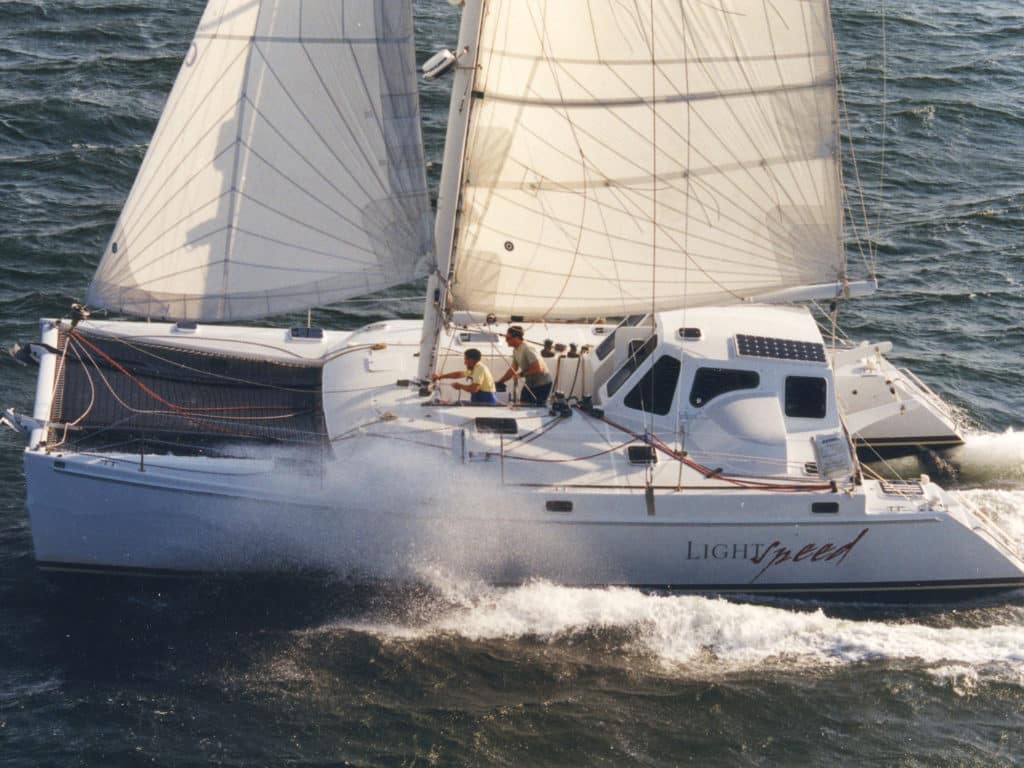
Almost 30 years ago, yacht designer Chris White revolutionized catamaran design with the first in his series of Atlantic cats, the primary feature of which was the innovative mid-ship sailing cockpit forward of the main cabin. The smallest in the Atlantic line, the 42 remains White’s most popular design ever.
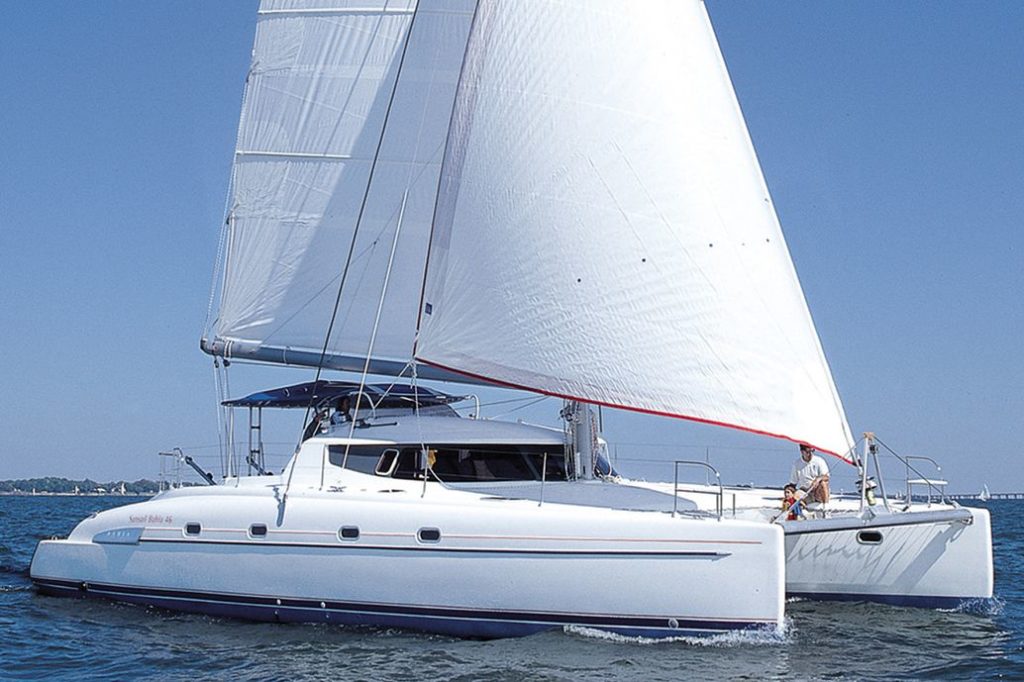
Fountaine-Pajot has built so many outstanding cruising catamarans that it’s difficult to narrow down any single boat, but we’ve always been fans of the good-looking, well-thought-out Bahia 46. At 46 feet, the boat is large enough for offshore forays and has plenty of volume; with its simple but powerful sail plan, it’s also an excellent performer.
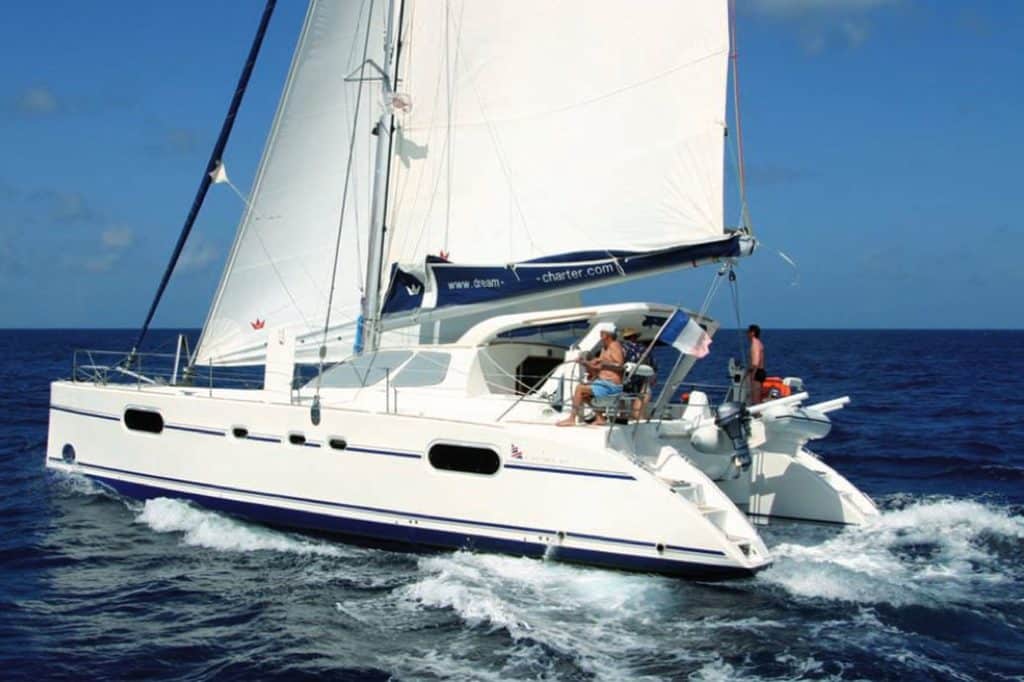
Beginning around 1996, the French builder Catana was one of the first companies to manufacture fully found cruising cats for private ownership, and this Christophe Barreau design, which enjoyed a nearly 10-year production run from 1997-2006, was emblematic of this first generation of safe, fun, long-legged offshore voyagers.
Click here to see more cats from Catana.
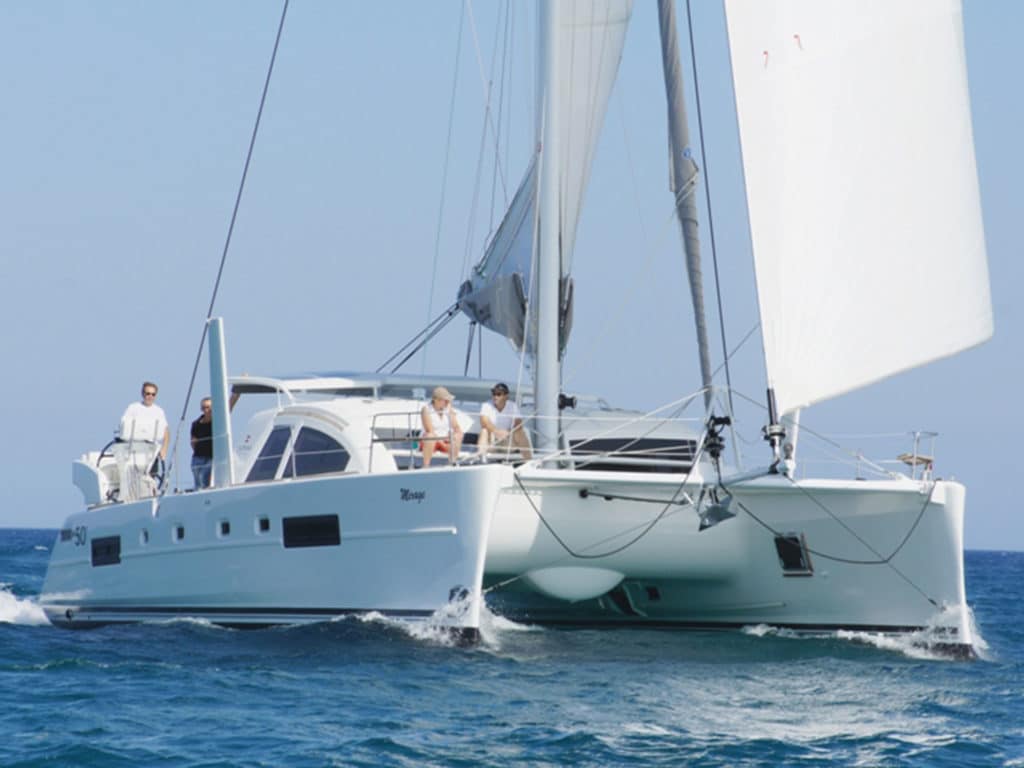
When it comes to speed, light boats are fast ones. And if you wish to save weight, that means exotic modern materials like carbon. Catana now infuses the laminates of their entire production line with carbon fiber, and for this list, we’ve chosen the Catana 50 Carbon, one of the zippiest cats now crossing oceans.
Click here to read about a couple’s charter aboard a Catana 50.
Gemini 105M
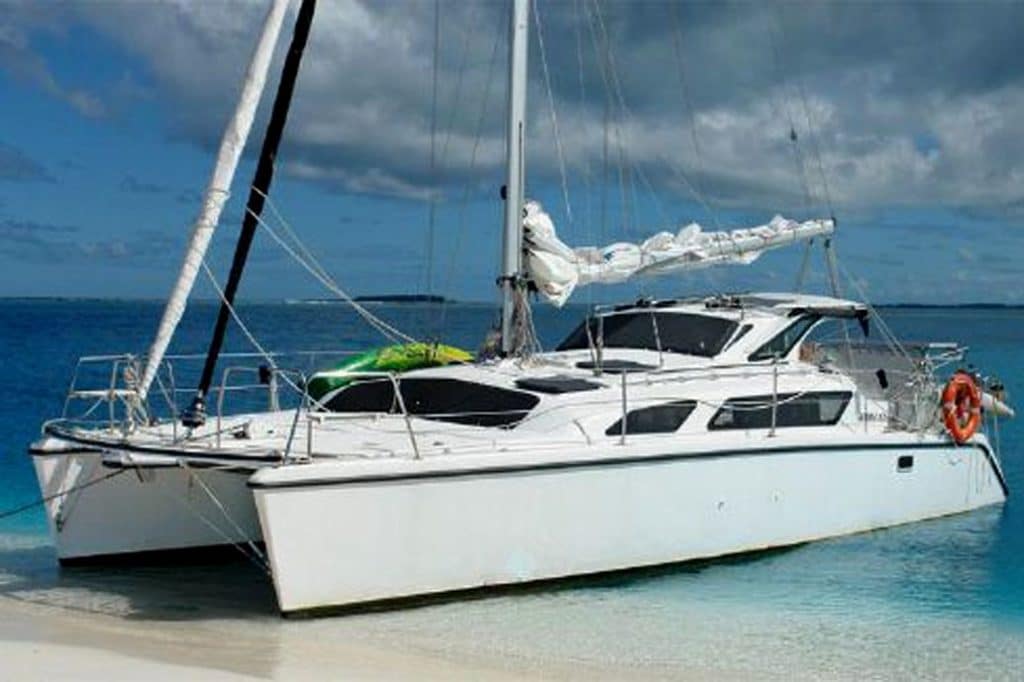
Pioneering catamaran sailor, builder and designer Tony Smith launched the first of his 33-foot Gemini 105M’s (10.5 meters = 33′) in 1993, and soon after found a ready and willing stream of sailors enamored of the boat’s compact size, affordable price tag, and such innovations as the nifty lifting rudder and transom steps.
Click here to read about the Gemini Legacy 35.
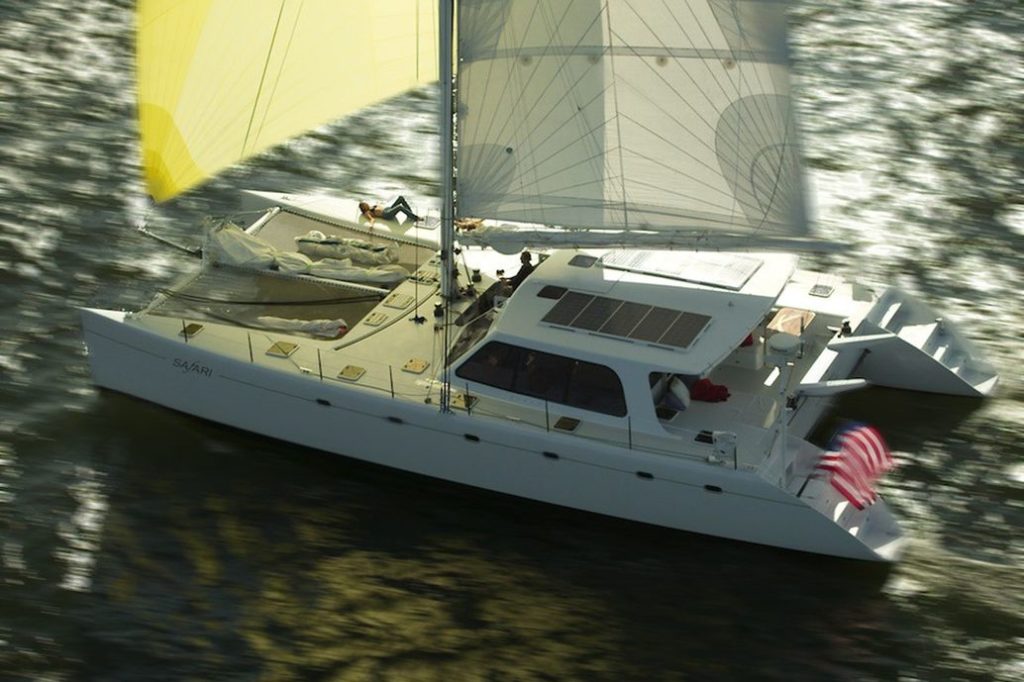
Built between 2000-2005, the Gunboat 62 firmly established the Gunboat brand: go-anywhere cats that applied race-boat technology to a world-cruising platform. Hull no. 1, Tribe, was built for company founder Peter Johnstone, who then spent a year-and-a-half cruising with his family, smiling all the way.
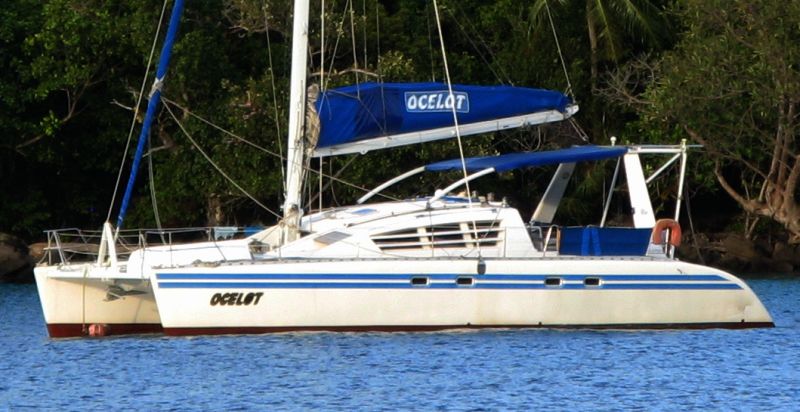
French builder Henri Wauquiez is best known for his long career building monohulls, but the Kronos 45 cat, which he launched in 1992, was ahead of her time. Classic lines, the aft “targa bar” over the cockpit, the louvered coach roof windows, even the distinctive stripes on her hull: the Kronos 45 remains timeless.
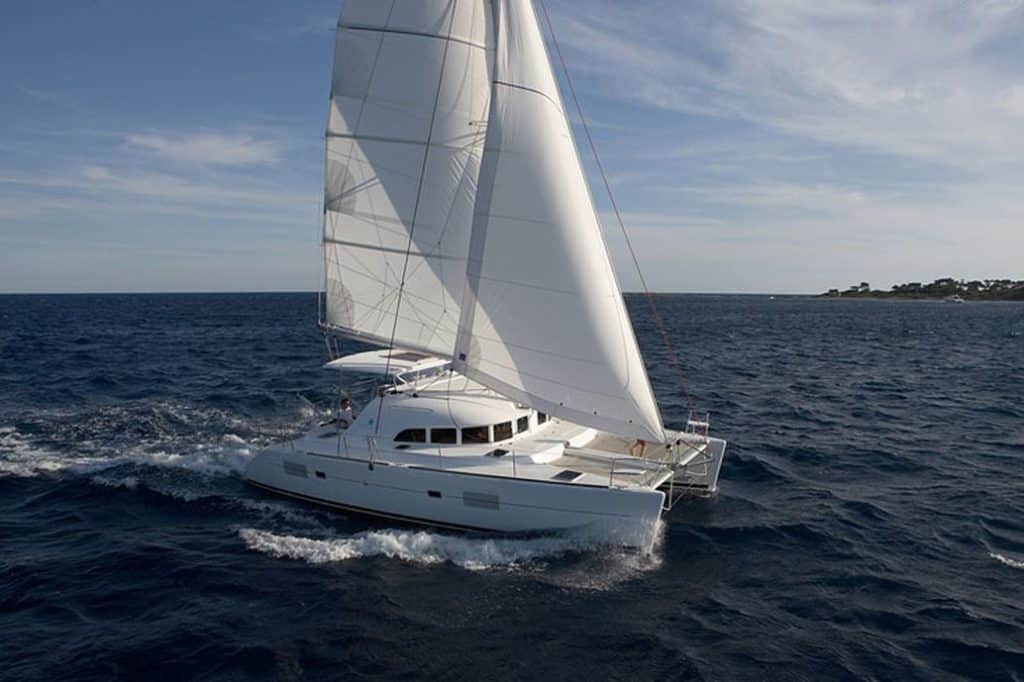
No roundup of cruising cats would be complete without several Lagoon entries, and the best of that impressive bunch might well be the Lagoon 380. Originally launched in 1999, and revered for its combination of quality, volume and performance, with over 740 boats built the 380 is still going strong.
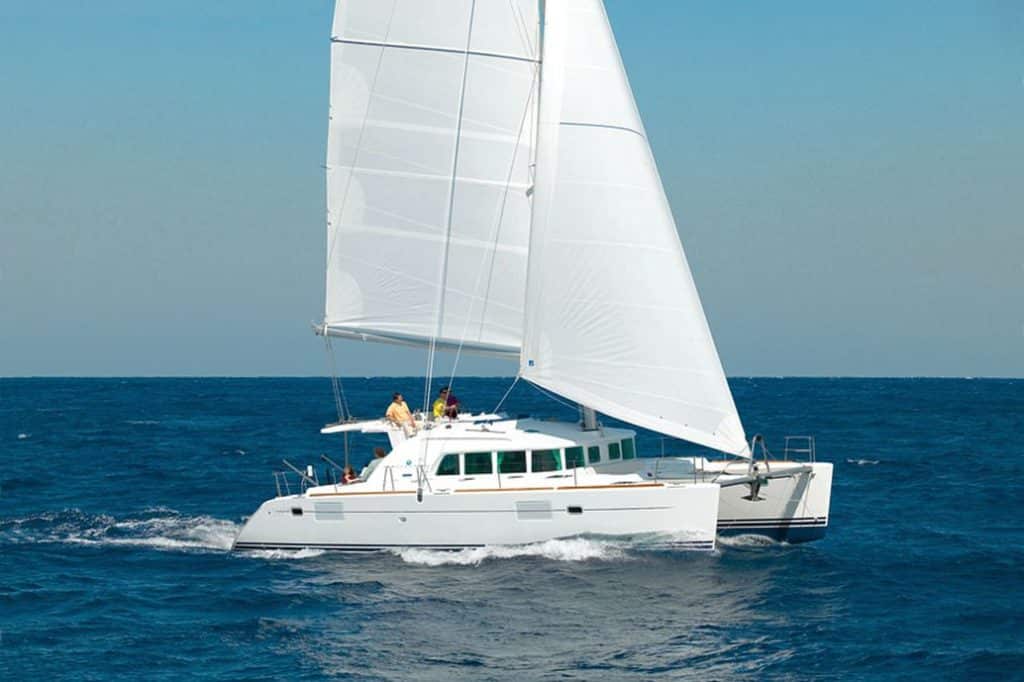
Launched five years after the breakthrough 380, the Lagoon 440 was an evolutionary design that featured a raised flybridge helm station, a unique “gullwing” configuration below the bridge deck, expanded windows in the hull and much more. With 400 boats built in a 6-year production run, the 440 was an unqualified success.
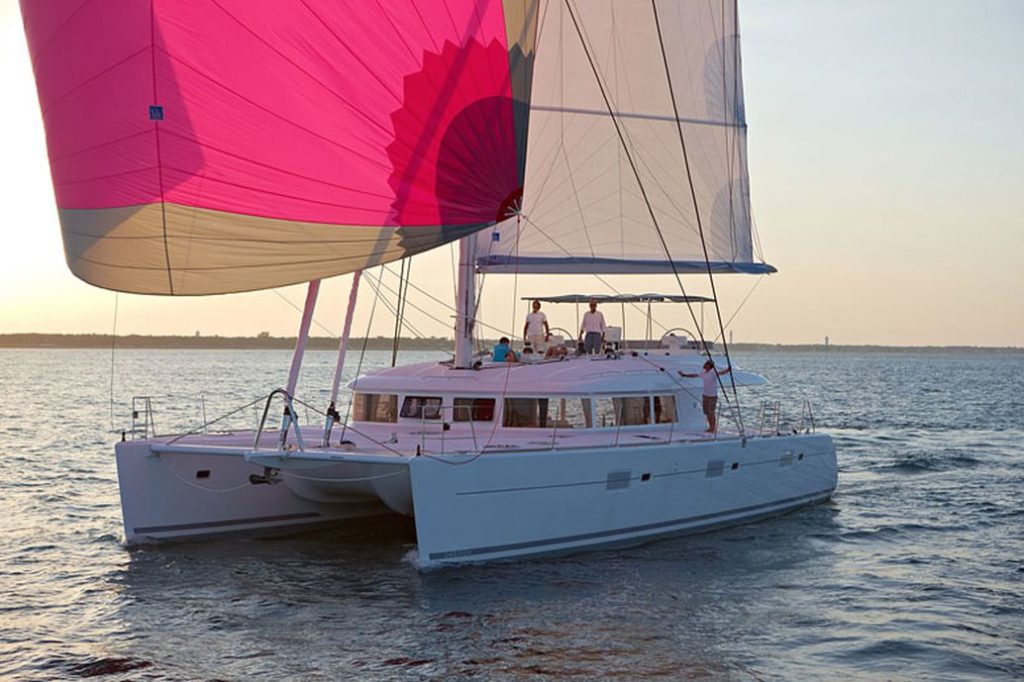
How big can a production cat, still operable by a short-handed crew, really be? The builders at Lagoon discovered that 62-feet hit a sweet spot in the marketplace, and have sold over 70 boats since its introduction in 2010. The centerpiece of this design is the sensational steering station atop the flybridge, with expansive views of the sea and sky.
Click here to see more cats from Lagoon.
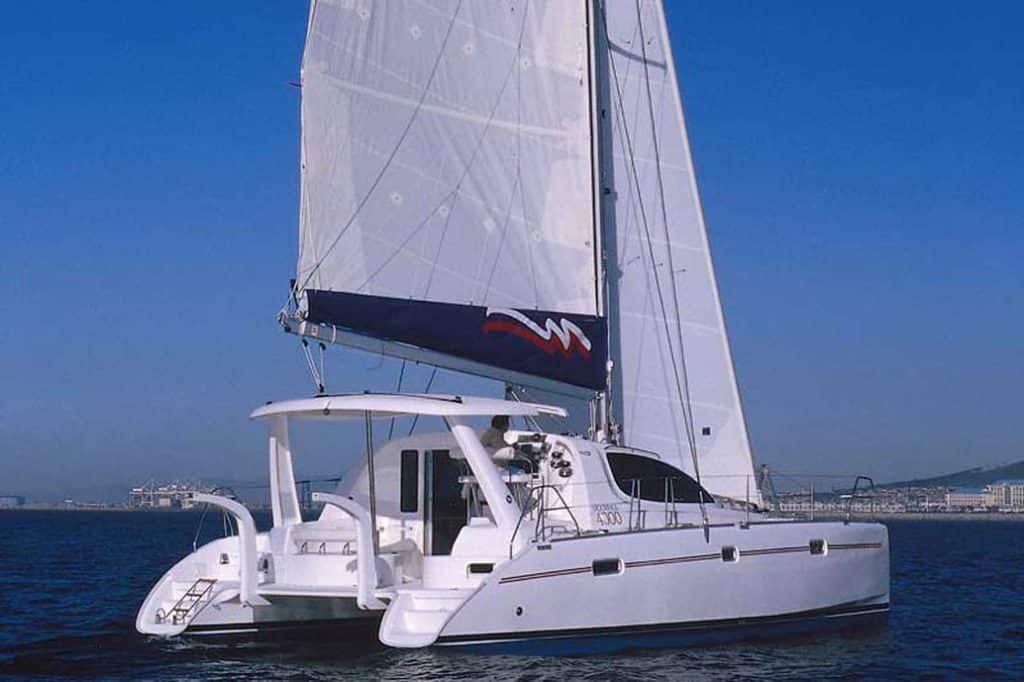
With an unmatched pedigree – designed by premier multihull naval architects Gino Morelli and Pete Melvin, built by the prestigious Robertson & Caine boatyard in South Africa, and commissioned by chartering giant The Moorings – the Leopard 40 was, perhaps unsurprisingly, Cruising World ’s Import Boat of the Year in 2005.
Louisiane 37
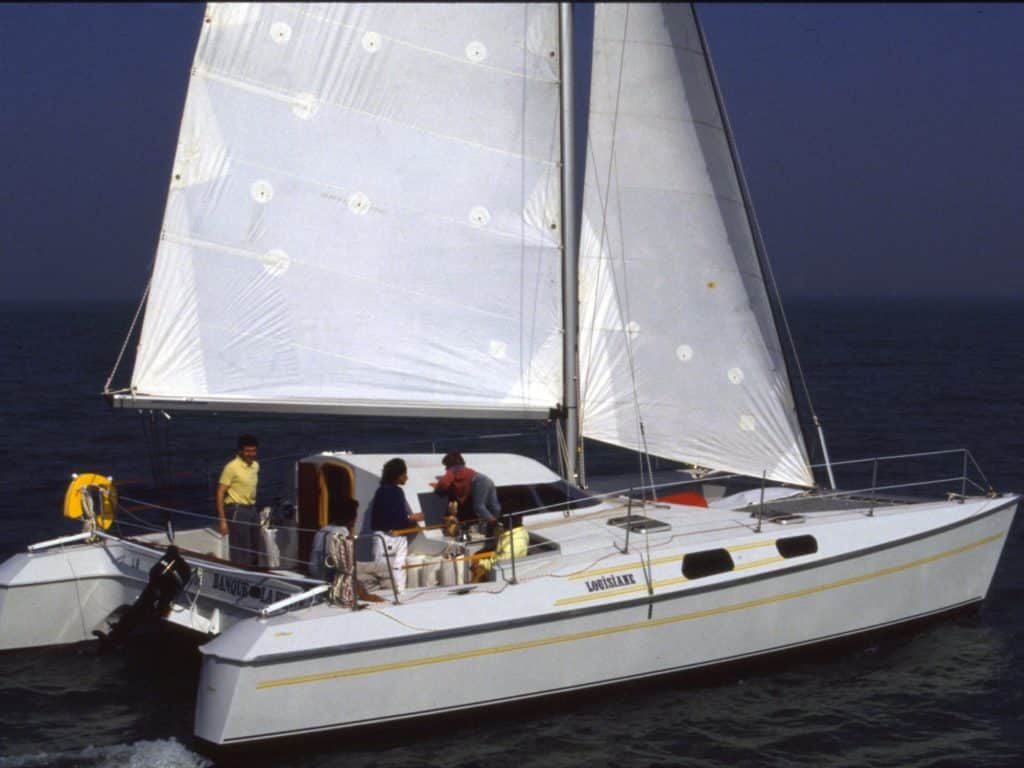
Based on the famous French racing cat Charente-Maritime, the Louisiane 37, designed by Joubert/Nivelt and launched by builder Fountaine-Pajot in 1983, was a light, fast liveaboard cruiser with full accommodations that represented a radical departure from the hefty British cats that preceded it.
Maine Cat 30
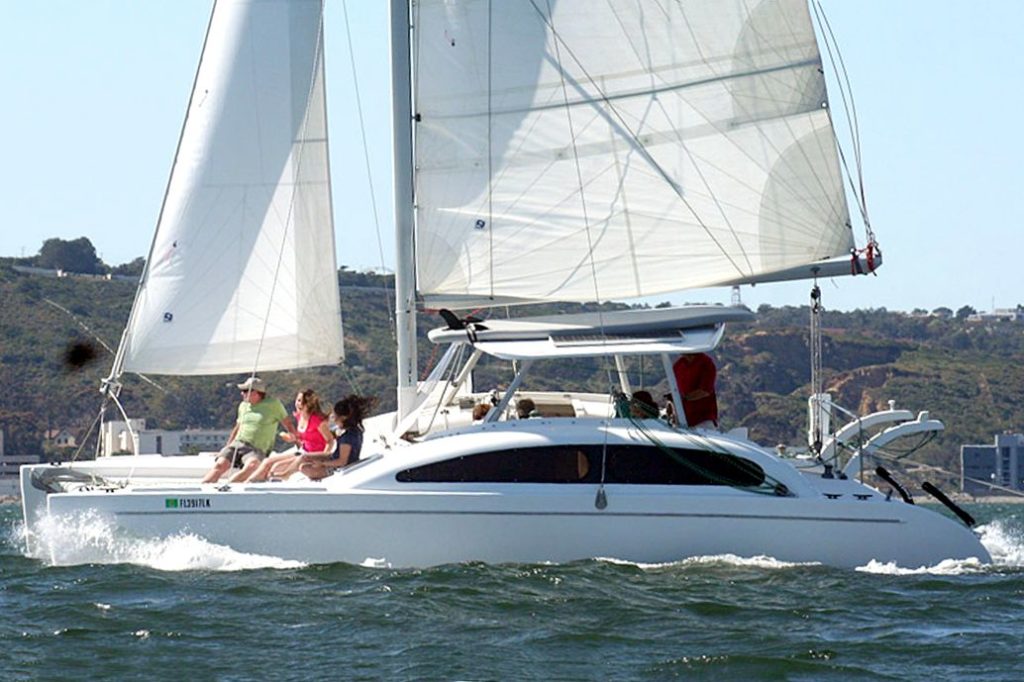
One of the more versatile and clever cats ever created, the central feature of the cool Maine Cat 30 is the open bridge deck/living room sandwiched between the hulls and canopied by a rigid, permanent hard top (the comfortable accommodations/ staterooms are stationed in the hulls). Ideal for a winter in the Bahamas but with the ability to sail offshore, it’s a boat for all seasons and reasons.
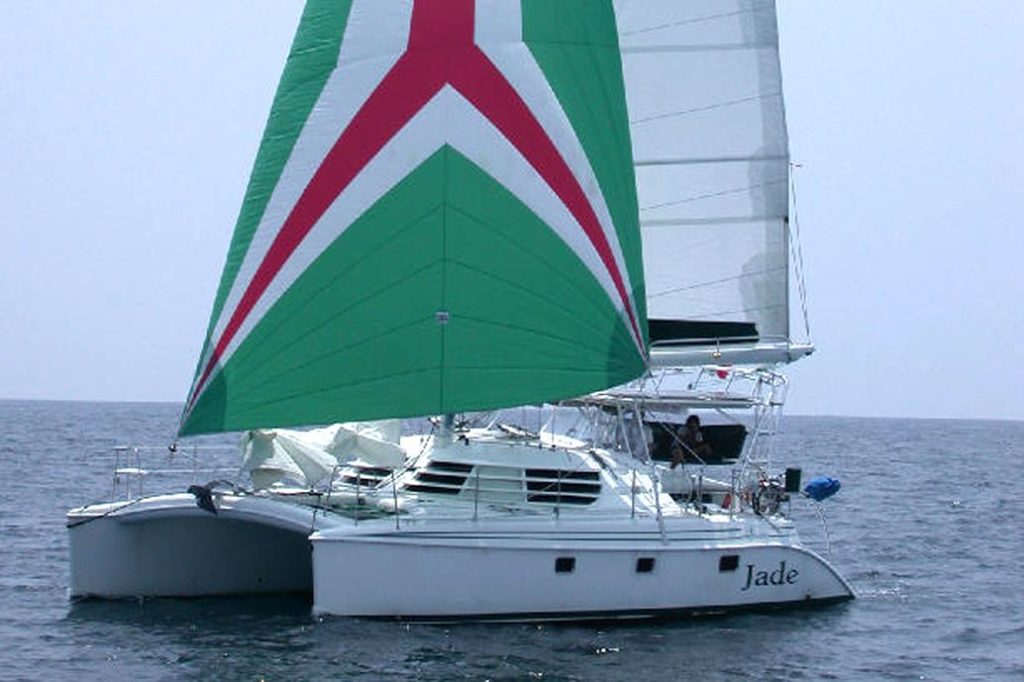
Built in Florida and beloved by the owners of the over 120 boats built during the company’s existence from 1993 to 2009, the Manta Catamarans range included 38-, 40- and 44-foot cats. For this exercise, however, we’re heralding the original Manta 42, which won the Best Value Overall prize in CW’s 2001 Boat of the Year contest.
Moorings 4800/Leopard 48
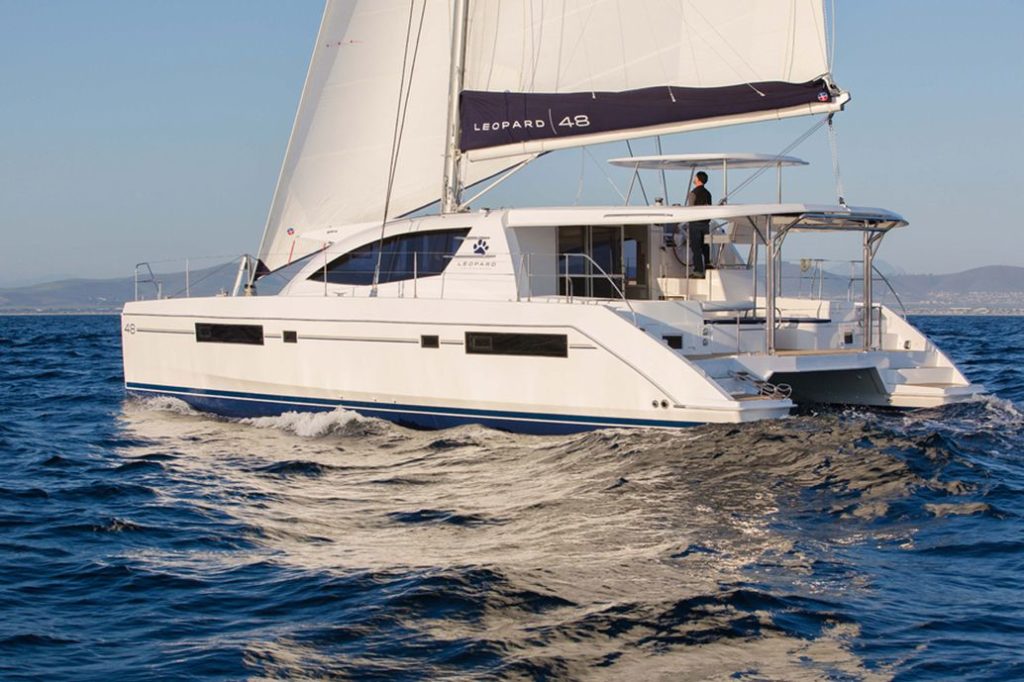
Another Leopard/Moorings collaboration built by the wizards at Robertson & Caine (though this boat was designed by fellow South African Alex Simonis), the Leopard 48 was another CW Boat of the Year winner with all the contemporary bells and whistles: forward cockpit, flybridge helm station and solid hardtop dodger, just to name a few.
Click here to read more about the Leopard 48, and click here to see more images.
Nautitech 441
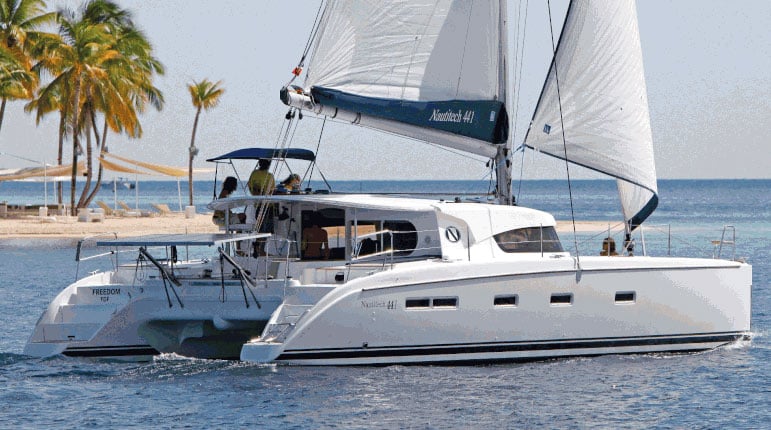
The Best Multihull Under 45 Feet: So said the CW judging panel in the 2013 Boat of the Year competition, regarding the Nautitech 441. But what makes this versatile platform so intriguing are the different helm set-ups. The 441 employs a single wheel, to starboard, ideal for solo sailors, while the 442 has a pair of helm stations aft.
Click here to see more Nautitech Catamarans.
Outremer 5X
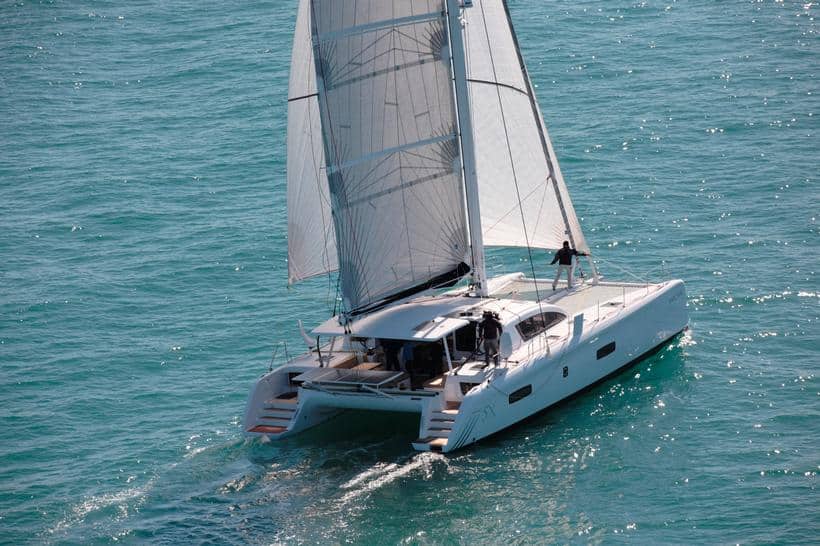
A state-of-the-art all-oceans cat that exemplifies how far multihull design has come, the 59-foot Outremer 5X was a winner on both sides of the Atlantic, taking top honors in the European Boat of the Year competition in 2013, and following up as the Best Full-Size Multihull in CW ’s contest a year later.
Click here to see more cats from Outremer.
St. Francis 50
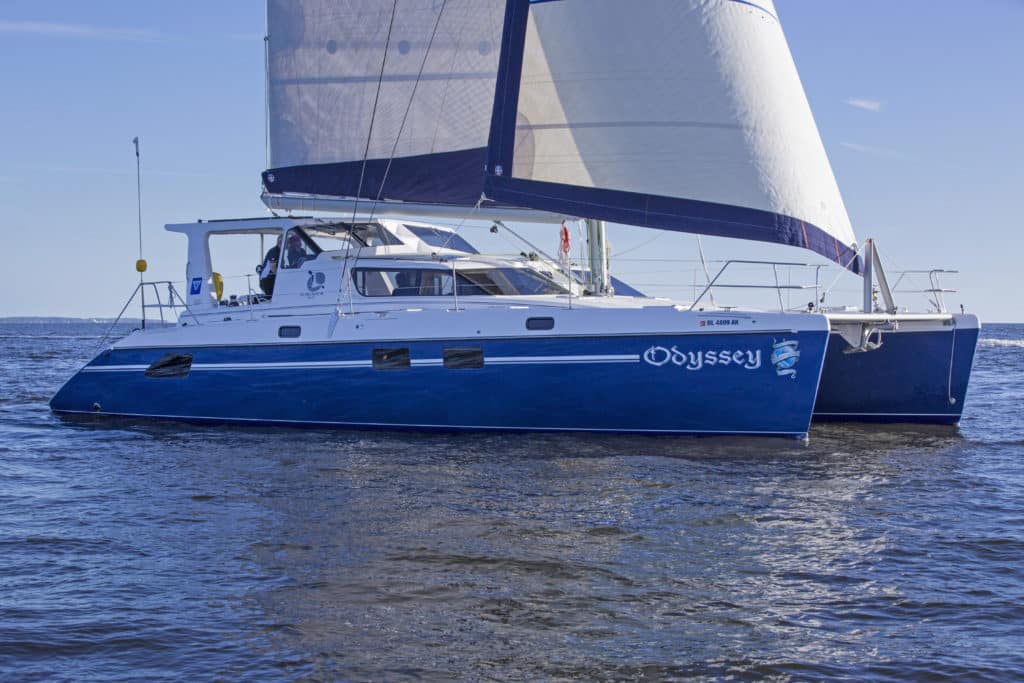
The flagship of the proud St. Francis line – built in South Africa since 1990 to designs by local legends Lavranos Marine Design – the St. Francis 50 is another “luxury cat” that shares much in common with an earlier 48-foot sister-ship, but packs even more payload into its roomier lines.
Click here to read more about the St. Francis 50
Seawind 1000
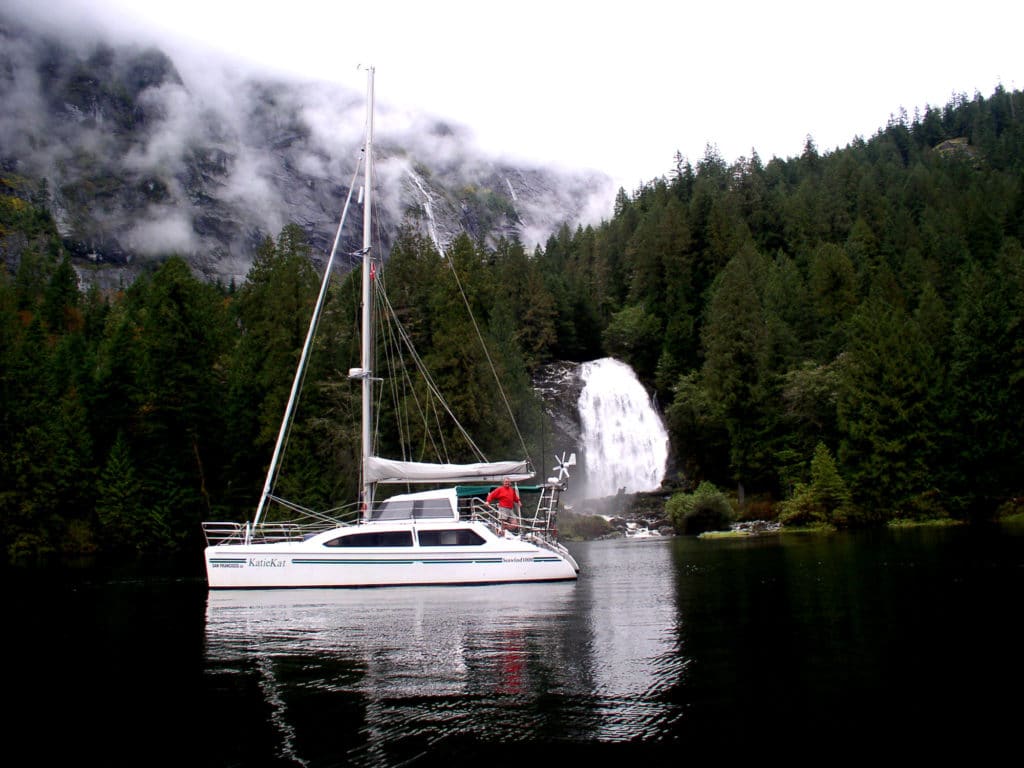
Founded by Aussie surfer and sailor Richard Ward in 1982, the 33-foot Seawind 1000 is easily the most popular cruising cat ever built in Australia (the company has since moved its manufacturing and management operations to Vietnam). Roomy and airy, these cats dot the coastline of eastern Oz.
Seawind 1160
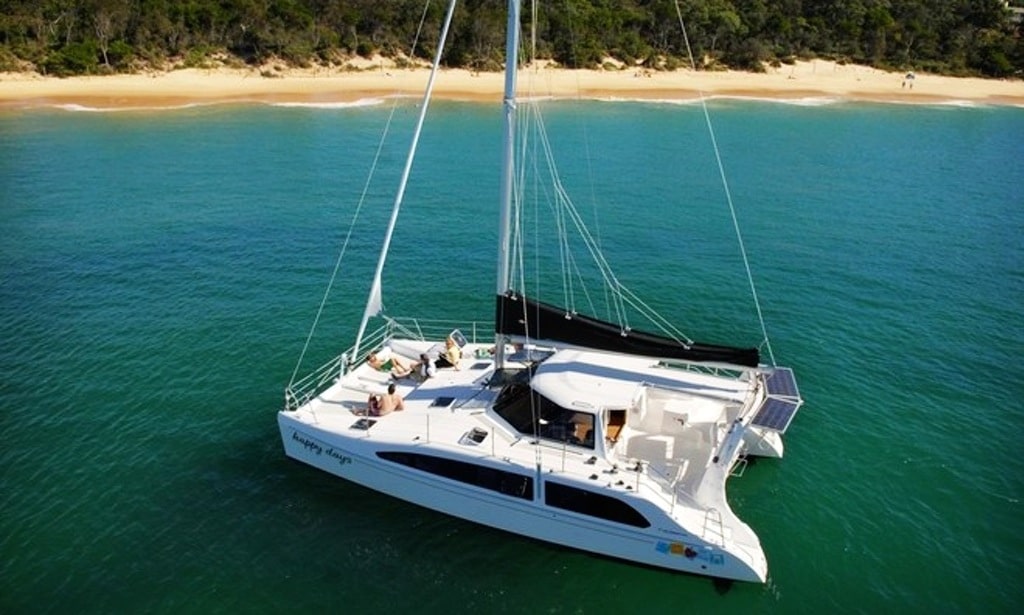
If the Seawind 1000 was a minimalist approach to cruising cats, the 38-foot Seawind 1160 is the flip side of the coin, a full-fledged long-range voyager. Among the reasons it was named CW ’s Most Innovative boat for 2007 is the unique “tri-folding” door that stashes overhead to open up the saloon and cockpit into a spacious living area.
Click here to read more about the Seawind 1160.
Sunsail 384
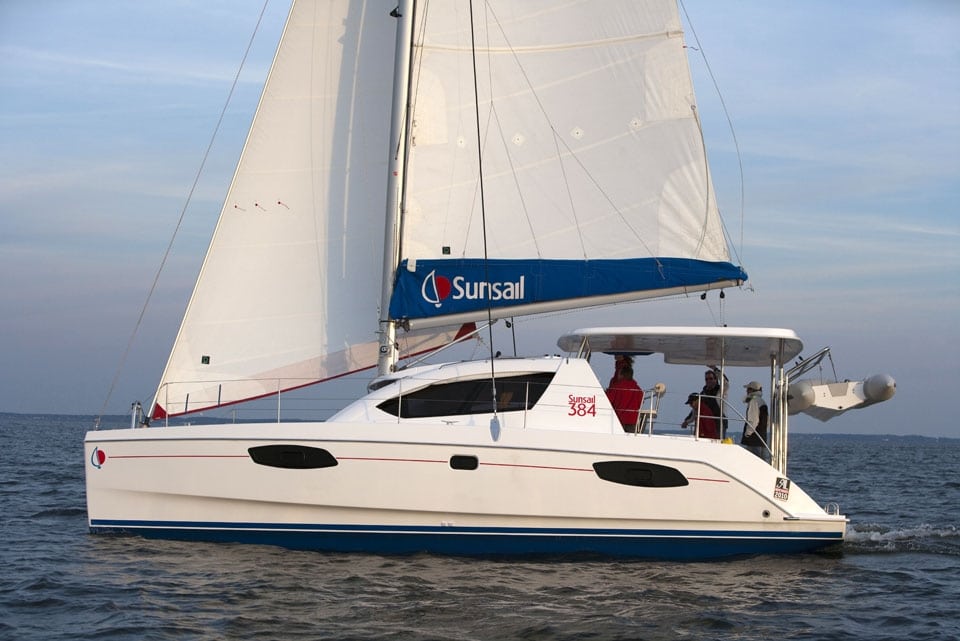
Every sailboat is a compromise, and in the case of the Sunsail 384 (also sold privately as the Leopard 38) that’s a good thing, because designers Morrelli & Melvin and builder Robertson and Caine got the balance just right with this relatively small catamaran. With four cabins, the 384 can carry the same size bareboat charter crowd as her larger siblings, but does so with a decided bounce in her step. Named CW’s Import Boat of the Year in 2010, you can gauge the success of the design by the grins on the crew as they barrel down Sir Francis Drake channel in the British Virgin Islands.
Victoria 67
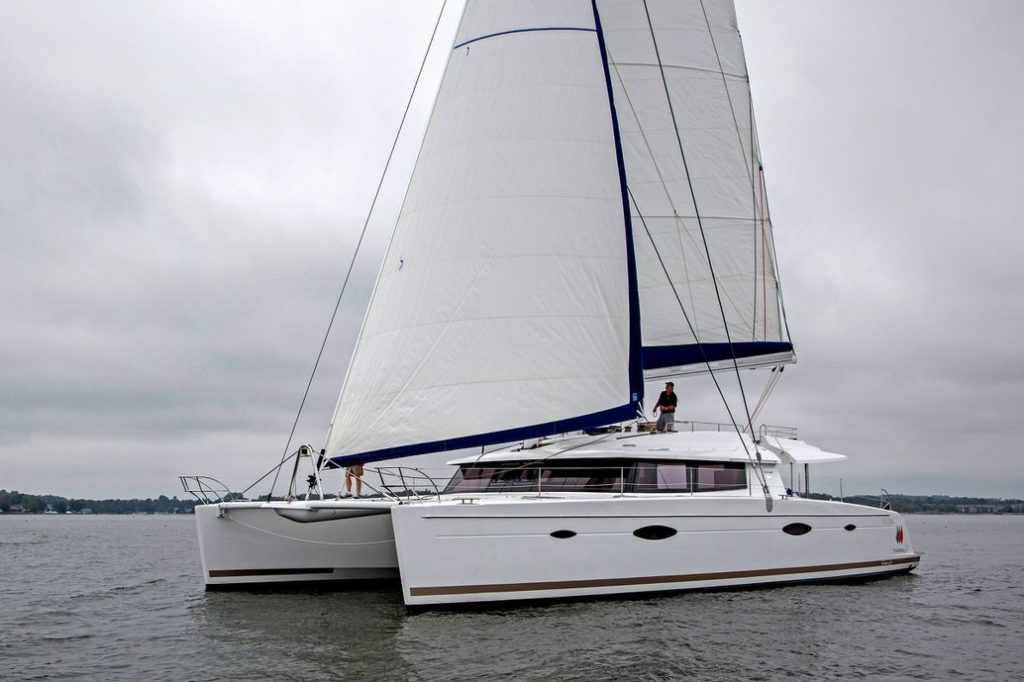
The French design office of Berret Racoupeau drafted the lines of Fountaine-Pajot’s new flagship, introduced in 2013, a magnificent world-girdling voyaging catamaran. Like other giant cats launched in recent years, the boat features a sensational upper deck with all sail controls, helm and lounging stations.
Click here to see more images of the Victoria 67.
Wharram Tanaroa
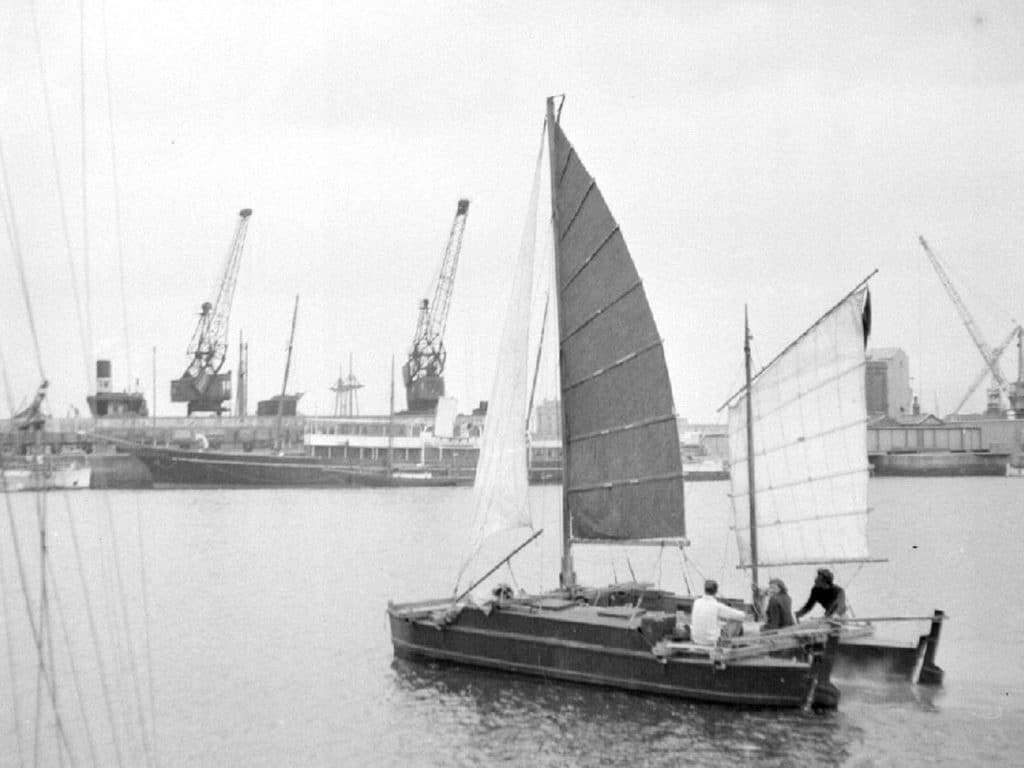
No list of influential multihulls would be complete without the work of James Wharram, and while Tangaroa wasn’t a production cat by any means, it showcases the British designer’s respect for ancient Polynesian craft. Wharram sailed this 23-foot-6-inch “double-hulled canoe” across the Atlantic in the 1950s, and sold countless plans for similar boats for decades afterwards.
- More: Boat Gallery , catamaran , multihull , Sailboat Reviews , Sailboats
- More Sailboats

Windelo 54 Named Multihull of the Year

For Sale: 2019 Lagoon 40

For Sale: 1983 Little Harbor 44

Sailboat Preview: ClubSwan 28 by Nautor Swan

Sailing Hall of Fame 2024 Inductees Announced

Selling My Soul? A Lifelong Sailor Dabbles in Diesel
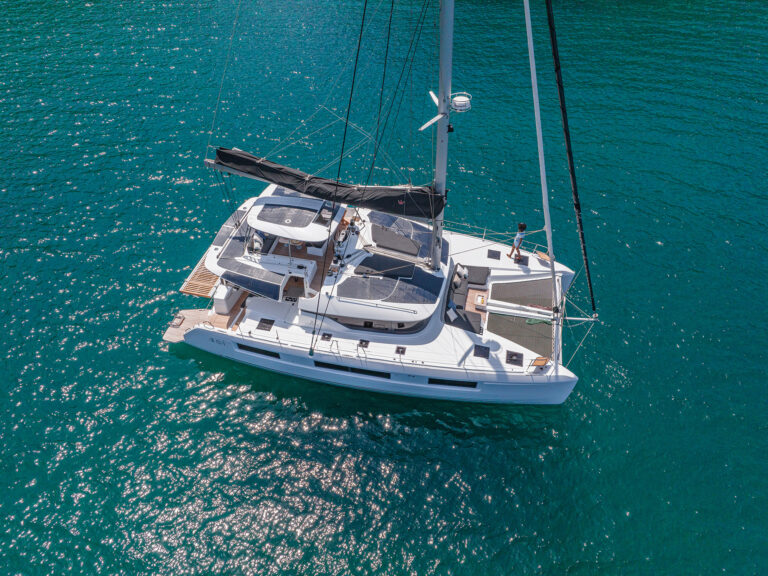
The Case for Multihulls
- Digital Edition
- Customer Service
- Privacy Policy
- Email Newsletters
- Cruising World
- Sailing World
- Salt Water Sportsman
- Sport Fishing
- Wakeboarding

Choosing the Perfect Size Catamaran for Your World Sailing Adventure
Alex Morgan
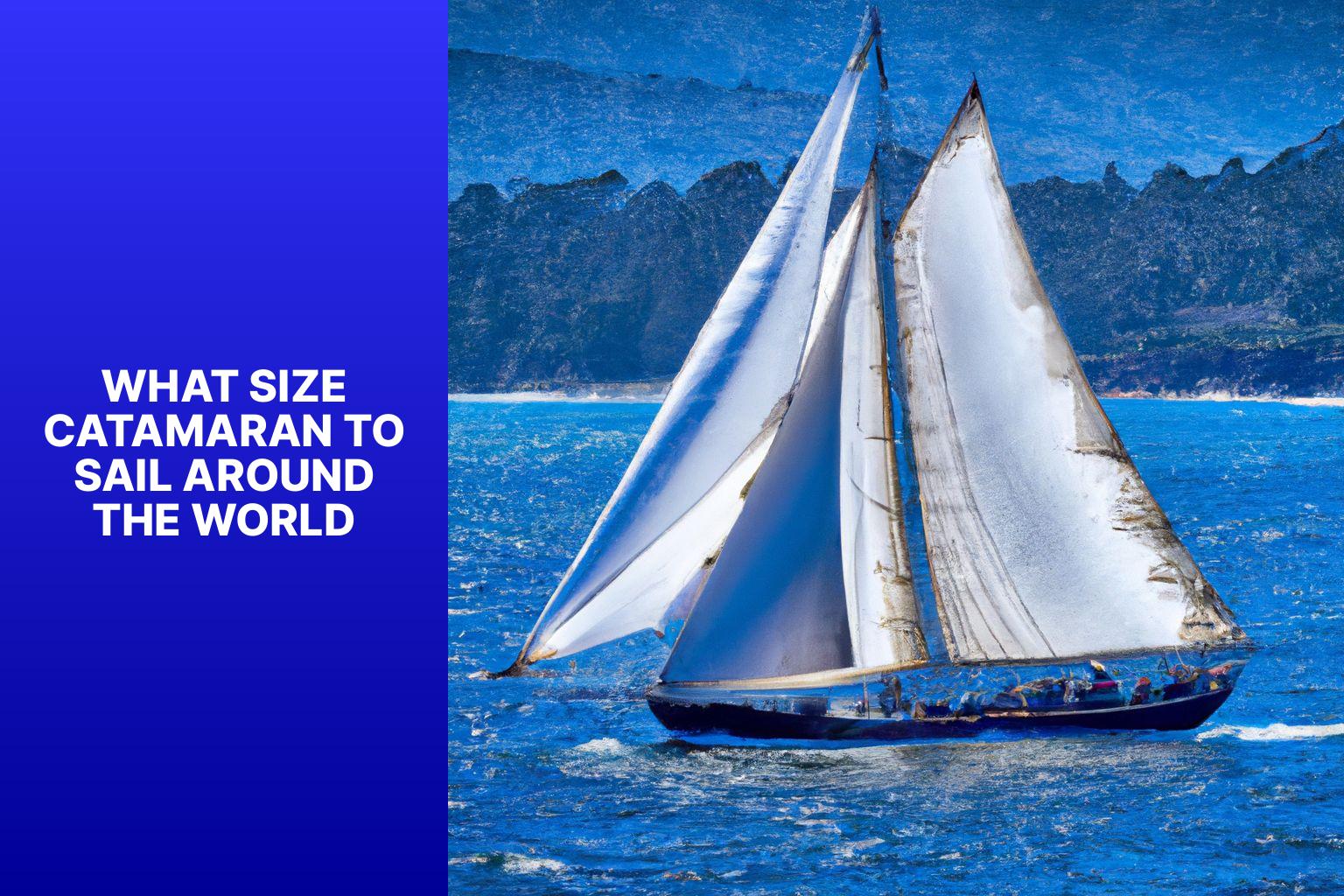
Sailing around the world is a dream for many adventurers, and choosing the right catamaran size is crucial for a successful and enjoyable journey. A catamaran, with its stability, spaciousness, and ability to navigate shallow waters, is an ideal choice for long-distance cruising. In this article, we will explore the factors to consider when selecting a catamaran size for sailing around the world and the options available. We will also discuss important features and considerations, including stability, storage capacity, sailing performance, crew requirements, and cost. personal considerations such as budget, sailing experience, comfort, and navigational plans will be taken into account. We will provide some valuable tips for preparing and sailing a catamaran around the world, including safety measures, navigational tools, provisioning, weather monitoring, and communication. Whether you’re a seasoned sailor or embarking on your first long-distance voyage, this guide will help you make an informed decision about choosing the right catamaran size for your global sailing adventure.
Key takeaway:
- Choosing the right catamaran size is crucial for sailing around the world. Factors like length, beam, draft, and displacement need to be considered.
- There are different size options available for catamarans, including small, medium-sized, and large ones, each with their own advantages and disadvantages.
- Features like stability, storage capacity, sailing performance, crew requirements, cost, and maintenance should be evaluated when selecting a catamaran size.
- Personal considerations such as budget, sailing experience, comfort, and navigational plans also play a significant role in determining the ideal catamaran size.
- Preparation for sailing a catamaran around the world involves safety equipment, navigational tools, provisioning, water management, weather monitoring, and communication.
Factors to Consider When Choosing Catamaran Size
When it comes to sailing around the world, choosing the right catamaran size is crucial. In this section, we’ll dive into the key factors to consider when making this decision. From the length and beam to the draft and displacement, each sub-section will uncover essential aspects that can impact your sailing adventure. So, let’s sail through these factors and discover the perfect catamaran size to conquer the open seas!
The length of a catamaran is important when choosing a vessel for sailing around the world. It affects the boat’s performance and functionality . Consider the table below that shows the different lengths of catamarans and their characteristics :
| Less than 40 feet | Smaller size allows for easier maneuverability and access to shallow areas. Increased agility during docking or anchoring. |
| 40 to 50 feet | Offers a balance between agility and living space. Provides sufficient room for amenities and storage while maintaining manageable handling. |
| More than 50 feet | Provides spacious accommodations and ample storage for extended voyages. Offers stability and comfort due to a larger hull surface area. |
When considering the length of a catamaran, it is essential to factor in personal preferences and needs. A longer catamaran may offer more space and stability but might be harder to maneuver in tight spaces. On the other hand, a shorter catamaran may offer better maneuverability but have limited space for amenities and storage.
Let’s share a true story about catamaran length. John , an experienced sailor, chose a 45-foot catamaran for his journey around the world. The moderate length allowed him to comfortably accommodate his family while still offering ease of handling. He appreciated the balance between agility and living space that the 45-foot catamaran provided, making his sailing adventure enjoyable and fulfilling.
When considering the size of a catamaran for sailing around the world, it is essential to take into account the beam . The beam , which refers to the width of the catamaran measured from one hull to the other, plays a crucial role in the stability and living space of the boat.
Smaller catamarans generally have a smaller beam , resulting in less spacious living quarters and potentially reduced stability. They compensate by being more maneuverable, and they also have lower initial costs and maintenance requirements.
For those seeking a balance between living space and stability, medium-sized catamarans with a moderate beam are an excellent choice. They are easy to handle, offer a good combination of living space and stability, and come at a reasonable cost in terms of both purchase and maintenance.
Large catamarans, with their wider beams , provide generous living spaces and enhanced stability. They may be slightly less maneuverable compared to smaller and medium-sized catamarans. They generally come with higher initial costs and maintenance requirements.
By considering your priorities regarding living space, stability, maneuverability, and budget, you can determine the appropriate beam size for your catamaran when embarking on a journey around the world.
When selecting a catamaran size for sailing around the world, the draft becomes a crucial consideration. The draft pertains to the vertical measurement from the waterline to the deepest region of the hull, including the keels or daggerboards.
– Opting for a shallower draft proves advantageous for navigating shallow bodies of water, such as coastal areas , lagoons , and coral reefs . A catamaran with a draft ranging from about 2 to 4 feet proves fitting for these particular conditions.
– A moderate draft achieves a desirable equilibrium between stability and performance . Catamarans with drafts ranging from 4 to 6 feet demonstrate versatility and aptitude in a broad array of sailing conditions.
– A deeper draft confers benefits in terms of improved upwind performance and stability amid rough seas. Catamarans with a draft of at least 6 feet emerge as a superior choice for offshore passages and ocean crossings.
– The draft of the catamaran also exercises influence on anchoring possibilities. A shallower draft allows for access to more shallow anchorages, whereas a deeper draft might necessitate anchoring farther from the shore.
Historical records illustrate the evolution of catamaran drafts over time. Early catamarans possessed comparably shallow drafts suited for coastal cruising. Nonetheless, advancements in design and technology facilitated the adoption of deeper drafts, thereby enhancing stability and performance. Presently, catamarans offer diverse draft options that cater to various sailing preferences and destinations.
Displacement
When choosing a catamaran for sailing around the world, one important factor is displacement . Displacement refers to the weight of the water a catamaran displaces when floating.
Size of Catamaran Displacement
Small 10,000 to 20,000 pounds
Medium-sized 20,000 to 40,000 pounds
Large 40,000 to 60,000 pounds
The displacement of a catamaran affects its stability and how it handles waves and rough weather. A catamaran with higher displacement will generally have better stability and a smoother ride in challenging conditions.
It is important to note that higher displacement also means a larger and heavier catamaran, which can impact maneuverability and sailing performance. Smaller catamarans with lower displacement may be easier to handle and more nimble.
Ultimately, the choice of catamaran size and displacement depends on personal preferences, experience, and sailing goals. Factors such as budget, comfort, and navigational plans should be considered when making a decision.
Catamaran Size Options for Sailing Around the World
When it comes to sailing around the world, choosing the right catamaran size is essential. In this section, we’ll discuss the different catamaran size options available for this grand adventure. From small catamarans designed for maneuverability to medium-sized ones offering a balance of comfort and speed, and finally, large catamarans ideal for luxurious long-distance voyages. Join us as we explore the world of catamarans and find the perfect vessel for your nautical journey of a lifetime.
Small Catamarans
When considering small catamarans for sailing around the world, keep in mind:
– Length: Small catamarans range from 30 to 40 feet . These compact sizes make them easier to handle and maneuver in tight spaces.
– Beam: The beam, or width, of a small catamaran is usually around 15 to 20 feet . This provides stability and ample space for living and storage.
– Draft: The draft, or depth, of a small catamaran is typically shallow, ranging from 2 to 4 feet . This allows for navigation in shoal waters and easy anchoring.
– Displacement: Small catamarans have a lighter displacement compared to larger ones, typically ranging from 8,000 to 12,000 pounds . This allows for increased speed and agility.
One true story highlights the benefits of small catamarans . John and Jane sailed around the world on their 35-foot catamaran . The compact size of their small catamaran allowed them to access remote anchorages and explore hidden coves that larger vessels couldn’t reach. The shallow draft of their small catamaran also allowed them to navigate safely through coral reefs and shallow lagoons. The smaller size made it more manageable for just the two of them to handle all aspects of sailing. Their small catamaran provided them with comfort, ease of handling, and the ability to explore off-the-beaten-path destinations.
Medium-sized Catamarans
When selecting a catamaran of medium size, it is important to take into consideration various factors. These factors include:
Length: Medium-sized catamarans are typically between 40 and 50 feet in length. This size provides a good balance between spaciousness and maneuverability.
Beam: Medium-sized catamarans have a beam measurement of approximately 22 to 25 feet. This width ensures stability, which is essential for long-distance cruising.
Draft: The draft of medium-sized catamarans usually ranges from 4 to 6 feet. This shallow depth enables versatile sailing in different locations.
Displacement: Medium-sized catamarans typically weigh between 15,000 and 25,000 pounds. This weight range offers a harmonious combination of speed and comfort.
When making a decision on a medium-sized catamaran, it is crucial to consider your specific needs and preferences. Factors that should be taken into account include budget, living space requirements, and navigational plans. By thoroughly assessing these factors, you will be able to find a medium-sized catamaran that perfectly aligns with your sailing aspirations, no matter where in the world you wish to explore.
Large Catamarans
Large catamarans are the perfect choice for those looking to sail around the world. These magnificent vessels offer a plethora of advantages. They provide an abundance of living and storage space, ensuring utmost comfort during long journeys. Furthermore, large catamarans exhibit excellent stability even in rough seas, making them a safer option for extended offshore sailing .
Let’s take a look at a table that compares some key features of large catamarans :
Large catamarans are particularly suitable for individuals who prioritize space , comfort , and stability . It is crucial to consider the specific needs and preferences of the crew. For instance, a larger crew may be required to handle the size and complexity of a large catamaran .
Fun fact: Large catamarans often boast advanced navigation systems and modern amenities such as spacious cabins, lounges, and entertainment areas. These luxurious features provide sailors with an unparalleled experience while exploring the vast oceans of the world.
Catamaran Features and Considerations
When it comes to choosing the right catamaran for sailing around the world, understanding the key features and considerations is crucial. In this section, we’ll dive into the factors that can make or break your journey. From the stability that ensures a smooth ride to the storage capacity for all your essentials, we’ll cover it all. Plus, we’ll explore the catamaran’s sailing performance, crew requirements, and the cost and maintenance involved. Get ready to set sail with confidence!
Stability is important when choosing a catamaran for sailing around the world. A stable catamaran provides a comfortable and safe experience on long ocean passages. Here are some important points to consider:
1. Hull design: Look for catamarans with a wider beam for better stability. A wider beam offers a solid foundation and reduces the chances of capsizing.
2. Weight distribution: Proper weight distribution is crucial for stability. A well-balanced catamaran has evenly distributed weight across both hulls, ensuring stability at anchor and underway.
3. Center of gravity: The height of the center of gravity plays a significant role in stability. A lower center of gravity enhances stability, making the catamaran less prone to rolling in rough seas.
4. Bridge deck clearance: Bridge deck clearance is the distance between the bottom of the bridgedeck and the water. Sufficient clearance reduces the chances of ‘slamming’ when encountering waves, improving stability.
5. Wave-piercing bows: Some catamarans have wave-piercing bows that cut through waves instead of riding over them. This design can help enhance stability and reduce pitching in rough conditions.
Pro-tip: Find the right balance between stability and performance. While a highly stable catamaran is comfortable, it may sacrifice speed and maneuverability. Evaluate your sailing goals and prioritize stability accordingly.
Storage and Capacity
When considering storage and capacity on a catamaran, factors to take into account include:
- Storage Space: Evaluate the available storage space for belongings, provisions, and equipment.
- Cargo Capacity: Consider the maximum weight capacity for supplies, fuel, and water.
- Cabin Layout: Assess the number and size of cabins to ensure enough sleeping space.
- Deck Space: Consider the usable deck space for lounging, socializing, and storing equipment.
- Accessibility: Check if storage areas are easily accessible and secure against rough weather.
- Weight Distribution: Ensure even storage space distribution for stability and performance.
A true story highlights the importance of storage and capacity. A couple on a world sailing adventure underestimated their storage needs. The limited space caused inefficiency and frustration. This taught them the valuable lesson of considering storage and capacity for a smooth sailing experience.
Sailing Performance
Sail Area: The sail area of a catamaran greatly impacts its sailing performance, allowing for higher speeds and improved maneuverability in various wind conditions. The larger sail area provides better control and enhances the overall performance of the catamaran.
Hull Design: The design of the catamaran’s hull plays a critical role in optimizing its sailing performance. A sleek and streamlined hull reduces drag, enabling the catamaran to achieve faster speeds and increased efficiency during sailing.
Weight Distribution: Proper weight distribution is essential to ensure optimal sailing performance . A well-balanced catamaran with the correct weight distribution between the hulls maximizes stability and speed, ensuring smooth and efficient sailing .
Rigging and Sail Controls: The rigging and sail controls have a significant impact on the catamaran’s sailing performance. Efficient systems for adjusting sail shape, tension, and trim enable better control and enhance overall performance on the water.
Keel and Daggerboard: The keel or daggerboard on a catamaran provide stability and prevent lateral drift. The design and positioning of these components affect the catamaran’s ability to sail upwind and greatly influence its overall performance.
Fact: A well-designed and properly maintained catamaran can reach speeds of up to 25 knots or more , making it an ideal choice for those seeking exhilarating sailing performance on their journeys around the world.
Crew Requirements
When considering crew requirements for sailing a catamaran around the world, several factors need to be taken into account. These factors include experience, skills, physical fitness, teamwork, and emergency training.
A crew with sailing experience is important, especially for long-distance journeys. Crew members should have a good understanding of navigation, seamanship, and boat handling. Each crew member should possess the necessary skills for tasks like sailing, cooking, maintenance, and repairs. It is beneficial to have a diverse skill set within the crew.
Sailing around the world requires physical endurance , as crew members may need to perform physically demanding tasks, especially in challenging weather conditions or when handling sails. A harmonious and cooperative crew is essential for a successful voyage. Good communication, problem-solving skills, and the ability to work together as a team are crucial.
All crew members should be familiar with emergency procedures and have undergone appropriate safety training, including knowledge of life-saving equipment, man-overboard drills, and first aid. Ensuring that the crew meets these requirements contributes to a safe and enjoyable sailing experience around the world.
Cost and Maintenance
When considering the cost and maintenance of a catamaran for sailing around the world, keep in mind the following factors:
1. Initial cost: Catamarans can range in price from $100,000 to several million dollars, depending on size, brand, and condition.
2. Insurance: The cost of insuring a catamaran can vary based on factors such as boat value, navigational area, and owner’s experience.
3. Maintenance and repairs: Regular maintenance, including hull cleaning, engine servicing, and sail inspections, is required for catamarans. The cost of these tasks can add up over time.
4. Fuel: The cost of fuel for a catamaran can vary depending on the size and type of engines. Consider fuel consumption when budgeting for long-distance sailing.
5. Marina fees: Catamaran owners often have to pay mooring or berthing fees when docked in marinas. The cost can differ depending on location and facilities available.
Considering the cost and maintenance of a catamaran is crucial when planning to sail around the world. It is recommended to calculate a realistic budget that takes into account not only the initial purchase price, but also ongoing expenses. Research and obtain quotes for insurance, understand the cost of regular maintenance and repairs, and factor in fuel and marina fees to ensure a smooth and enjoyable sailing experience without any financial surprises.
Personal Considerations for Choosing Catamaran Size
When it comes to choosing the right catamaran size for sailing around the world, there are a few personal considerations to keep in mind. From budget and financing to sailing experience and skill level, comfort and living space, as well as navigational plans and destinations, each aspect plays a crucial role. So, let’s dive in and explore how these factors can influence the decision-making process and ensure a smooth and enjoyable voyage.
Budget and Financing
When selecting a catamaran for sailing around the world, it is essential to consider budget and financing. Here are some key factors to keep in mind:
1. Initial Cost: Take into account the total expense of buying a catamaran, including any customizations or upgrades.
2. Maintenance and Upkeep: Remember to think about the ongoing costs associated with maintaining and repairing the catamaran, such as regular inspections, hull cleaning, engine maintenance, and equipment replacement.
3. Insurance: Factor in the cost of insurance, which can vary based on the size and value of the catamaran, as well as your sailing experience.
4. Mooring and Marina Fees: Plan for the expenses related to docking the catamaran at marinas or moorings. Fees may vary depending on the location and duration of your stay.
5. Operating Costs: Set aside a budget for fuel, water, provisions, and other day-to-day expenses while sailing. Consider the length of your planned voyage and the destinations you intend to visit.
6. Financing Options: Take the time to explore different financing options, such as loans or lease agreements, to determine the most suitable and affordable way to acquire a catamaran.
Pro-tip: Prior to finalizing your budget, conduct thorough research on the used catamaran market. Purchasing a used catamaran can result in significant cost savings compared to buying a brand new one. Consider joining sailing forums or communities to gain insights from experienced sailors on how to optimize your budget and financing for your sailing adventure.
Sailing Experience and Skill Level
When selecting the appropriate size of a catamaran for sailing around the world, it is important to take into account your level of experience and skill when it comes to sailing. There are several factors to consider:
1. Previous sailing experience: It is crucial to assess your experience in sailing, including the types of boats you have sailed and the amount of time you have spent on the water. This will help determine the level of expertise needed to navigate a larger catamaran effectively.
2. Handling capabilities: Your ability to maneuver and handle a larger vessel needs to be taken into consideration. It is generally more challenging to handle larger catamarans, as they require advanced sailing skills.
3. Crew size and expertise: If you will be sailing with a crew, it is important to evaluate their experience and skill level as well. A larger catamaran may require a more experienced crew to manage the additional responsibilities that come with it.
4. Comfort level: Think about your comfort while sailing. Smaller catamarans are often more agile and easier to handle, especially in more challenging weather conditions.
It is crucial to objectively assess your sailing experience and skill level to ensure a safe and enjoyable sailing experience. Consider enrolling in sailing courses or gaining more experience before attempting to sail a larger catamaran around the world.
Comfort and Living Space
When considering the comfort and living space of a catamaran for world sailing, several important factors come into play. Cabin and common area size are crucial to ensuring a comfortable experience for everyone on board. It is important to find a catamaran with spacious cabins that can comfortably accommodate the number of people on board. The size of the saloon and cockpit should be taken into consideration for socializing and relaxing.
Layout and design also play a significant role in creating a comfortable living space on a catamaran. It is essential to look for a well-designed catamaran that maximizes space and provides separate areas for sleeping, dining, and lounging. Features such as multiple heads (bathrooms) and ample storage space should also be considered.
Ventilation and natural light are important for creating a comfortable environment on a catamaran. Good airflow is essential, so it is necessary to check for sufficient windows, hatches, and ventilation systems to keep the interior well ventilated and filled with natural light.
Stability and motion at sea are crucial for a comfortable sailing experience. A stable catamaran design provides a smoother ride and reduces the risk of seasickness. It is advisable to consider a catamaran with a wide beam and low center of gravity for enhanced stability and comfort while underway.
Comfort features greatly contribute to the overall enjoyment of a catamaran. Amenities such as a spacious galley, comfortable seating areas, and a well-equipped entertainment system enhance comfort and relaxation.
Personal preferences should also be taken into account when choosing a catamaran for comfort and living space. Some individuals may prioritize a larger master suite, while others may value outdoor living areas like a spacious flybridge or aft deck.
Ultimately, choosing the right catamaran size for comfort and living space depends on factors such as the number of people on board, personal preferences, and budget. Seeking advice from experienced sailors and visiting and inspecting different catamaran models can help in finding the one that best meets individual needs.
It is important to remember that comfort and living space are crucial for enjoying a journey around the world on a catamaran. Taking the time to assess requirements and finding a catamaran that offers the ideal balance of comfort and functionality is essential for a successful sailing adventure.
Navigational Plans and Destinations
When considering navigational plans for sailing around the world, it is important to take into account factors such as distance, weather conditions, and amenities at ports. When creating your navigational plans, make sure to consider the following key points:
– Distance: It is crucial to determine the length of your journey and plan your route accordingly. Take into consideration the travel time between destinations and ensure that you have enough provisions for the duration of the trip.
– Weather conditions: Research the weather patterns in the areas where you plan to visit. Make note of storm seasons or extreme weather conditions in order to avoid any risks.
– Ports and marinas: Identify the ports and marinas along your route that can accommodate the size of your catamaran. Make sure that they have the necessary facilities and services such as fueling stations, repair facilities, and provisions.
– Attractions and activities: Consider the attractions and activities available at each destination. Choose destinations that align with your interests, whether it be pristine beaches, diving or snorkeling opportunities, or cultural experiences.
– Cultural considerations: It is important to take into account the local culture and customs of the destinations you plan to visit. Show respect for protocols and regulations in order to have a positive experience.
Pro-tip: It is advisable to keep a flexible itinerary and be open to adjusting your navigational plans if needed. Adaptability can enhance your overall sailing experience around the world.
Tips for Preparing and Sailing a Catamaran Around the World
Preparing and sailing a catamaran around the world requires meticulous planning and attention to detail. In this section, we’ll discover valuable tips that can enhance your journey. We’ll cover essential aspects such as safety and emergency equipment, navigational tools and charts, provisioning and water management, weather monitoring and predictions, and communication and connectivity. From ensuring your safety to optimizing your resources, we’ll provide insights to make your catamaran adventure a success.
Safety and Emergency Equipment
When sailing a catamaran around the world, it is vital to prioritize the safety and well-being of the crew by ensuring the presence of essential safety and emergency equipment on board. Here are some crucial items to consider:
- Life jackets: Each crew member should have a properly fitting, easily accessible life jacket in case of an emergency, ensuring their personal safety.
- First Aid Kit: A well-stocked kit containing bandages, antiseptics, and medications is indispensable for promptly addressing injuries or illnesses while at sea.
- EPIRB: An emergency position-indicating radio beacon (EPIRB) functions as a distress signal device, enabling swift alerting of rescue services to your precise location during an emergency situation.
- Fire extinguishers: Strategically placing fire extinguishers on the catamaran allows for efficient management of onboard fires, ensuring the safety of the vessel and its occupants.
- Flares: Hand-held and parachute flares serve as crucial signaling devices for seeking assistance when in distress on the water.
- Emergency rations and water: It is of utmost importance to have an ample supply of emergency rations and potable water on board to sustain the crew during prolonged emergencies or unexpected loss of supplies.
Always remember that prioritizing safety is paramount while sailing. Possessing proper safety and emergency equipment significantly enhances the ability to handle emergencies successfully.
In 2013, the Vendée Globe yacht race witnessed a harrowing incident involving sailor Alex Thomson , whose catamaran collided with an unidentified submerged object, resulting in its capsize. Fortunately, Thomson’s meticulous adherence to safety protocols and the presence of necessary emergency equipment proved crucial. He promptly activated his EPIRB, wore a life jacket, and safely abandoned the sinking vessel. By being prepared and utilizing the available safety and emergency resources, Thomson was ultimately rescued by a passing ship and managed to survive the ordeal. This true account serves as a poignant reminder of how proper safety measures and the presence of appropriate emergency equipment are indispensable when embarking on sailing journeys.
Navigational Tools and Charts
Navigational Tools and Charts play a crucial role in sailing a catamaran. They ensure safe and efficient navigation, helping sailors plot courses, track positions, and avoid hazards. Here is a table showing the essential navigational tools and charts:
Charts are essential visual references for sailors, providing detailed information about coastlines, water depths, and navigational aids. Sailors should carry appropriate charts for their sailing area. Common chart types include:
Pro Tip: Regularly update charts and ensure the reliability of navigational tools to maintain accuracy and improve safety during your catamaran journey.
Remember, proper use of navigational tools and charts contributes to a successful and enjoyable sailing experience.
Provisioning and Water Management
One crucial aspect of sailing a catamaran around the world is provisioning and water management . It is essential to plan and prepare adequately for a smooth journey.
– Create a detailed list of necessary provisions , including non-perishable food items , cooking ingredients , and toiletries . – Take into account dietary restrictions and preferences when stocking up on food supplies. – Consider the storage space available on the catamaran and utilize it effectively for provisioning. – Prioritize long-lasting and easily storable food items to minimize the need for frequent resupply. – Keep track of expiry dates and rotate food supplies regularly to maintain freshness and prevent spoilage.
– Estimate the amount of freshwater required for the voyage, considering the number of crew members and the duration of the journey. – Install efficient water storage tanks and consider implementing a watermaker to generate freshwater from seawater. – Monitor water usage throughout the journey, promoting responsible consumption to conserve valuable freshwater resources. – Familiarize yourself with water treatment techniques to ensure the safety and quality of the onboard water supply. – Plan for potential contingencies by carrying additional jugs of freshwater or researching freshwater sources at various destinations.
Proper provisioning and water management are vital for the success of a catamaran journey around the world. By carefully considering and planning for these factors, sailors can ensure they have the necessary resources for their voyage and enjoy a safe and comfortable experience.
Fun Fact: A typical crew of four will require approximately 2-3 liters of freshwater per person per day for drinking and cooking during a long-term sailing trip.
Weather Monitoring and Predictions
Weather monitoring and predictions play a vital role in navigating a catamaran around the world. It is crucial to stay updated about weather conditions to ensure safe navigation.
To achieve this, it is important to regularly check weather forecasts from reputable sources such as meteorological agencies or weather routing services. These forecasts provide valuable information on wind patterns, storm systems, and ocean currents.
Equipping yourself with onboard weather monitoring systems is also essential. These systems provide real-time data on important factors such as wind speed , atmospheric pressure , and sea surface temperature . By having access to this information, you can make informed decisions regarding route planning and avoid adverse weather conditions.
Utilizing advanced technology is another key aspect of effective weather prediction. By utilizing advanced weather prediction models and satellite imagery, you can anticipate and track weather patterns. This knowledge allows you to plan sailing routes accordingly, avoiding heavy storms or dangerous weather conditions.
Having redundancy in receiving weather information is also critical. It is advisable to have backup means such as satellite phones or long-range radios in case of equipment failure or limited connectivity.
Seeking professional advice is highly recommended. Consult experienced sailors or weather experts who specialize in oceanic weather conditions. Their knowledge and expertise can provide valuable insights and guidance.
It is important to remember that weather conditions at sea can change rapidly. Therefore, prioritizing safety and adjusting the route if necessary is crucial. By closely monitoring weather patterns and making informed decisions, you can minimize risks and enjoy a smooth sailing experience around the world.
Here’s a fun fact: Sailors have relied on weather signs and natural indicators since ancient times to predict weather conditions. These indicators include observing clouds , wind patterns, and animal behavior .
Communication and Connectivity
When sailing a catamaran around the world, reliable communication and connectivity are crucial for staying connected with the outside world and ensuring safety. Cellular and satellite communication systems play an important role in staying connected, even in remote areas. These systems allow for voice calls , text messages , and internet access .
A working VHF radio and a valid operator’s license are essential for communication with other boats, marinas, and emergency services. On top of that, having Wi-Fi and internet access on board allows sailors to stay connected with family and friends, access weather updates, and perform online research. Navigation systems , including GPS , chart plotters , and radar systems , are also necessary for safe navigation and efficient communication with other vessels.
In case of emergencies, it is important to have emergency beacons such as EPIRBs and SARTs on board. These devices can send distress signals and help search and rescue teams locate the boat. Having a satellite phone as a backup communication device is advisable if cellular networks are not available or unreliable.
Having reliable communication and connectivity systems on a catamaran ensures that sailors can stay in touch with loved ones, receive important updates, and call for help if needed during their journey around the world.
The perfect size catamaran for sailing around the world is between 37 to 47 feet long.
- ✅ Smaller catamarans have limited living space and cargo capacity, while larger ones are more expensive and difficult to handle.
- ✅ Catamarans shorter than 30 feet usually do not have cabins and are not suitable for open sea sailing.
- ✅ A catamaran needs to be well-equipped and have enough space for a crew and provisions for ocean-crossing voyages.
- ✅ Catamarans between 40 and 45 feet are the average size for ocean-crossing and offer more space and amenities.
- ✅ Catamarans have a high freeboard, reducing the risk of being washed over by large waves.
Frequently Asked Questions
What is the ideal size of a catamaran to sail around the world.
The recommended size range for a catamaran to embark on an around-the-world voyage is typically between 37 to 47 feet long. This size provides a good balance between living space, cargo capacity, and manageable handling.
Are smaller catamarans suitable for sailing around the world?
Smaller catamarans can still be used for world cruising if you adopt a minimalist lifestyle and stay light with your equipment and supplies. They have limited storage space for necessary provisions such as food and water.
Are larger catamarans better for long-distance voyages?
While larger catamarans offer enhanced levels of comfort and amenities, handling a bigger boat requires more skill and may require additional crew. Expenses increase with boat length, and bigger boats may face extra charges for services and marina slips.
What are the advantages of sailing around the world in a catamaran?
Some advantages of catamaran circumnavigation include speed, comfort in rough weather, safety, extra storage space, room for more passengers, larger living spaces, and a shallow draft, which allows for easy beaching and access to shallow waters.
How do catamarans compare to monohull sailboats for circumnavigation?
Catamarans are generally considered a better choice for circumnavigation compared to monohulls due to their stability, spaciousness, and comfort in rough weather. It’s important to note that the ideal choice ultimately depends on individual needs and preferences.
Where can I find catamarans for sailing around the world?
You can find catamarans suitable for sailing around the world through various sources such as boat shows, catamaran manufacturers, online listings, and yacht brokerage firms like Simpson Marine. They offer new and preowned yachts and catamarans for all budgets and usage plans, along with services like yacht management, design, and refit.
About the author
Leave a Reply Cancel reply
Your email address will not be published. Required fields are marked *
Save my name, email, and website in this browser for the next time I comment.
Latest posts

The history of sailing – from ancient times to modern adventures
History of Sailing Sailing is a time-honored tradition that has evolved over millennia, from its humble beginnings as a means of transportation to a beloved modern-day recreational activity. The history of sailing is a fascinating journey that spans cultures and centuries, rich in innovation and adventure. In this article, we’ll explore the remarkable evolution of…

Sailing Solo: Adventures and Challenges of Single-Handed Sailing
Solo Sailing Sailing has always been a pursuit of freedom, adventure, and self-discovery. While sailing with a crew is a fantastic experience, there’s a unique allure to sailing solo – just you, the wind, and the open sea. Single-handed sailing, as it’s often called, is a journey of self-reliance, resilience, and the ultimate test of…

Sustainable Sailing: Eco-Friendly Practices on the boat
Eco Friendly Sailing Sailing is an exhilarating and timeless way to explore the beauty of the open water, but it’s important to remember that our oceans and environment need our protection. Sustainable sailing, which involves eco-friendly practices and mindful decision-making, allows sailors to enjoy their adventures while minimizing their impact on the environment. In this…
Yachting World
- Digital Edition
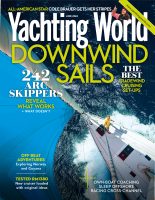
The best bluewater multihulls of all time: a complete guide
- Toby Hodges
- October 6, 2021
Toby Hodges and François Tregouet consider the best bluewater multihulls and look at the options for sailing the oceans in spacious comfort

What are the best bluewater multihulls for long term cruising? The one you own, or the one you can afford is the simple answer.
There is a wealth of proven designs to suit bluewater sailing and a variety of budgets. While we have focussed here on the best bluewater multihulls in production, we’ve also included some cracking pedigree multihulls which tour the planet and might occasionally pop up on the brokerage market.
If you can afford to, then pushing towards the 45-50ft length will buy you space, pace and that extra payload capacity needed to take all the items you’d want on your home afloat.
When looking at the best bluewater multihulls, the choice will come down to that perennial balance between comfort/space and speed/weight. Choosing a lighter weight performance design will obviously help you cover distance voyages more rapidly and potentially allow you to outrun weather systems. It means you can sail faster, with less sail up and less load and stress. But you’ll have to sacrifice some luxuries and need to be quite scrupulous about keeping weight down and centralised in order to maintain high average speeds.
For the majority of cruisers, however, it is the amount of space multihulls offer once you’ve reached your destination that really appeals. As well as the non-heeling living area and real estate they provide, they’re well suited to typical tradewind sailing .
If you’re considering your first or next multihull, we hope the following will serve as a taster.
Best bluewater multihulls for performance cruising
Outremer 51/55.
When you think of multihulls designed for bluewater cruising, Outremer will likely be one of the first names that comes to mind. Its heritage lies in building catamarans that can sail fast and are built strong enough to do laps of the globe.
The 51, the current version of which launched three years ago, is an archetypal example of what to look for in terms of blending speed and space is a dream design for a family circumnavigation.
The French yard’s new 55ft VPLP design may look boldly different from its past models, but the philosophy behind it remains the same. It is designed to match windspeed up to 12 knots and Outremer reasons that its ability to sail in 5 knots of breeze will allow it to sail for 95% of the time on a circumnavigation.
Read more about the Outremer 51 and Outremer 55.

Photo: Diego Yriarte
Seawind 1600/1370
For nearly four decades the Australian Seawind brand and its founder Richard Ward have been gearing catamarans around safe bluewater sailing, including performance, protection and ease of handling. Its Reichel Pugh-designed 1600, which launched three years ago, is an elegant looking cat with relatively low, long lines and some smart solutions for fast bluewater sailing.
Seawind also launches its new 1370 later this year, a staggering 60 of which have sold on plans alone.
This first 50 is built from a composite sandwich of basalt fibre, a cloth made from volcanic rock, and PET foam from recycled plastic bottles, which helps to reduce carbon emissions by nearly 50% when compared with traditional glassfibre methods.
This new 50 footer is perhaps a more appealing and practical prospect than Rapido’s previous 60 (with its significant fixed beam), particularly as the amas on this new model can fold to reduce beam to 18ft.
Infused carbon foam sandwich construction is used, along with beams, daggerboards and rudder in pre-preg carbon to keep displacement to 8,200kg.
Read more about the Rapido 50
This OC50 is designed as a more affordable cruising alternative, than the HH models which have preceeded it. This model targets ocean sailing.
It’s still stiffened and strengthened by carbon, but built in vinylester composites with a gelcoat finish. This adds an additional 300kg or so over a full carbon HH50, but cost savings are in the region of $400,000.
Read more about the HH OC50
Balance 526
The 526 launched four years ago, designed to suit short-handed sailors and families looking to sail long distances, hence it can carry large payloads and promises easy maintenance. It looks good too.
Berman’s Versahelm design is a key feature. The wheel cantilevers, allowing the helmsman to steer from outboard with clear sightlines or from the hardtop protection of the aft cockpit.

Photo: Christopher White
Atlantic 47
The A47 suits short-handed fast ocean sailing at an approachable size. Lengthening it to 49ft allowed for an aft cockpit. It is available as a sloop or with White’s patented MastFoil ketch rig – rotating aerofoil masts designed for easy short-handed cruising without sacrificing performance.
Read more about the Atlantic 47
A combination of sharp design from François Perus and high build quality brings plenty of appeal to this sporty Italian-built cat. The first example launched three years ago with a light displacement of 10.5 tonnes, thanks to an E-glass epoxy-infused build with carbon strengthening. The yard offers semi-custom construction and full hybrid packages.
Catana 53/Ocean class 50
Catana’s performance model from 2017, sports twin aft helms (which may not suit ocean sailors), reverse bows and carbon daggerboards. The high topsides help create good bridgedeck clearance and plenty of accommodation. Its new Ocean Class 50 seems more in the shipyard’s bluewater DNA. The light weight, and dynamic and modern shape with slim hulls and a relatively short nacelle suggests a seaworthy nature and high speeds.
Read more about the Catana 53
Best bluewater multihulls for pedigree performance
Veteran multihull designers Morrelli & Melvin designed this smaller model for the Gunboat range. It was built to be more manageable for an owner-driver yet still capable of up to 300-400 mile days.
The Gunboat 48 is something of a rare breed, just six 48s were built between 2004 and 2009. Oh, to have a spare €1.3m right now… one of them is actually on the market.
Read more about the Gunboat 48
At the start of the Millennium, Catana offered fully equipped boats as standard for long distance cruising. The Catana 471 or 472 (one or two helms respectively), represented at the time the optimum in ocean-going catamarans.
Chincogan/Lightwave
Tony Grainger has been drawing fast multihulls for 35 years, including racing trimarans and the Lightwave and Chincogan cruisers. The popular Lightwave 38 has admirable performance and comfort, and the Chincogan 52 (pictured) has the length to clock high average speeds.
Outremer 45 G. Danson
With its characteristic roof, narrow hulls and daggerboards, the Outremer 45 is a standout design which has become somewhat iconic. Despite a rather spartan interior, it has been a great success with fast cruising enthusiasts. On board, family ocean crossings at an average of 10 knots are the norm.
Best bluewater multihulls for family cruising

Photo: Nicolas Claris
The Lagoon 450 remains the most popular model in Lagoons already popular range. It exemplifies the VPLP/Nauta design partnership which has made these the very definition of modern mid-size cruising catamarans which can appeal to families and charterers alike.
Indeed the 450 marked the modern look of Lagoon and was the first with interior styling from Nauta. It originally launched over a decade ago as a flybridge design with central helming position (450F), before this ‘sport top’ option (450S) was offered with a starboard helm station and lower boom.
Read more about the Lagoon 450

Photo: Guilain Grenier
Fountaine Pajot Saona 47
The 47 has a modern shape, with straight bows and a reverse sheer line. It incorporates significant volume in the hulls below the bridgedeck to create room for the optional athwartships cabins. Cabin space is a prime selling point, particularly the owner’s suite to port, where there is also abundant natural light and headroom.

Photo: Tui Marine
Leopard Catamarans, together with designer Simonis Voogd and builder Robertson and Caine, produce the archetypal dual-purpose owner-operator or charter boat in their modern catamaran range.
Key features of the 45 are the amount of light in the saloon and the incredible volume and space on offer in the cabins above the relatively narrow waterlines. Vast social living areas include the flybridge, saloon and dual cockpits.
Read more about the Leopard 45

Photo: www.jfromero.fr

Nautitech Open/Fly 46
During the 1990s and noughties Nautitech earned a good reputation for its elegant catamarans. The 441 is a timeless example and the 44 can be credited with the ongoing trend in hardtop biminis. While its acquisition by Bavaria seven years ago helped Nautitech implement industrial build techniques, the French brand has retained its DNA at its Rochefort sur Mer yard.
The modern Marc Lombard designs have tall rigs with generous square-top mainsails. Twin wheels in the aft quarters of the Open 46 offer a direct feel on the helm, however those spending long periods in the tropics may prefer the shade of the bimini-equipped flybridge option. The layout is also open, with a saloon more outside than in. Styling is clean, modern and simple, and the standard of build and finish are good.

Photo: Olivier Blanchet
First impressions of the Neel 51 are sure to centre on its sheer size and space inside. But as you’ll see from our review of the Neel 43 on page 83, when you sail one overriding impressions quickly centre on its performance.
These trimarans are becoming a popular mass production-built option.

Photo: Christophe Launay
The Excess 11 packs plenty of potential as the smallest yacht offered by the big production yards. A little like the Lagoon 380 of old, it presents a good value new entry-level boat for genuine cruising in a more sporty, modern and enticing design. Some may argue against aft helms for ocean sailing, but those coming from monohulls will appreciate the more direct steering they offer.
Broadblue 385S
Broadblue is a UK brand which offers a distinct line of cruising and Rapier performance catamarans. Its staple 385 packs a lot of cruising comfort into its length, including generous tankage, and has been sailed all over the world. Broadblue built its first electric drive catamaran 12 years ago and offers the only all-electric production sailing catamaran under 40ft in Europe.

Photo: Christophe Breschi
Bali Catspace
For those looking for maximum volume within 40ft, it’ll be hard to beat the Catspace – although it is more of a holiday apartment than a traditional bluewater cruiser. Bali’s garage style sliding aft door does help offer an enormous amount of enclosed (or open) living space.
Best bluewater multihulls for luxury cruising

Photo: Nico Krauss
Privilège 510 Signature
The 510 is designed to take a serious amount of cruising gear – up to six tonnes of it in fact. The excellent helm station now has a fixed windscreen and all lines lead to hand. Finish quality including the electrical installation is first class and Privilege’s trademark, an admirable full beam (26ft) forward cabin, is sumptuous.

Photo: Jérôme Houyvet
Garcia Explocat 52
Garcia Yachts has cornered the market for series-built aluminium monohulls and multihulls in the last decade and this new Explocat 52 is sparking real interest. We ran a full test report in our February issue, describing it as a go-anywhere cat with an enticing combination of space, pace and rugged construction.
Read our review of the Garcia Explocat 52
Built in Argentina, the Antares 44 is the ultimate evolution of a model launched 21 years ago. Entirely dedicated to bluewater cruising, it is the yard’s only model and is constantly being improved according to owner feedback.
Time seems to have no hold on this boatyard and, against the trend, the standard equipment of the Antares 44 is extremely complete

Photo: Richard Langdon
Discovery Bluewater 50
This luxury Bill Dixon design may be a decade old now and into its third iteration, but the concept behind its original appeal remains. For those used to sailing high-end thoroughbred monohulls, here is an option to consider for a comparative level of build quality and fit out when moving to a multihull.
Read more about the Discovery Bluewater 50
St Francis 50 MKII
With this latest version of its original model, this experienced South African builder has optimised a catamaran cut out for the unforgiving seas of the Indian Ocean and the South Atlantic. The MKII allows for an increased load capacity, an important point in long distance cruising.
Xsquisite X5
Intelligent features on the X5 include the protected helm station with glass windscreen, integrated rainwater catcher, UV-protective glass and generous tankage.
Best bluewater multihulls for size & speed
Mcconaghy mc52.
The MC50 (now MC52) was the first and promises some high speed sailing, but it’s the open plan main living deck which will attract the majority. It incorporates an intelligent centreboard system, which hardly affects interior space, but arguably its exposed helms at the aft end of the flybridge will not suit serious ocean cruising.

Photo: Florian H. Talles
HH in Xiamen is building some really impressive large, luxury fast cats up to 90ft. This was its second model to launch, a high-end, high performance Morelli & Melvin design capable of rapid passagemaking speeds and enjoyable regatta sailing. Features include C-shaped boards and central or aft helms.

Photo: Mike Jones/Waterline Media
Ocean Explorer 60
If Nautor’s Swan made catamarans, they may look like this… The Ocean Explorer 60 uses the same designer in German Frers and some of the same builders who worked at the famous Finnish yard to produce this world cruiser. The resultant quality shines through. A new OE72 is due soon.
Kinetic KC54
A young company with plenty of experience, Kinetic produces custom fast ocean cruisers, which can occasionally race. Its 62 is a serious performance vessel with carbon hulls, rigs and rigging, daggerboards or centreboards. With fast bluewater cruising the goal, carbon is used to minimise weight so features/toys can still be added. The swim platform and hardware on the newly launched 54 weighs just 90kg, and the generous sized tanks are all in carbon too. Views from the saloon and forward cockpit also look special.
Best bluewater multihulls for ultimate performance
Marsaudon ts4/orc 42.
Few catamaran builders produce genuine performance cruisers at this ‘smaller’ size: this one is kept minimalist and light weight (around 6 tonnes) – the yard’s philosophy is ‘simplicity, then add lightness.’ The 42 is a cruiser-racer with the ability to outpace most yachts across the Atlantic, win a regatta and still offer some space for island hopping. Standard tankage is minimal however. Marsaudon recently rebranded its TS range to Ocean Rider Catamarans (ORCs) and has an ORC 57 in build.
Dazcat 1495
Dazcat builds fast, seaworthy cats from its Multihull Centre in Cornwall. The 1495 is a true ocean cruiser-racer, which is stiff and rewarding to sail, with direct steering linked to carbon rudders. The 1495 can hit 20+ knot speeds with relative ease, but it is the consistent high average speeds which will attract those looking to cover serious miles. Weight is centralised including engines, tanks, and systems all located amidships to help reduce pitching. Dazcat has a semi-custom build approach and creates all sorts of weird and wonderful craft for all abilities.
Dragonfly 40
Dragonfly trimarans are known for their high quality construction and ability to delight sailors with their ease of planing speeds. For those who can live without the space of similar length cats, the new flagship 40 is large enough to offer cruising space, while folding outriggers and retractable appendages mean you can dry out where others wouldn’t dare.
Looping 45/Freydis 48
These two designs by Erik Lerouge both offer a high-performance vision of ocean cruising. The Loopings were built individually and the Freydis in small series, and on both you can sail as fast as the wind in complete safety. Interior quality depends on whether finished by an amateur or by a shipyard.
Swisscat 48
An attractive combination of luxury, comfort and performance, the S48 is a stiff, go-anywhere premium cat that is easy to manage single-handed. The lightweight build (11t) is in epoxy infusion with carbon reinforcement.
Schionning Designs
Jeff Schionning has catamaran design in his blood. His designs exude performance and seaworthiness with flowing, even aerodynamic lines. On all tradewind routes you’ll find a G-Force (models from 12m to 23m) or an Arrow (12m to 15m) sailing more quickly than the rest. His latest venture is with Current Marine in Knysna, South Africa.
Best bluewater multihulls for pedigree cruising
The long-time best-seller from the world leader in catamarans, with more than 1,000 produced over almost 20 years from 1999. With its characteristic vertical windows, the 380 and its big brother the 410 made the purists scream when they were presented. But the 380 proved a pioneer of its kind. Safe bow volumes and light displacement (7,260 kg) helped its seaworthy behaviour. The high number of boats on the market makes this the most affordable bluewater cruising multihull for its size, even if price range is as wide as condition is variable.
Casamance 44/46
Between 44ft and 46ft depending on the year of construction and the length of its transoms, the Casamance was an impressive catamaran on launch in 1985. The design by Joubert/Nivelt offered good volume and load capacity. Of the 490 units produced, many joined the charter fleets. The exterior of the Casamance is dated, but the interior in grey ceruse oak has retained plenty of charm.
If you enjoyed this….
Yachting World is the world’s leading magazine for bluewater cruisers and offshore sailors. Every month we have inspirational adventures and practical features to help you realise your sailing dreams. Build your knowledge with a subscription delivered to your door. See our latest offers and save at least 30% off the cover price.
RetireFearless
Best Catamarans To Sail Around The World
Sailing the world on a catamaran is a dream for many, but it can be hard to know where to start. So, what are the best catamarans to sail around the world?

October 17, 2023
This article may contain affiliate links where we earn a commission from qualifying purchases.
It's no secret that sailing the world is a bucket list item for many people. But between the cost and the logistics, it can feel impossible to make this dream a reality.
The Lagoon 42 is known for its comfortable interiors and large outdoor spaces. The Astréa 42 from Fountaine Pajot is another great option for those looking for a spacious boat. Finally, the Nautitech 44 is a great choice for those who want a catamaran with all the bells and whistles.
Sailing the open seas on a catamaran is a dream for many people. There is something about the tranquility and freedom of being out on the water that just calls to us. If you have ever dreamed of sailing around the world, now is your chance. In this article, we will discuss some of the best catamarans to sail the high seas.
We spent countless hours researching the best catamarans for sailing around the world. We considered factors like price, comfort, and space in our decision-making process. In the end, we narrowed it down to three boats that we believe are the best of the best.
Table of Contents
1. Lagoon 42
The Lagoon 42 Catamaran is a sailing vessel that is designed for both comfort and performance. The catamaran features two hulls that are connected by a central platform, which provides ample space for both relaxation and recreation. The Lagoon 42 is also equipped with a large sail, which makes it ideal for both long-distance cruising and racing.
In addition, the catamaran is equipped with a state-of-the-art navigation system, which ensures that the vessel remains on course even in the most challenging conditions. As a result of its impressive design and capabilities, the Lagoon 42 Catamaran is one of the most popular sailing vessels on the market today.
This catamaran is designed for cruising and features a large main salon, four en-suite staterooms, and plenty of outdoor living space. The vessel features a large aft deck, which is perfect for entertaining or relaxing in the sun. In addition, the catamaran has a flybridge, which provides ample space for sunbathing or enjoying the views. With its sleek lines and modern design, the Lagoon 42 is sure to turn heads when out on the water.
The Lagoon 42 is constructed with a high-quality fiberglass hull and deck. The hull is designed to provide both strength and durability, while the deck is built for comfort and style. In addition, the catamaran features an aluminum beam that runs along the length of the vessel, which adds to its overall strength and stability.
The interior of the Lagoon 42 is both stylish and functional. The main salon features a large dining table, comfortable seating, and plenty of storage space. The galley is equipped with all of the amenities that you would need for long-term cruising, including a refrigerator, stove, oven, and microwave. The four staterooms are spacious and feature en-suite bathrooms, which provide added privacy and convenience.
One of the best things about the Lagoon 42 Catamaran is that it provides a comfortable and enjoyable ride no matter what the conditions are like. Whether you're sailing in calm waters or rough seas, you can be confident that this vessel will provide a smooth and stable ride. Additionally, the catamaran's large sail makes it easy to catch the wind and reach high speeds.
When it comes to performance, the Lagoon 42 does not disappoint. This catamaran is designed to provide a smooth, stable ride, even in rough conditions. The vessel is also equipped with a powerful engine, which allows it to reach speeds of up to 20 knots. In addition, the Lagoon 42 features a self-tacking jib and furling mainsail, which make it easy to sail and maneuver. As a result of its impressive performance, the Lagoon 42 is a popular choice for both racing and cruising.
While the Lagoon 42 comes standard with many features that will appeal to luxury boat buyers, there are also some drawbacks to consider. For example, the price of this catamaran can be quite high, especially if you opt for all of the available extras. Additionally, because it is a larger boat, the Lagoon 42 can be difficult to handle if you are not an experienced sailor.
Our Two Cents
If you are looking for a luxurious and feature-rich catamaran, the Lagoon 42 should definitely be at the top of your list. This vessel offers everything that luxury boat buyers could want, including ample space, a sleek design, and impressive performance. However, keep in mind that the Lagoon 42 comes with a hefty price tag. Additionally, make sure that you have the necessary experience to handle this catamaran before making your purchase.
- Price: $450,000-$650,000
- Length: 42 ft
- Displacement: 26455 lbs
- Fuel Tank Capacity: 79.3 gals
- Engine power: 45 Hp
- Luxurious and feature-rich
- Sleek design
- Spacious interior
- Impressive performance
- Difficult to handle if you are not an experienced sailor.
2. Fountaine Pajot Astréa 42
The Fountaine Pajot Astréa 42 is a luxury catamaran that was unveiled at the 2018 Cannes Yachting Festival. The Astréa 42 is the latest model in Fountaine Pajot's Astrea range of catamarans, and it features a number of upgrades from the previous model. The most notable changes include an increased overall length of 42 feet and a wider beam of 25.6 feet. The Astréa 42 also has an improved layout, with a more spacious cockpit and flybridge. The catamaran is powered by twin Volvo Penta engines, and it has a maximum speed of 27 knots. The Astréa 42 is available in three different layouts, and it can accommodate up to 10 guests.
One of the best things about the Fountaine Pajot Astréa 42 is its spaciousness. The boat has a wide beam, and this makes it feel very roomy both inside and out. There is plenty of space in the cockpit for relaxing or entertaining, and the flybridge offers even more room to enjoy the views. The Astréa 42 also has a large swim platform, which is perfect for swimming or fishing. Another great feature of this catamaran is its fuel efficiency. The Volvo Penta engines are very efficient, and they help to keep operating costs down.
The Fountaine Pajot Astréa 42 is a luxurious catamaran that is perfect for both families and couples who are looking for a sophisticated vessel that can take them on the vacation of a lifetime. The Astréa 42 has been carefully designed with both comfort and style in mind, and its build quality is second to none. The hulls are made from GRP (glass reinforced plastic), and the deck is constructed from teak, which gives the boat a beautiful natural finish. The Astréa 42 is also equipped with a state-of-the-art satellite navigation system and a wireless internet connection, making it easy to stay connected even when you're out at sea.
Like any boat, the Fountaine Pajot Astréa 42 has its pros and cons. One of the main advantages of this catamaran is its size. The Astréa 42 is significantly larger than most monohulls, and this makes it perfect for families or groups of friends who want to enjoy plenty of space on their boat. Another great thing about the Astréa 42 is its fuel efficiency. The Volvo Penta engines are very efficient, and they help to keep operating costs down. One of the drawbacks of this catamaran is that it doesn't have a lot of storage space. This can be an issue if you're planning on going on a long cruise, as you may need to bring along extra supplies. The boat is quite large, and this can make it difficult to dock in some marinas.
The Fountaine Pajot Astréa 42 is a very stable boat, and it performs well in both calm and rough conditions. The hulls are made from GRP (glass reinforced plastic), which makes the boat very strong and durable. The keels are also quite deep, which provides good stability even in strong winds. The Astréa 42 is equipped with twin Volvo Penta engines, and these provide plenty of power for cruising at high speeds. However, the boat does use a lot of fuel when running at full speed, so it's important to keep this in mind if you're planning on going on a long cruise.
Is the Fountaine Pajot Astréa 42 the perfect catamaran for cruising? It depends on what you're looking for in a boat. If you want a large and spacious catamaran that is perfect for families or groups of friends, then the Astréa 42 is a great option. However, if you're looking for a smaller and more fuel-efficient boat, then you may want to consider another option. Overall, the Fountaine Pajot Astréa 42 is a well-built and stylish catamaran that is perfect for those who are looking for a luxurious vessel to take them on the vacation of a lifetime.
- Price: $450,000-$700,000
- Length: 41 ft 4 in
- Displacement: 27999
- Fuel Tank Capacity: 124.2 gal
- Engine Power: 2x30 HP
- Fuel efficient
- Great aesthetics
- Modern amenities
- Limited storage space
- Uses a lot of fuel at high speeds
3. Nautitech 44
The Nautitech 44 Catamaran is a vessel designed for both pleasure and utility. Though its initial purpose was to be a comfortable live-aboard cruising catamaran, it has since been used in a variety of different ways. The Nautitech 44 Catamaran is easily recognizable by its twin hulls, which provide both stability and ample space. It is this stability that makes the catamaran ideal for fishing, as well as other activities that require a steady platform.
In addition to its utility, the Nautitech 44 Catamaran is also known for its comfort and luxury. The vessel features large windows and an open layout, providing panoramic views and plenty of natural light. It also includes a spacious flybridge, perfect for relaxing in the sun. Whether you're looking for a vessel to take you on an adventure or simply wanting to enjoy the good life, the Nautitech 44 Catamaran is sure to please.
The Nautitech 44 Catamaran is a popular choice for both experienced sailors and first-time boat owners. Its twin-hull design provides exceptional stability, making it ideal for cruising in rough waters. The spacious deck and cockpit are perfect for entertaining, and the well-appointed interior features plenty of storage and comfortable accommodations.
The Nautitech 44 Catamaran is powered by twin 40 horsepower engines. It also includes a 110-volt generator, making it ideal for extended stays at anchor. The catamaran has a fuel capacity of 105 gallons and a water capacity of 210 gallons. It also features a holding tank for waste. The Nautitech 44 Catamaran is designed for both speed and comfort. Its hull shape and twin engines allow it to reach speeds up to 20 knots. However, its cruising speed is more typically around 12 knots. This makes it perfect for those who want to enjoy the scenery while still having a good time on their journey.
This yacht is designed to perform well in a variety of conditions, thanks to its twin hulls and powerful engines. In calm waters, the Nautitech 44 Catamaran slices through the waves with ease, making it a great choice for cruising. When the winds pick up, the catamaran's stability and sharp handling come into play, making it a great choice for racing. The boat's sails are also designed to maximize performance in different conditions, with large mainsails that provide plenty of power in light winds and smaller headsails that help the boat tack quickly in strong winds. Whether you're sailing in calm waters or racing in windy conditions, the Nautitech 44 Catamaran is a great choice.
The Nautitech 44 Catamaran is a great choice for a variety of customers. Thanks to its stability and comfort, it is perfect for those who want to use it as a live-aboard vessel. Its spacious flybridge and well-appointed interior make it ideal for entertaining, while its twin-hull design makes it perfect for fishing or other activities that require a steady platform. The catamaran's sails are also designed to maximize performance in different conditions, making it a great choice for both racing and cruising.
The Nautitech 44 Catamaran is a well-built vessel. It features a fiberglass hull and deck with an aluminum frame. The catamaran also includes stainless steel hardware and composite materials in its construction. This results in a vessel that is both strong and lightweight. The Nautitech 44 Catamaran is also designed for easy maintenance. Its hulls are gel coated for durability, and the boat's rigging is designed to be easily accessible.
The Nautitech 44 Catamaran is a well-constructed vessel that will provide years of enjoyment. Thanks to its fiberglass hull and deck, aluminum frame, and stainless-steel hardware, the catamaran is both strong and lightweight. Additionally, the gelcoat hulls are easy to maintain. The boat's rigging is also designed for easy accessibility, making it a great choice for those who want to spend more time sailing and less time working on their vessel.
The Nautitech 44 Catamaran features a spacious and well-appointed interior. The catamaran includes three double staterooms, each with its own private head. The salon is bright and airy, thanks to its large windows and sliding glass door. The galley is well-equipped, with plenty of storage and counter space.
The Nautitech 44 Catamaran's interior is designed for comfort and convenience. Thanks to its three double staterooms, the catamaran can comfortably accommodate up to six people. Each stateroom has its own private head, providing added privacy and convenience. The salon is bright and airy, making it a great place to relax or entertain guests. The galley is well-equipped, with plenty of storage and counter space.
The Nautitech 44 Catamaran is an excellent choice for those in the market for a new vessel. It is well-built, features a variety of high-quality materials, and is designed for easy maintenance. Additionally, the catamaran's sails are designed to maximize performance in different conditions, making it a great choice for both racing and cruising. If you're looking for a catamaran to sail around the world, the Nautitech 44 Catamaran should definitely be at the top of your list.
- Price: $550,000-$850,000
- Length: 44.19 ft
- Displacement: 22712 lbs
- Fuel Tank Capacity: 105 gal
- Engine Power: 2x40 Hp
- Lightweight and strong
- Easy to maintain
- Spacious and well-appointed interior
- Can carry up to 11 passengers
- Low fuel tank capacity
Recent Articles

What Size Sailboat Can One Person Handle?

How To Tie A Sailboat To A Mooring Ball Ring

What Is The Ideal Wind Speed When Sailing?

How To Use a Sailboat Winch

Things You Need To Liveaboard a Sailboat

Types of Sailboat Keels
I'm Michael Moris. I've been sailing my whole life, and it has taken me to places I never imagined. From the Caribbean to Europe, from New Zealand to South America - there's nowhere that hasn't felt like home when you're on a boat!

Trending Articles

How Far Is Havana From Miami By Boat?

Yachting Vs Sailing

Who Is Sailing Doodles?
Subscribe To Our Newsletter
Thank you! You're signed up for our free newsletter!
Oops! Something went wrong while submitting the form
About Our Team
We are a publishing team of licensed Nursing Home Administrators, Nurses, Assisted Living Directors, Health Professionals, Gardeners, and individuals with vast experience with senior living and activities.

©2024 Retire Fearless. All rights reserved.
We can be reached via email at [email protected]
Retirefearless.com is a participant in the Amazon Services LLC Associates Program, an affiliate advertising program designed to provide a means for sites to earn advertising fees by advertising and linking to Amazon. This site also participates in other affiliate programs such as CJ, ClickBank and more, and is compensated for referring traffic and business to these companies.
Facebook Pinterest
Our Catamarans
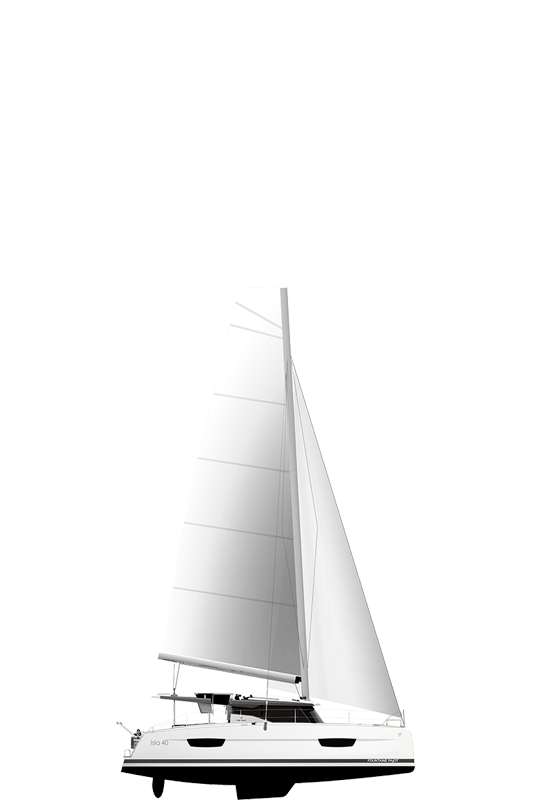
Explore our models in a different way thanks to the virtual marina
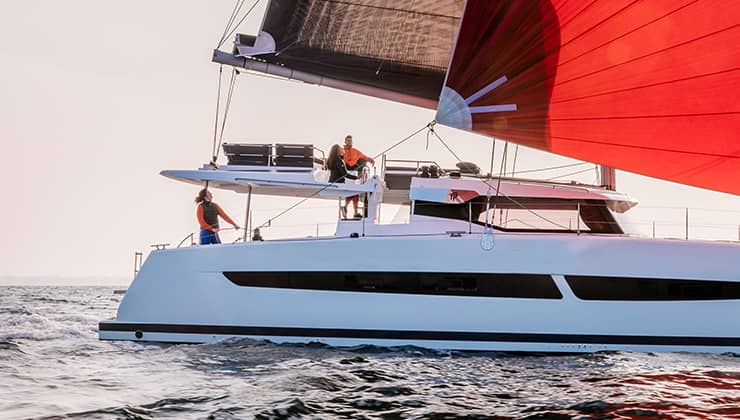
Efficiency through design
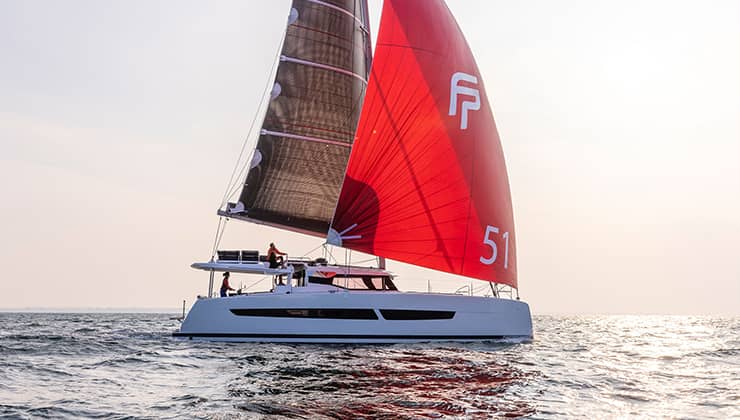
A feel for the sea: sailboats first and foremost
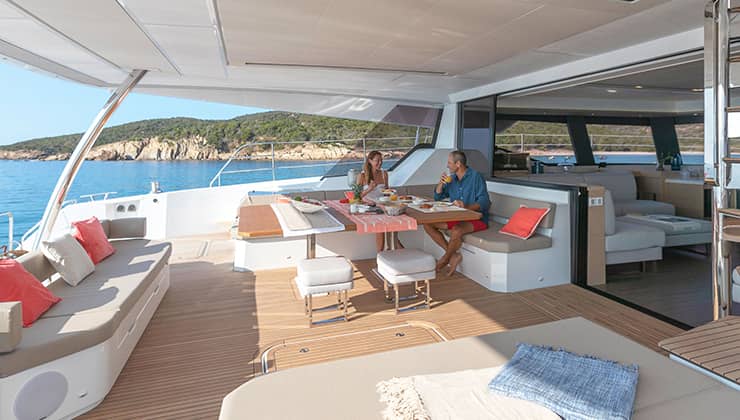
When volume transforms to real space
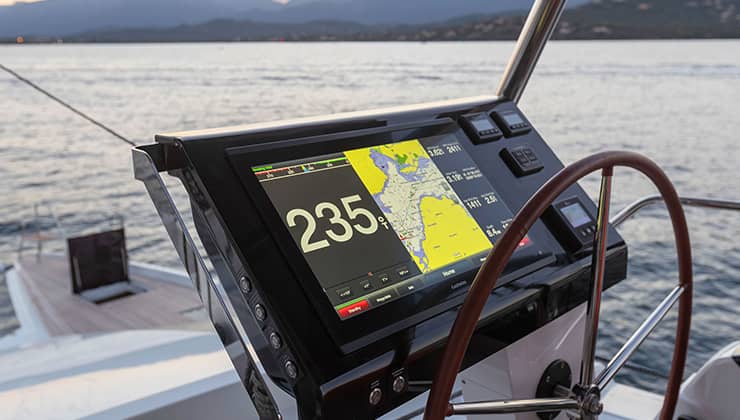
Innovation as a foundation
- Smart Electric
- Virtual marina
- Experiences
70+ years old, and a round-the-world trip aboard an Astréa 42
5 January 2023
Event location

#WEBCASTS FOUNTAINE PAJOT #PARIS
On the occasion of the Paris Boat Show which took place this December 2022, Fountaine Pajot welcomed Michel and Minouche, a couple of owners of an Astréa 42 , who are realizing their dream: sailing around the world in 4 years. After 2 years of sailing, and halfway through their trip, these two courageous 70-year-olds share with us in this new podcast their adventures on board their catamaran. On the program: meeting with whales, volcanoes, and advice on how to choose the right boat!

More information about Minouche and Michel’s adventure on their blog: voile-aventure-monde.com
The Atlantic crossing, a cruise reserved for the initiated?
Crossing the Atlantic by sailboat is often considered to be an adventure reserved exclusively for the most initiated among us. However, with the increase in Atlantic crossings aboard cruising catamarans , this experience seems to be attracting more and more enthusiasts, although it may seem intimidating at first. Making a transatlantic crossing, like crossing the Pacific or the Indian Ocean , can be a very fascinating and enriching experience for travellers, even for novices. Especially since the means of navigation and catamarans have evolved in recent years, making crossings more accessible and safer, as well as sharing experiences on social networks, making it easier to prepare.
Unlike a more traditional cruise , crossing the Atlantic involves at least the skippers and their passengers in an adventure lasting several weeks. This offers travellers the possibility of an immersive and engaging experience, time to take full advantage of the boat’s marine qualities and the living spaces on board. And this is where sailing catamarans excel. With their two hulls, catamarans offer unparalleled sailing stability , a useful comfort for both skippers and passengers who can go about their business as well as anchoring. They also offer spacious living areas , to respect the intimacy of each person, but also to spend convivial moments in the saloon, the aft cockpit, or the flybridge depending on the version. Crossing the Atlantic is also an opportunity to stop over in exceptional places that are just waiting to be explored! The Canaries and Cape Verde come to mind, archipelagos lost in the ocean, with a temperate climate and still well preserved. A great opportunity to reconnect with nature and enjoy the beauty of the ocean…
If crossing the Atlantic is a project that interests you, but you are still hesitating, note that there are organised transatlantic races to accompany you on this adventure in complete safety , such as the “ Rallye des Iles du Soleil “! The Rallye des Iles du Soleil is a regatta that takes place from France to Guadeloupe in the Caribbean , with stops in the Canaries and Cape Verde. It is a yachting rally for cruising yachts , known for its friendliness and camaraderie; participants come from all over the world, with varying levels of skill and experience.
Some tips on how to prepare for a transatlantic crossing (because yes, you have to be prepared for it!):
- Planning: Planning is the key to a successful crossing. It is important to plan your route, take into account the weather , winds and currents, plan your fuel and food supplies, and ensure your boat is in good working order.
- Preparation: Proper preparation is also crucial. You need to train physically and mentally, familiarise yourself with safety procedures at sea , test your equipment and ensure that everything is in working order before you set off.
- Crew: If you are sailing with a crew, make sure that each crew member is qualified and competent, and that everyone is fully aware of their role on board before the big start.
- Safety: Safety is paramount at sea . Make sure your boat is equipped with all the necessary safety equipment, such as life jackets, life rafts, emergency beacons and communication equipment.
- Knowledge of the sea: Knowledge of the sea is also important. Make sure you are familiar with the navigation rules, communication procedures and weather conditions of the area you are sailing in.
- Flexibility: Finally, be flexible and ready for whatever the sea throws at you. Weather conditions can change rapidly at sea, and you may need to alter your route or plan accordingly.
You may also be interested in
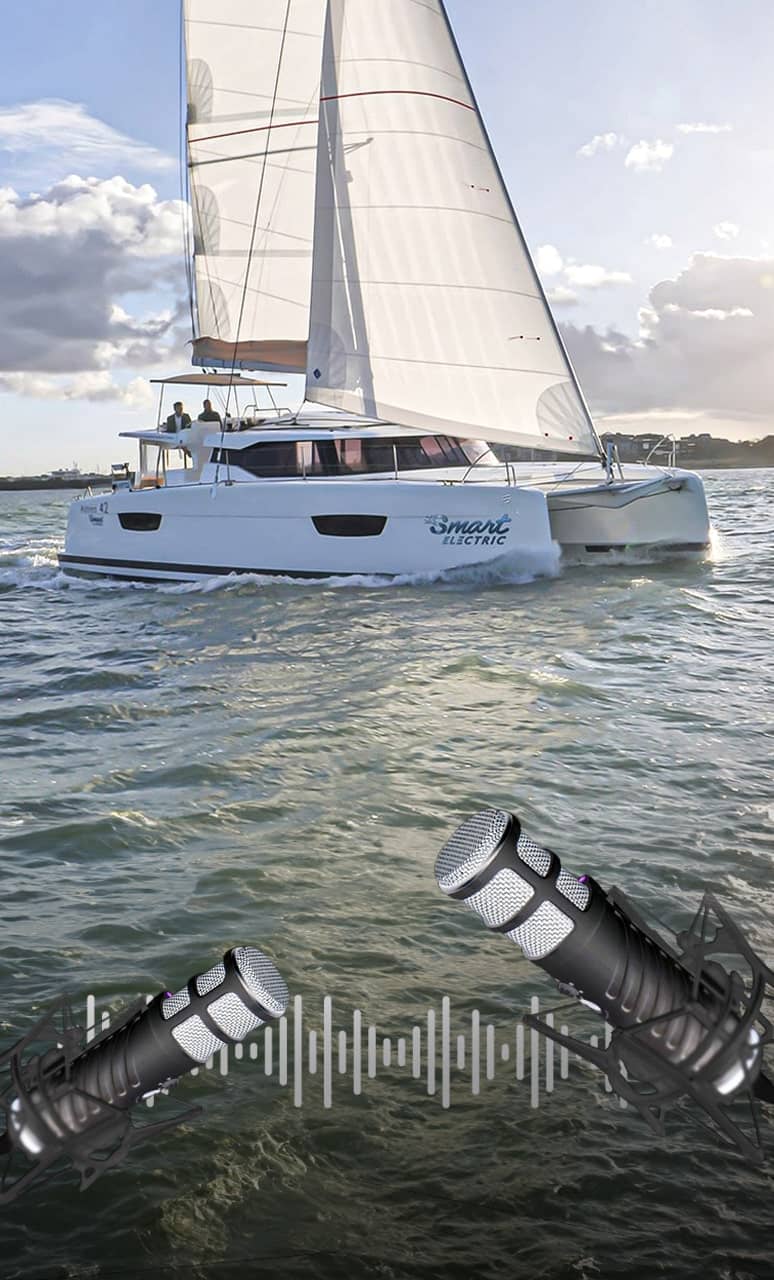
How does Smart Electric technology work? Answer on video…
Smart Electric: a complete overview of this technology, its origins, how it works and its everyday benefits... #Broadcast
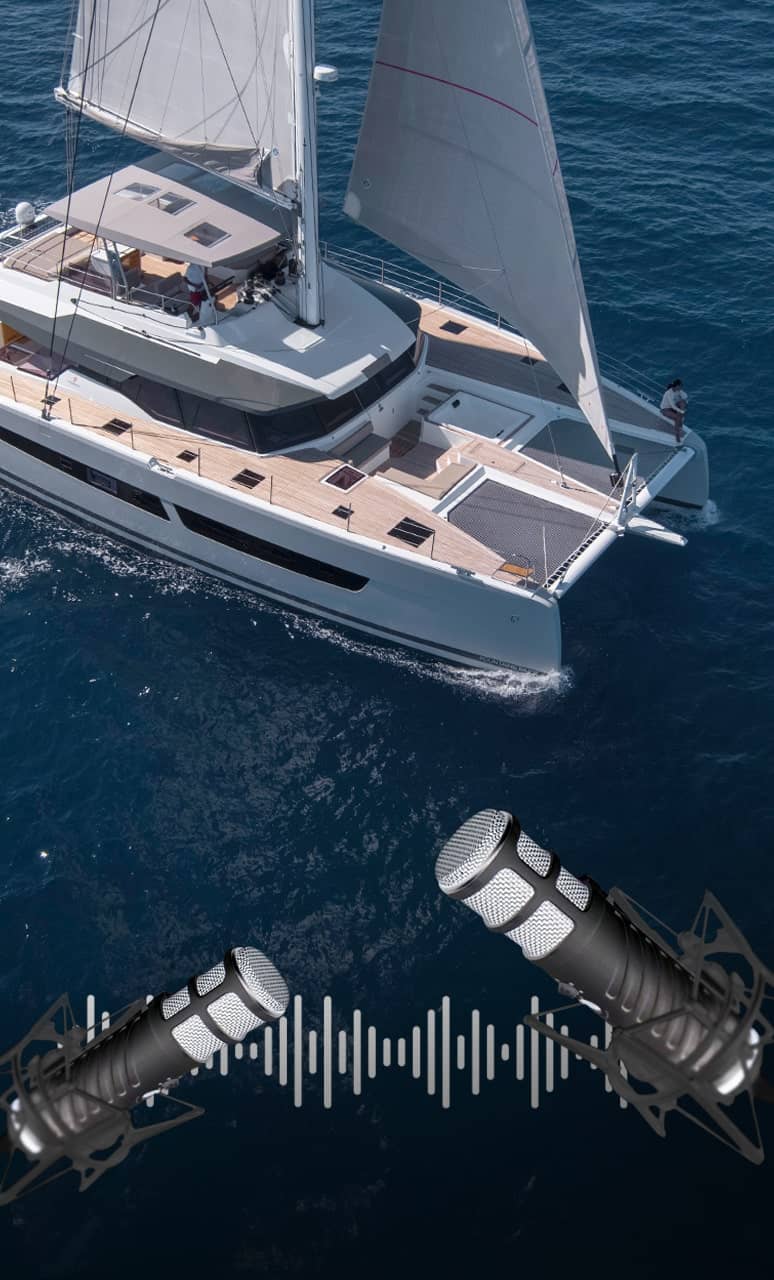
Acquire a flagship catamaran, tailor-made solutions: charter management, customization…
How do you buy a flagship? What types of ownership are there? How do I get proper support? Find out all you need to know in this broadcast...
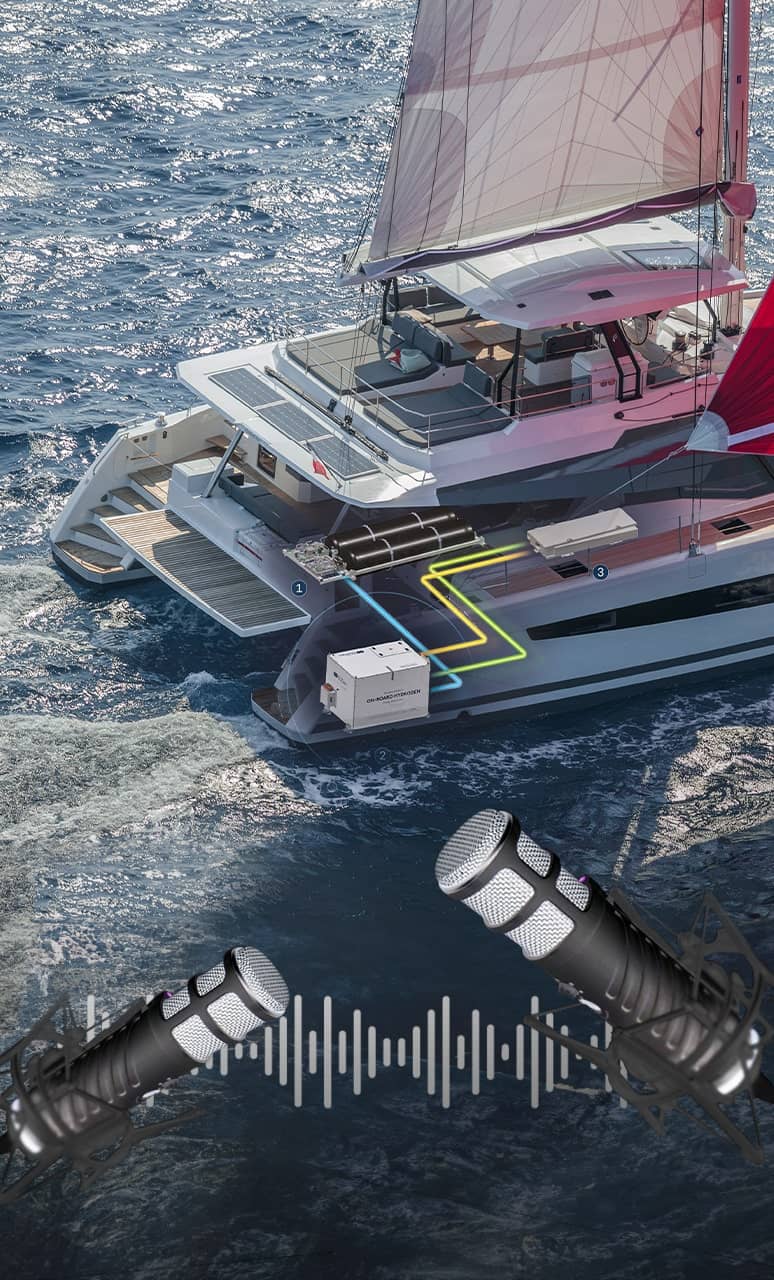
What is the future of hydrogen in recreational boating?
Discover the challenges of implementing Hydrogen, thanks to our experts...
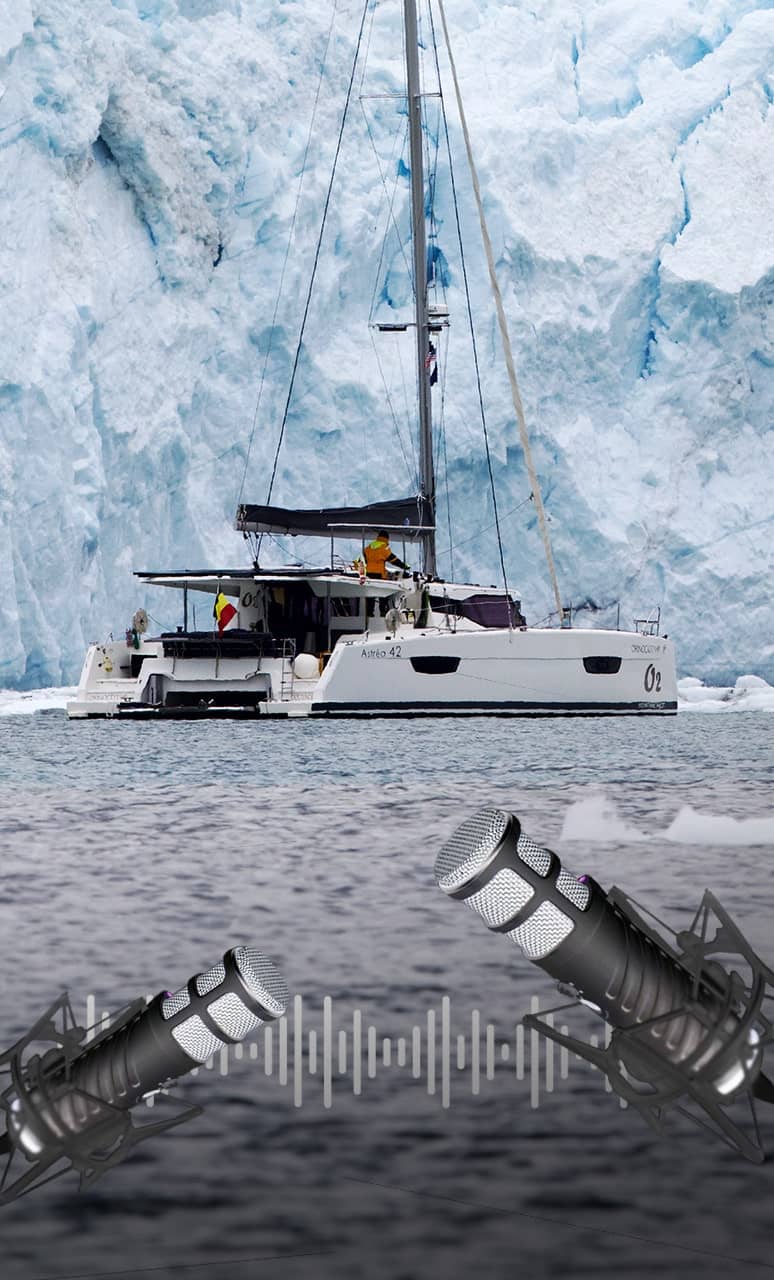
Isla 40 and Astrea 42, the perfect models for starting out in the world of catamarans?
Isla 40 and Astréa 42, find out all about these catamarans through two testimonials...
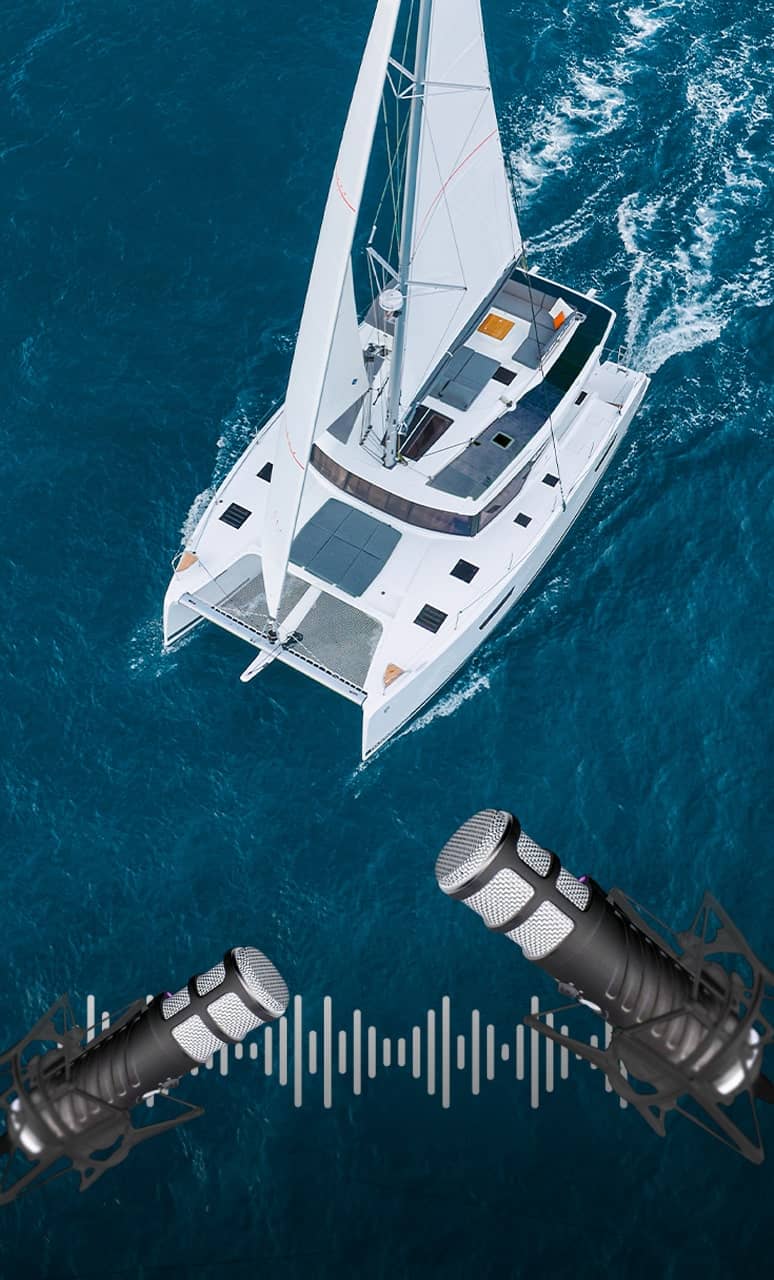
The Tanna 47, a multi-purpose boat that ticks all the boxes?
Tanna 47: a program to find out all about this model...
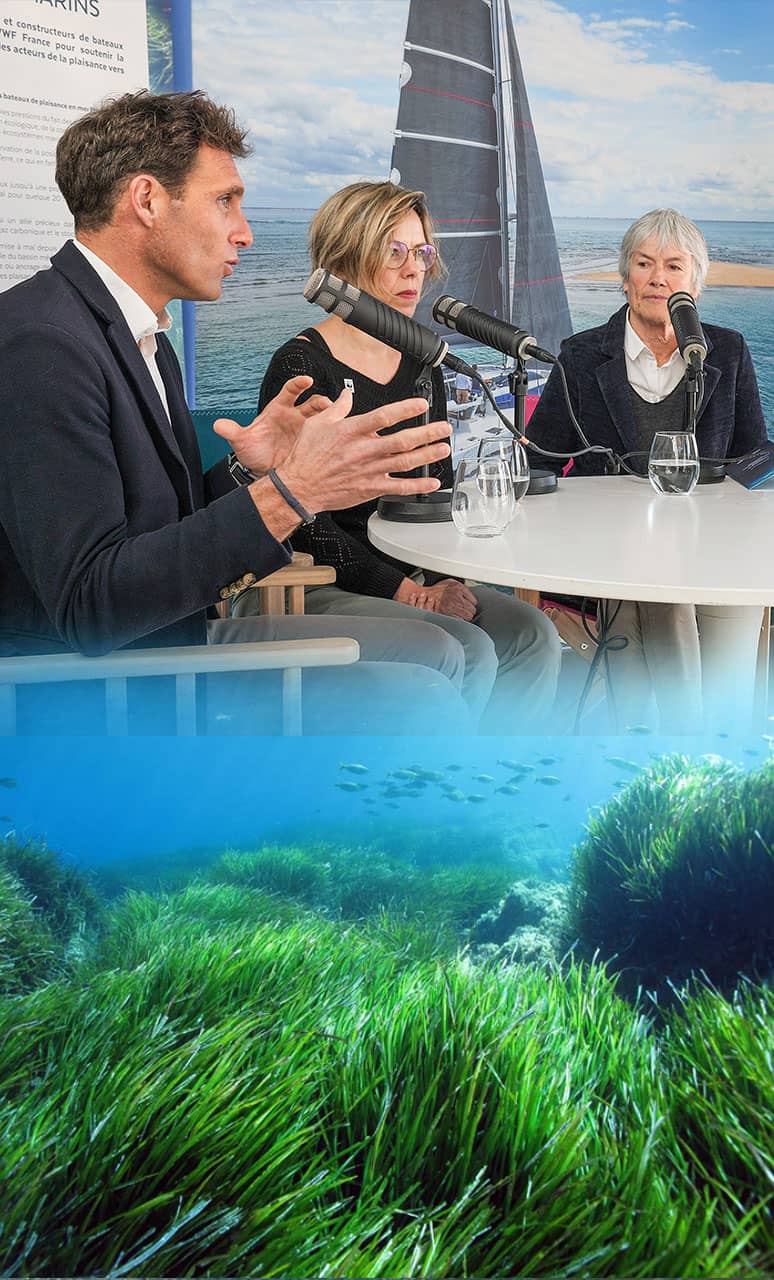
Posidonia seagrass beds, the blue lung of the Mediterranean sea? WWF explains us everything
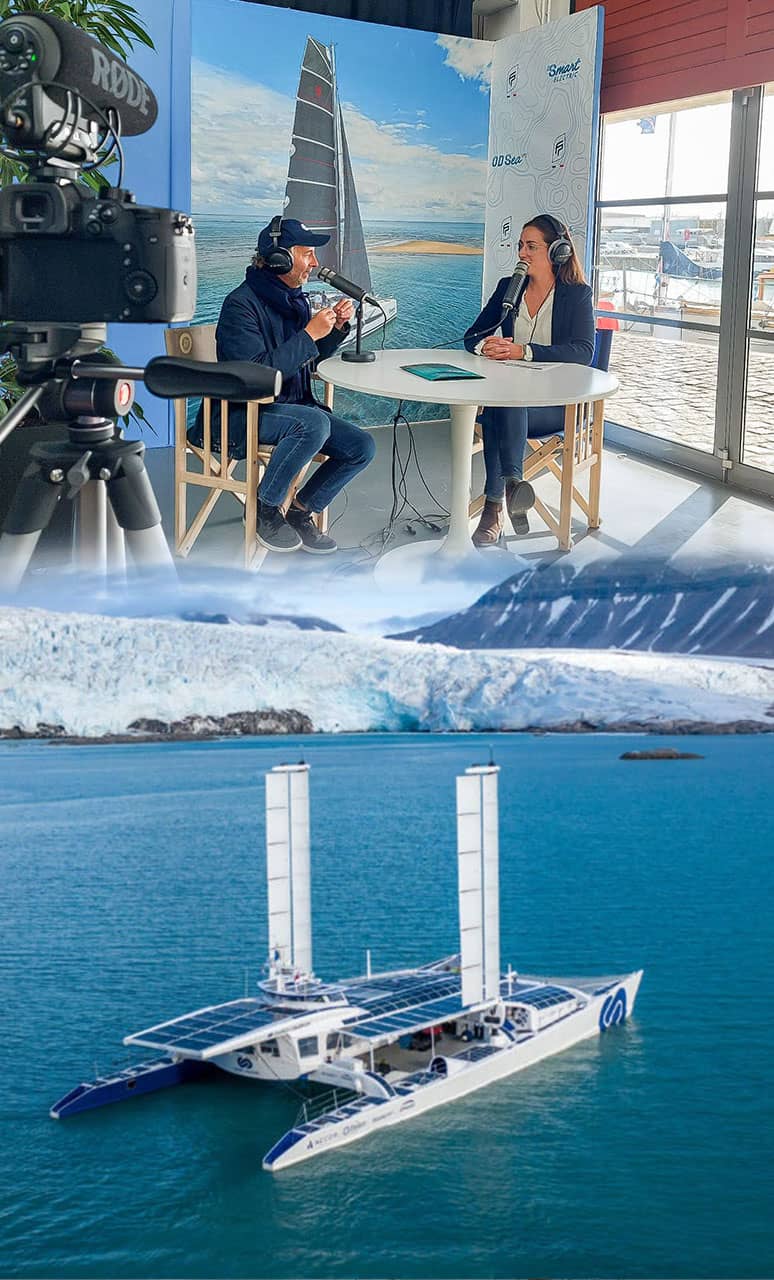
Energy Observer, a true floating laboratory
Energy Observer, a source of inspiration and experience for Fountaine Pajot
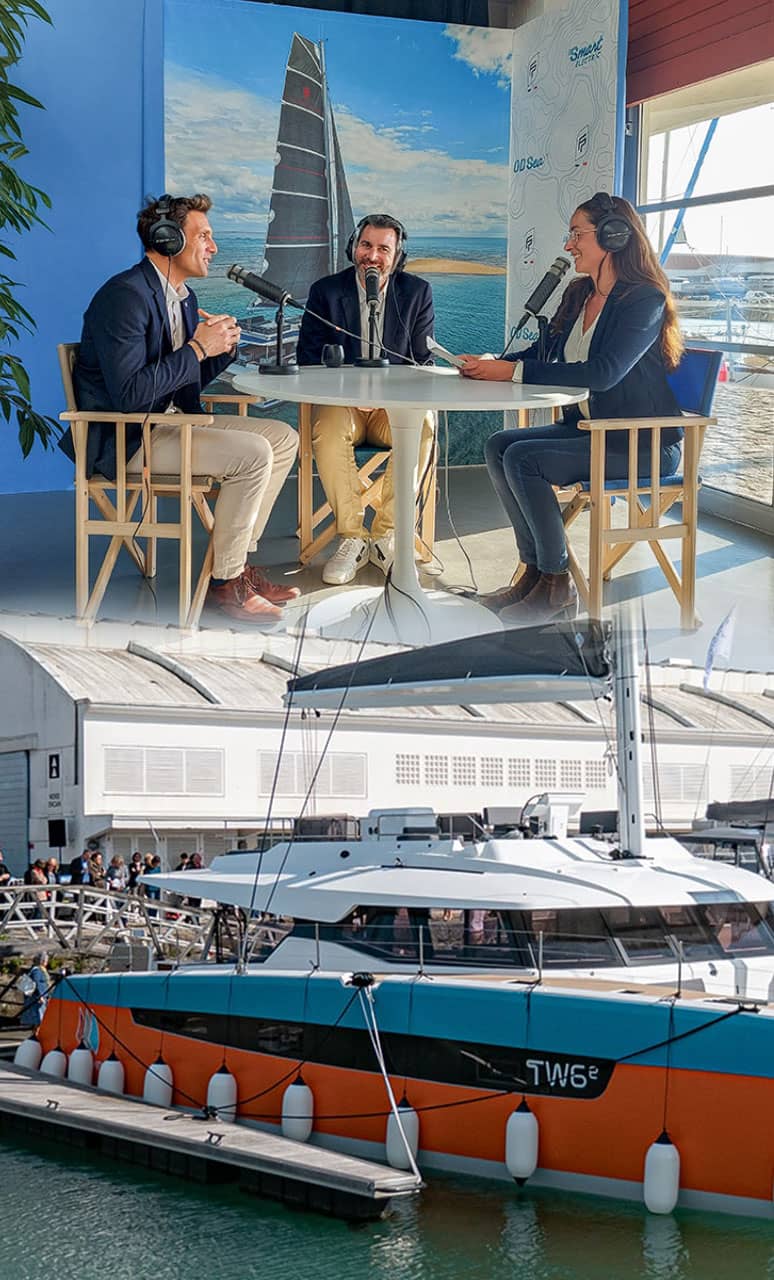
The first 100% electric hydrogen catamaran
The Samana 59 REXH2, a hydrogen catamaran forerunner of future 100% carbon-free solutions.
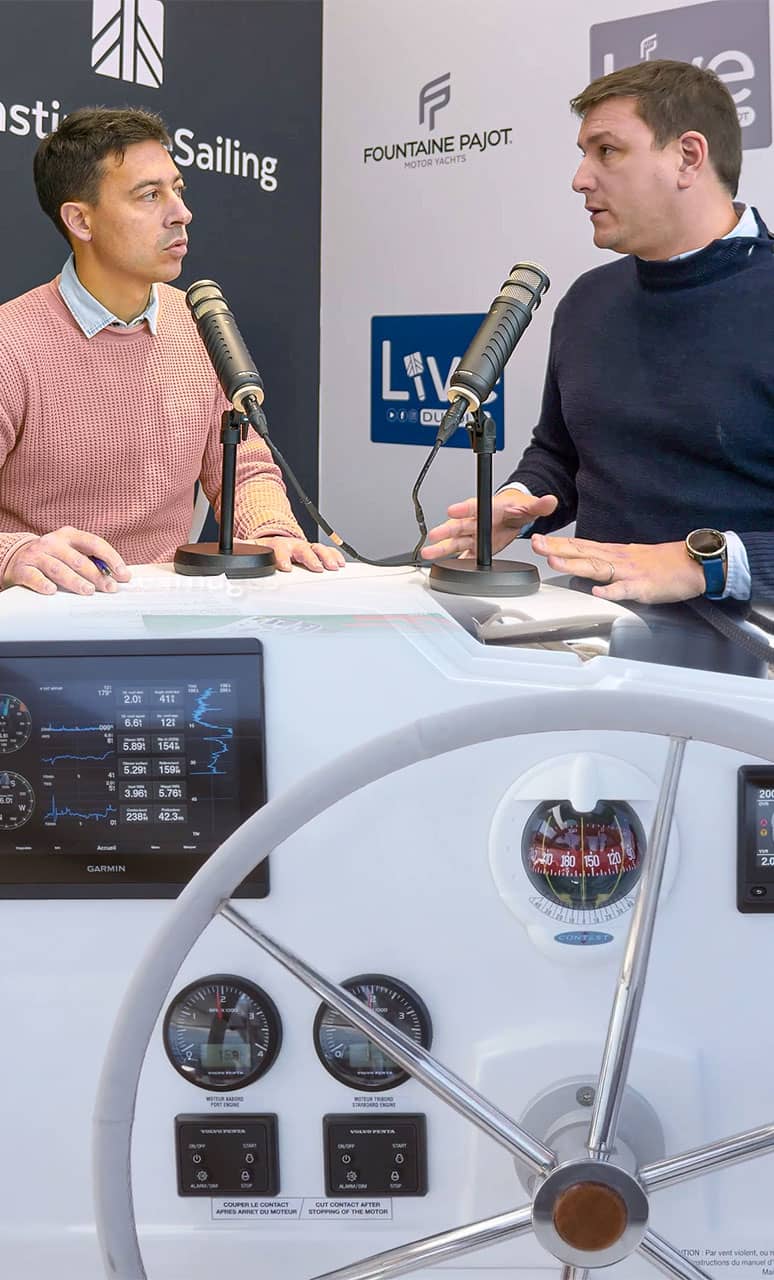
How Garmin envisions the future of its navigation equipment?
Garmin has been an official partner of Fountaine Pajot for many years, equipping Fountaine Pajot sailing catamarans and motor yachts with navigation equipment and interfaces.
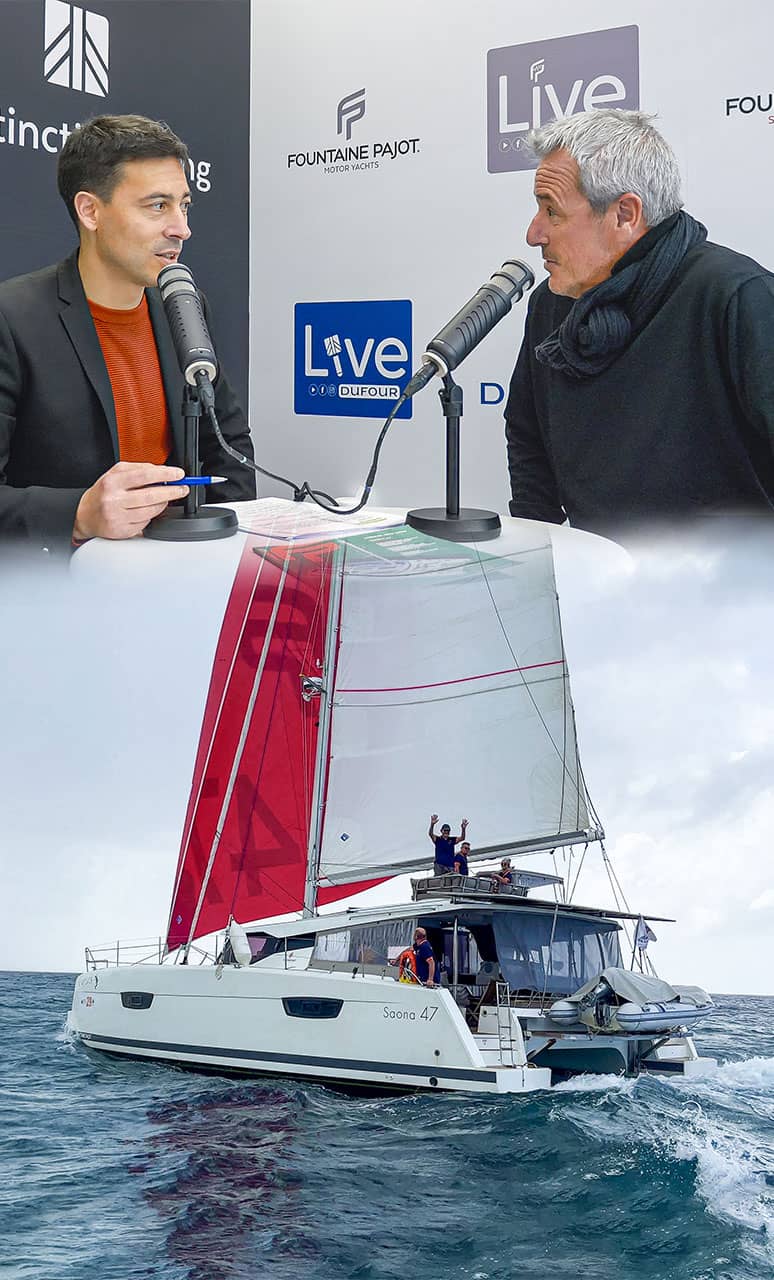
Rallye “des Îles du Soleil”, a friendly and safe transatlantic race?
Pierrick Garenne comes back on this new edition of the Rallye des îles du Soleil.
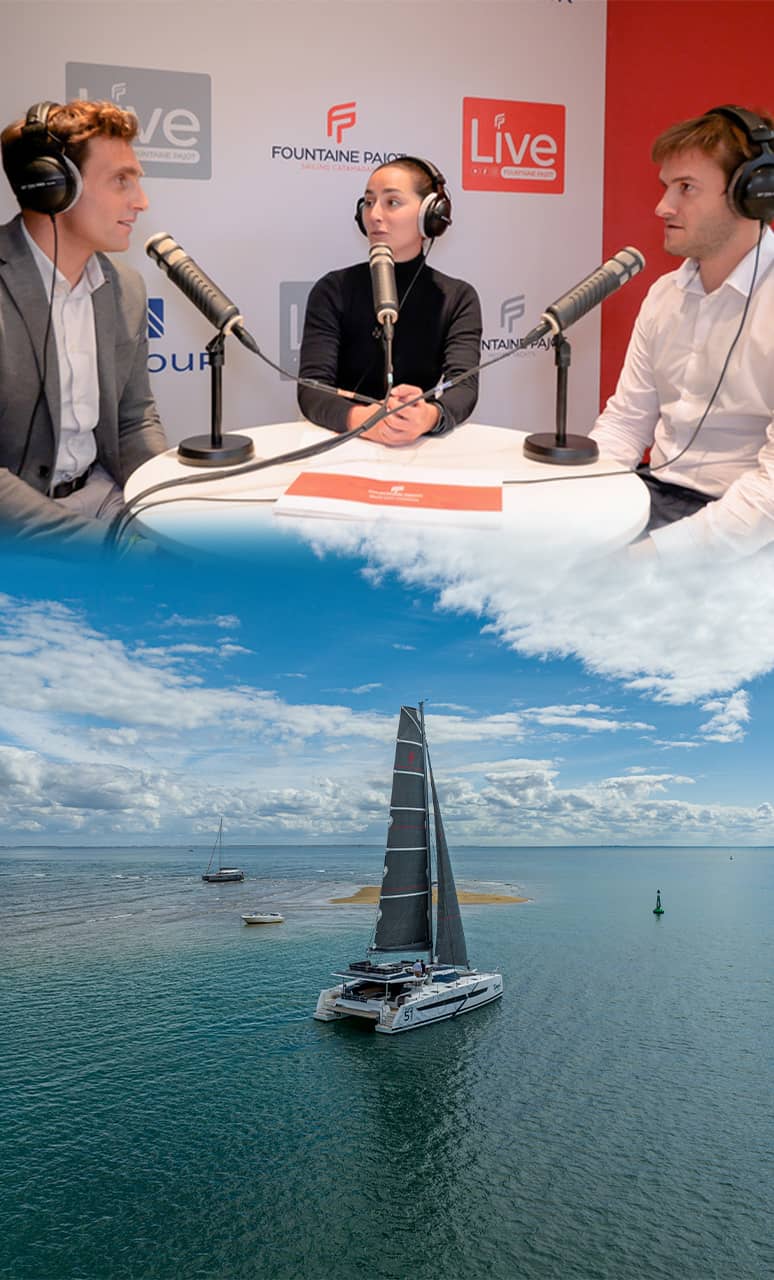
Aura 51 Smart Electric: behind the scenes of its conception
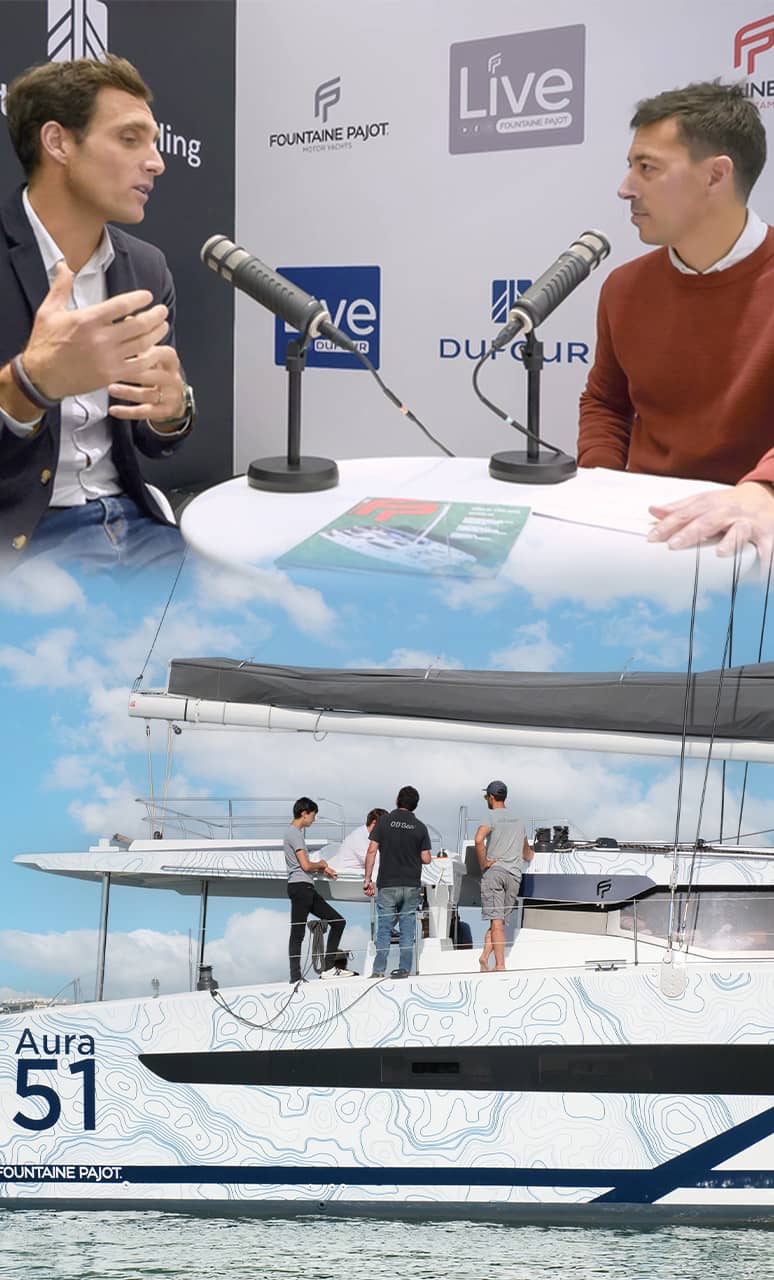
1 year later, where is Fountaine Pajot’s environmental strategy?
Subscribe to the newsletter
Follow the adventures of Fountaine Pajot Owners, discover the latest news and upcoming events, and take part in the development of the Boat of tomorrow!
Compare models
Catamaran Isla 40
Catamaran Astréa 42

Hosting capacity
Motorisation
Technical information
User-friendly areas
Sunbathing Non
Kitchen Non
Sunbathing Oui
Discover the prices
Double rooms
Your contact details
One last step before reaching the next page & discovering the prices proposed & main options for this version! You'll then be able, to schedule a live chat with your local dealer to discuss all the options and configurations available for this model!
Your home port
Any questions?
No pack information currently available online for this Flagship model. We will get back to you directly. Thank you
Would you like to configure this model’s options or set up another model?
Make an appointment with your nearest dealer and choose the boat of your dreams.
7 Best-Known Routes for Sailing Around the World (with Maps)
Route planning is among the most crucial bits of preparation, especially when it comes to circumnavigation. This article will give you seven of the most commonly used routes for sailing around the world. Some routes have been sailed many times by many people, others are obscure or even dangerous.
- The Fast Route - for the minimum time
- The Pleasure Route - for the maximal pleasure
- The Traditional Route - the road most taken
- The Arctic Route - for the rough ones
- The Dangerous Route - without regards for piracy
- The Cheap Route - with a budget in mind
- The Coast Lover's Route - never going far from the coast
Since circumnavigation is quite a complex matter, let's go through this list one by one below.
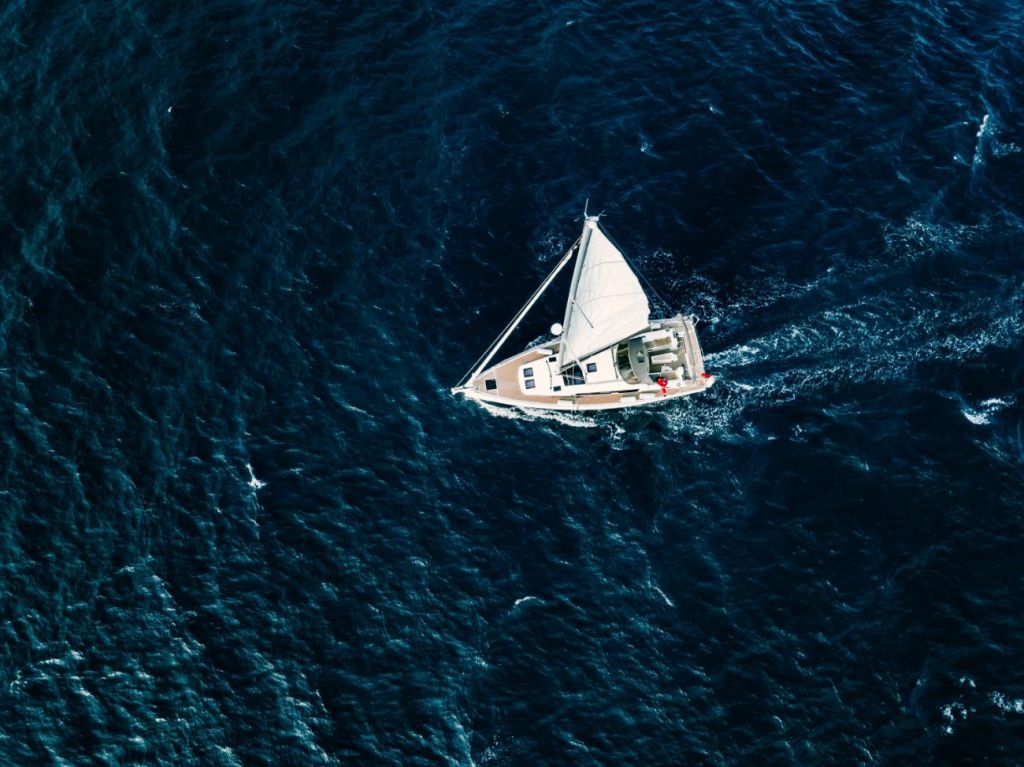
On this page:
How to choose a route for you, route for speed, the pleasure route, the traditional route, the arctic route, the dangerous route, the cheap route, the coast lover's route.
What route you will take depends on what kind of journey you are looking for. If the goal is to do it in the least amount of time possible, you will be choosing a different path than if you don't care about time and put emphasis on sightseeing.
Similarly, if safety and convenience are at the top of your priority list, you will choose a route that might differ greatly from that of a person ready to spend more on security and cut corners through tricky territories.
If you have specific locations in mind, you will take turns that are, logistically speaking, quite impractical, while if efficiency is what you want, there are certain places it would make little sense to visit.
And finally, if you are after comfort, you will avoid some bumpy places and times of the year, as opposed to somebody who won't mind venturing into the corners of the oceans that require a hell of a warm jacket.
There is no right or wrong answer here; don't feel some approaches are better than others. Just look at what you want from the journey, read through this article, and then choose what best suits you.
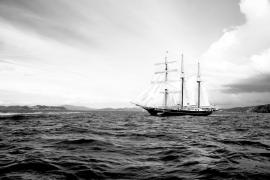
21 Places to Avoid Sailing Around the World (In Order)
Let's kick this off with a racing spirit. This is the route taken by those competing in Vendée Globe, a circumnavigation race. It takes a bit under three months...
...that is if you are a racer and so is your boat. If you are a cruiser kind of person, it will take more time, but the point is that this route is as straightforward as it gets.
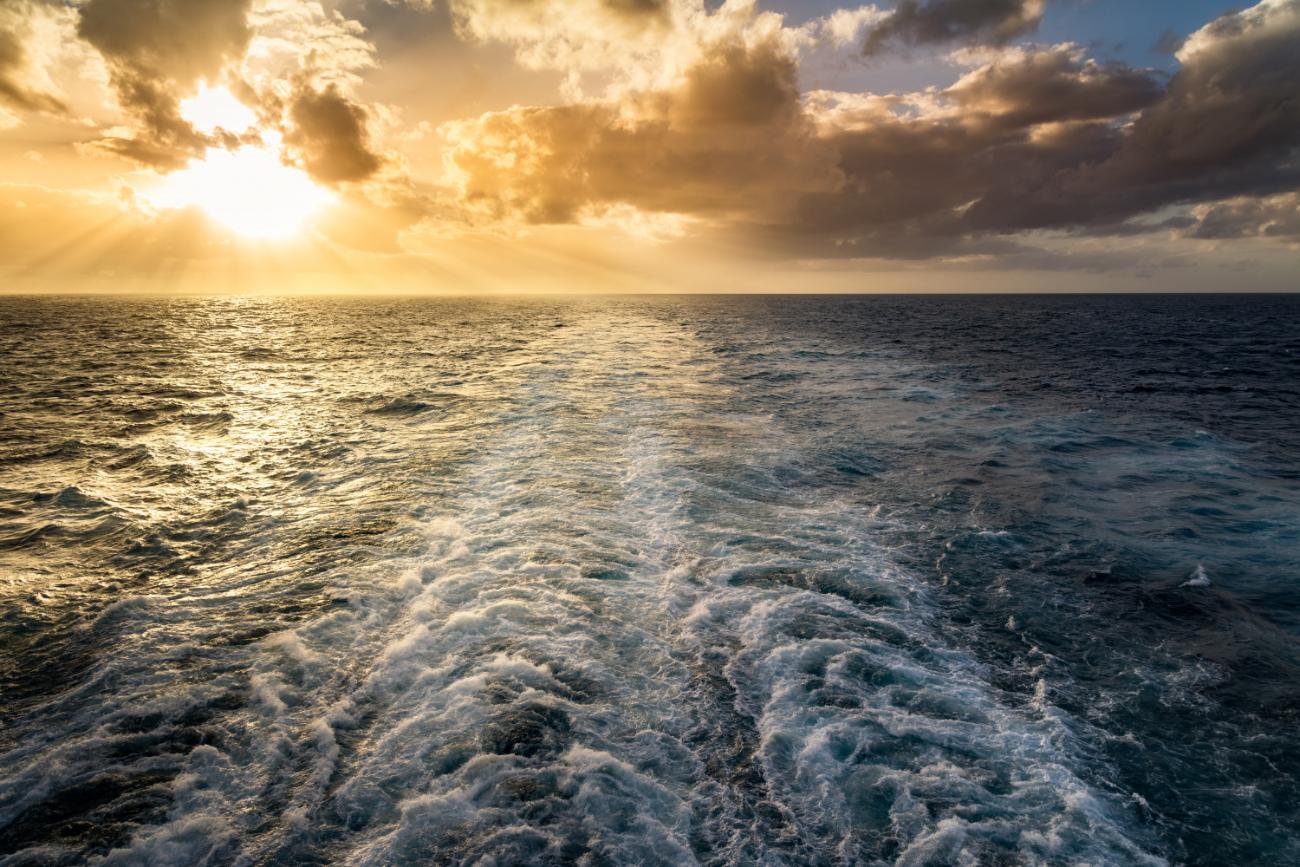
So what waypoints does it touch? Vendée globe racers start in France, then head down towards the Cape of Good Hope, circle Antarctica as close as the rules allow, and after getting to Cape Horn, head up to France again.
Of course, based on where you start from, your route might differ. But the idea is as follows:
- head south towards the Southern Ocean
- sail around Antarctica through the Southern Ocean
- after reaching the point where you met the Southern Ocean for the first time, head back up
The Southern Ocean is not a breeze, the cold waters mixing with the warmer ones coming from the north, plus the danger of icebergs, as well as the cold temperature, isn't how your typical holiday dream looks. That being said, it's up to you how close to Antarctica you will want to be when going around it.
This route doesn't touch down at any land, so you must be prepared for months on the sea as far as provisions, spares and mental capacity goes. Of course, this is variable, you can easily make landfall in Azores, South Africa, South Australia, or South America, and some of the South Pacific islands, if you need to. Either way, it is demanding logistically, so be sure to have your checklist in check .
It is among the most straightforward routes. Not just because it is probably the shortest one or the fastest one, but all the hassle with visas, check-ins, going through canals, and other lengthy land creatures' business will be foreign to you.
If you make it through the Southern Oceans unharmed, you will certainly have one hell of a story to tell.
Now let's go on the opposite side of the specter.
Let's suppose you theoretically have unlimited time. Instead of doing things quickly and efficiently, you want to take it at a leisurely pace while admiring all that there is to see.
This route will begin and end in the Mediterranean, but that's just because that's where I am based, sailing-wise. Wherever else you are, just pick the point of the route closest to you and begin there.
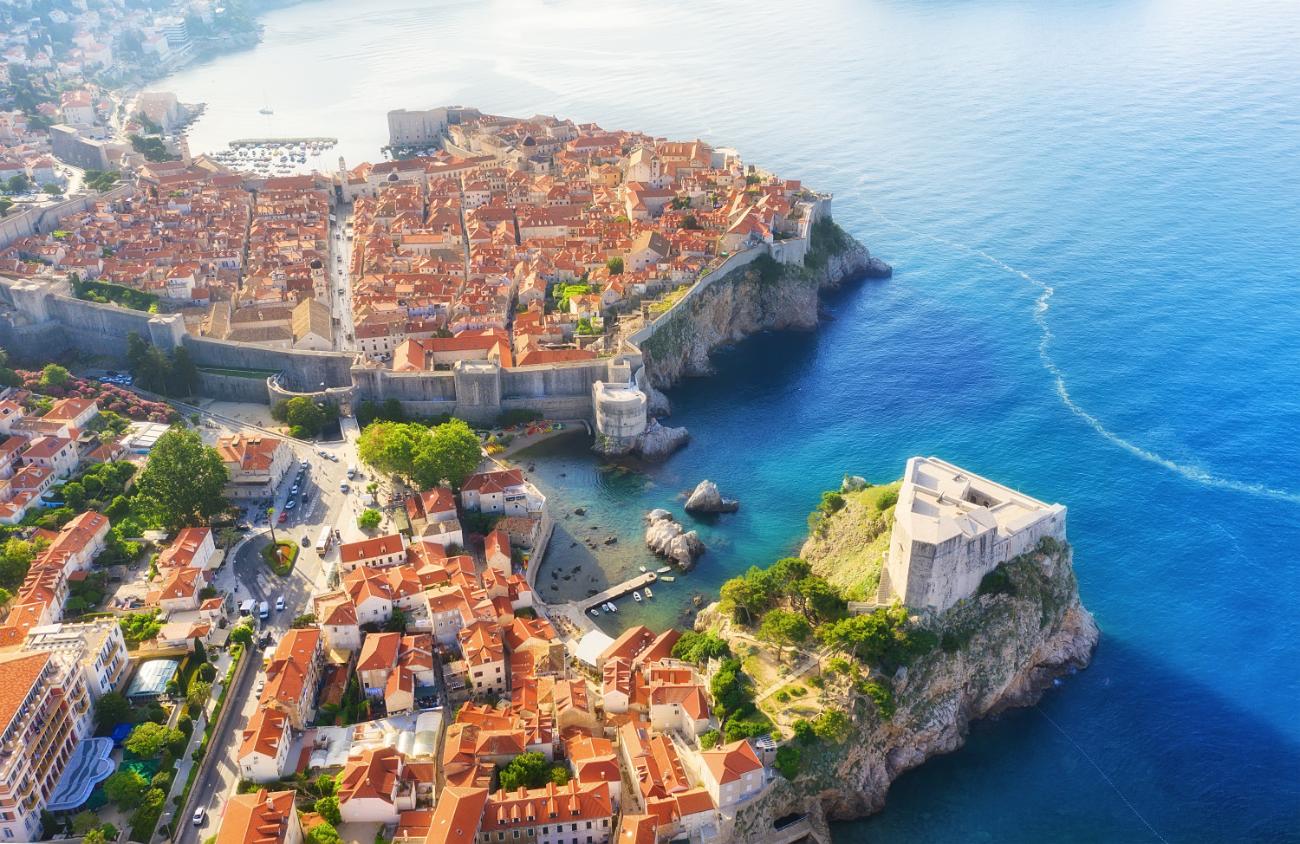
We will begin in Croatia, because it has beautiful shores and islands, travel around Greece with even more islands, the south around Italy, through Gibraltar. After that:
- head south to the Azores
- west to the Caribbean and through the Panama Canal
- west to Hawaii
- south to French Polynesia
- west to New Zealand, then Australia and Papua New Guinea
- northwest to Indonesia, Philippines, Vietnam, Thailand, India
- south to Madagascar, then along the African coast to Cape of Good Hope
- north to the Azores and then through Gibraltar back home
This route takes time since it aims to explore all it can even remotely touch. It's not just that the route is long, because the aim is to visit pretty places. You might also find yourself having to wait months at some places for the bad weather season to clear before you can make your next crossing. Have a look at our article about things to think about when planning for a long trip .
Because of that, this route is more demanding when it comes to planning, visa hassle, check-in research, more ports and anchors, more provisions planning. Also, your boat will need to be a solid liveaboard , since you will spend so much time on it. Logistically, it will be demanding.
But for all that hassle, you will literally get to see the world. You will visit many fantastic cultures, get to taste the cuisines from all over, and the long times waiting for the winds to calm down will be spent on exploring the place you are 'stuck' at.
What more does one need...
...except perhaps some middle ground. Now that we've been to two extremes, let's look at something in the middle: the route most commonly taken when circumnavigating.
It is rather similar to the Pleasure Route above except for skipping the Mediterranean, Pacific, and Southeast Asian stops.
Thus it goes as follows:
- From Europe, head south to the Azores
- west to Australia
- west to Cape of Good Hope
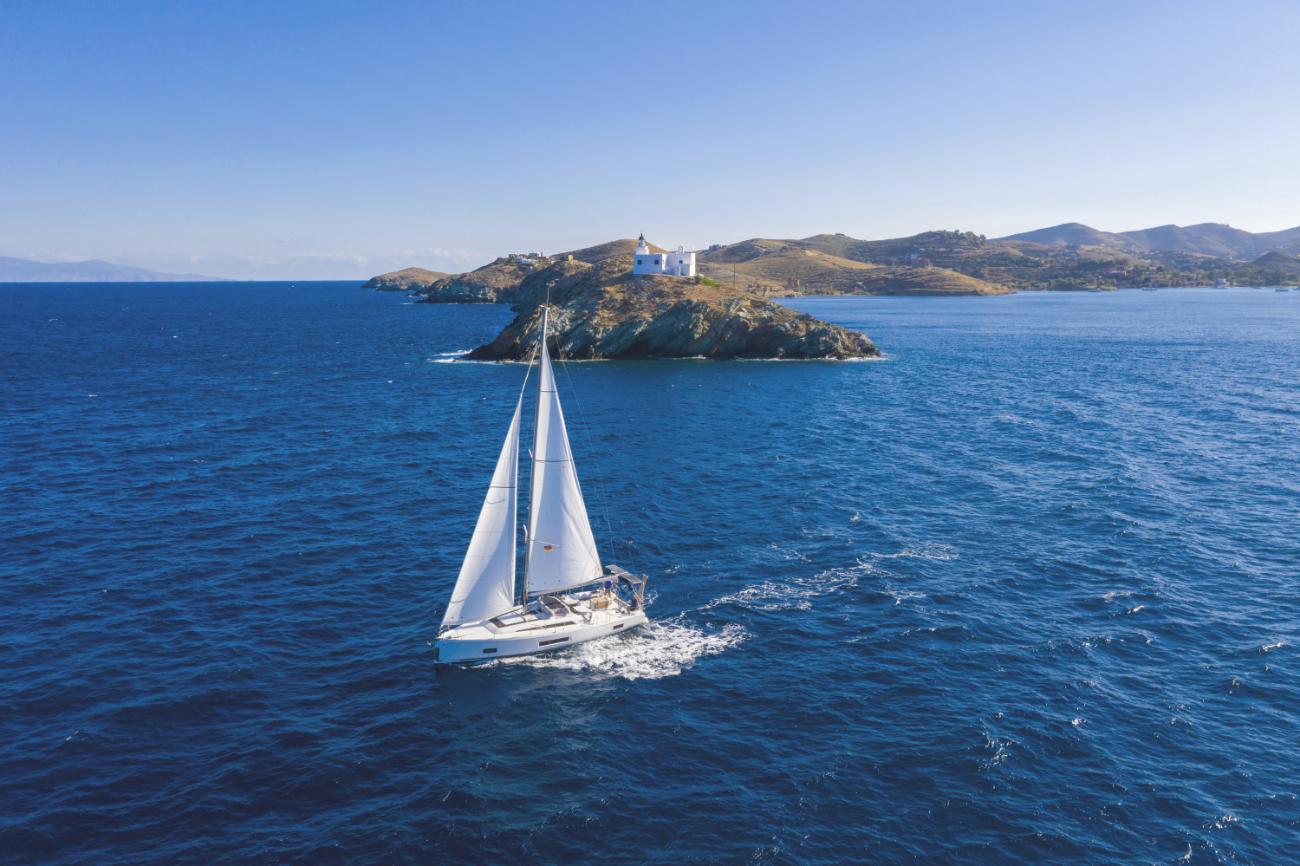
This route accomplishes the circumnavigation while stopping at beautiful places but doesn't necessarily explore everything that happens to be around. Its strong suit is the variability. If you like the Caribbean, you stop and cruise around there. If Australia excites you, you do the same there. If you want to see Madagascar, well, it will be almost on your way. And so on.
It has been a traditional route to take because it is relatively painless and does not go through any hazardous areas.
It has been traveled by many before you, so there is a lot of info floating around if you want to do your research on specific parts of the journey.
On its own, it has a lot of long legs where you will not see anything but the ocean on the horizon. So for those of you who mind this, you gotta make it your own, customize it a bit, so that you spend more time at places that you like.
This planning really is important. Some of those legs can't be made during certain seasons if you want to be careful, so to make sure you don't get stuck somewhere you don't particularly like, you should plan well.
With that, let's get crazier.
For those who want to do things the hard way. Perhaps you really like the scenery, perhaps you want to test yourself, or maybe you've done every other passage, and now it is time for the icy one.
There is a circumnavigation route that leads through regions so far up north you mostly don't encounter them even on a map. Because why would you look up there.
Now I don't know how long this article will survive on the internet, but note that this route is rather climatically contextual. Given enough time, it might freeze over and become unavailable.
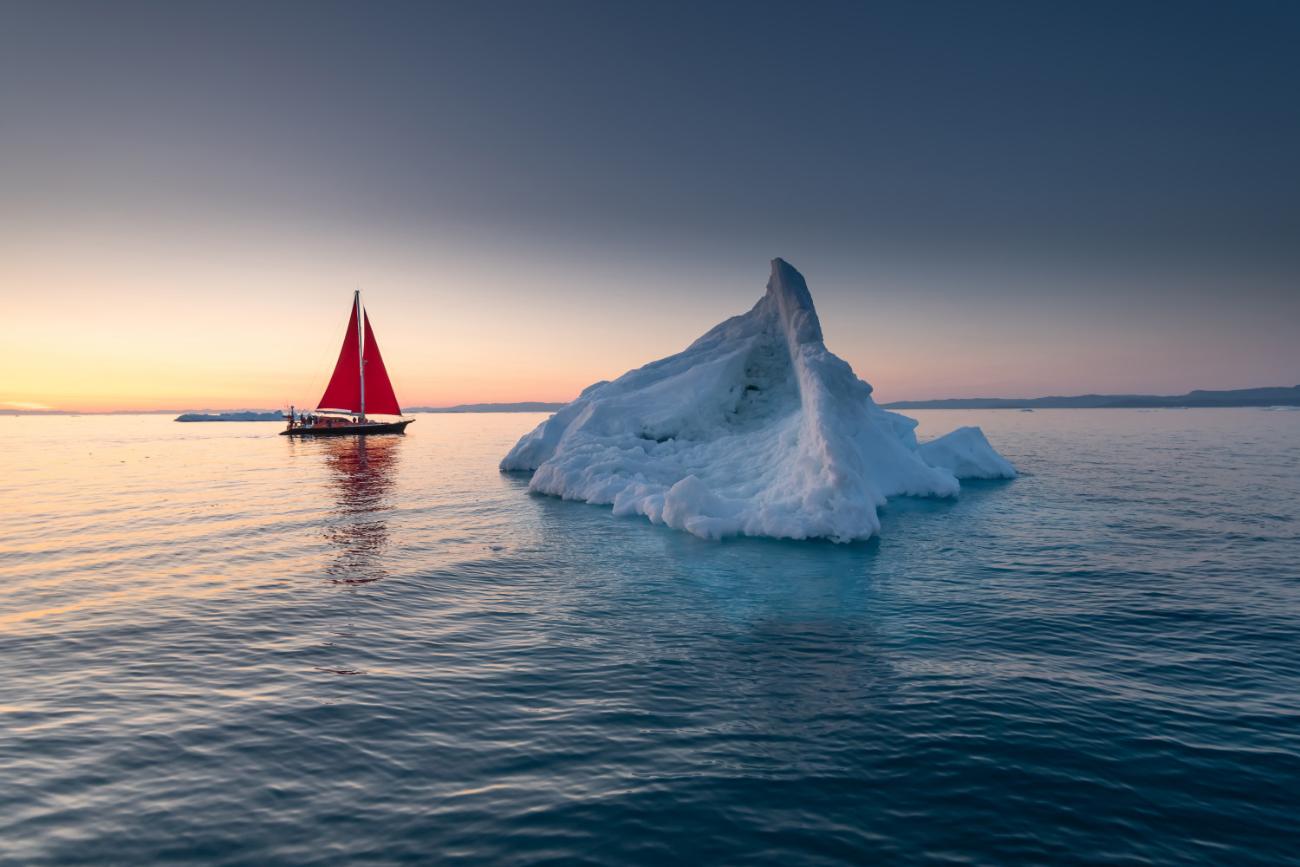
For me, it would begin in one of the northern ports of Norway and then:
- continue west to Iceland
- west to the south of Greenland and then up its western coast to the Baffin Bay
- south of Devon Island and through the archipelagos to Beaufort and Chuchki Seas
- west along the northern coast of Russia under the Lyakhovsky Islands
- west under the Yuzhny Island to the Barents Sea and back to the north of Norway
To this, you will have to add the most straightforward route north from wherever you are to any point on the route above.
Cold. Thus this requires clothing, equipment, and a boat that can withstand the polar temperatures along with chunks of ice floating around.
How much more adventurous can you get? Circumnavigation has been accomplished by plenty of people. This, not so much.
With the above, the major sailing routes have been covered. So what follows are mostly variations. Important ones, though.
Imagine this one mostly as the Traditional Route, except with a few twists. One of them leads through the Gulf of Aden, the Red Sea, and the Suez Canal.
Why take it? Because if you look on the map, you will see that when going from the general direction of Australia or Southeast Asia west, meaning you are probably aiming for the Azores or further for the Caribbean, it will save you a lot of time.
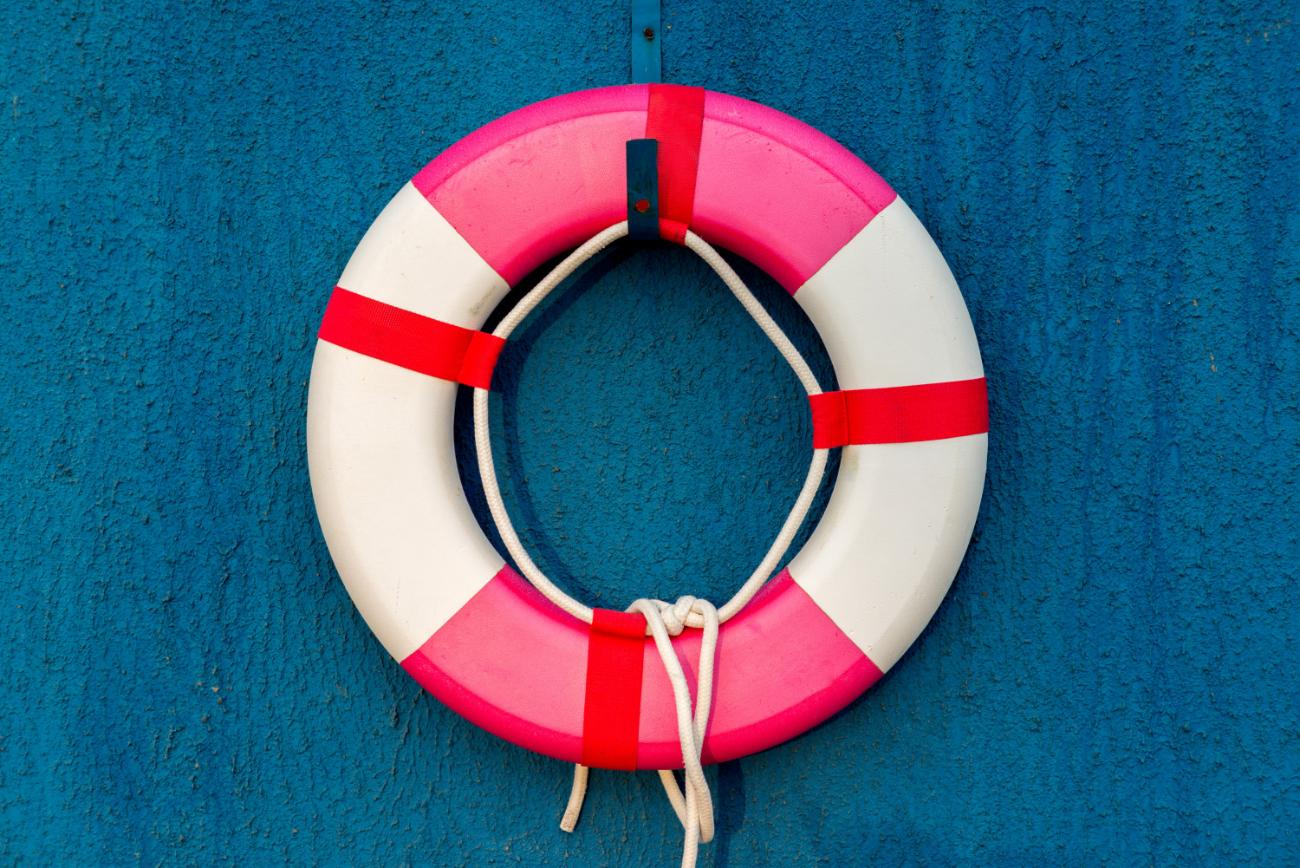
Money, not so much. You will have to pay for security. Because although you will save yourself the long southern route around the whole continent of Africa, which is nearly a 10,000-mile detour, you will have to go through the aforementioned areas that are famous for piracy and require professional armed company if you want to be on the safe side.
Not that it hasn't been done without it, but you know… Furthermore, many insurances won't cover you there since the risks are just too high.
Similarly, the area around Malaysia and the Philippines, which you might encounter during your Southeast Asia travels, bears the same story. No coverage by many insurances for piracy reasons.
Then again, exploring Southeast Asia while avoiding these regions means a few detours and no-go zones.
So if you want to explore the world on your sailboat and don't mind the risk, add these to your route plans.
Obviously, the risk or costs related to security. You will find plenty of sailors arguing that there is no real danger unless you are a cargo ship or a kidnapping worthy target. You will also find plenty who would rather travel in a fleet through there. And plenty who would never set sail towards those places.
Then there is the insurance issue.
With Suez, the upside is the saved time as well as not having to go around the treacherous South African cape waters.
With the Philippines and Malaysia, it's the convenience of being able to go wherever you want to in one of the most beautiful regions worldwide.
See this one as a variant of the Traditional Route and the Pleasure Route.
Some places are cheaper than others. And some places straight up make very little sense to go to.
Going through the Panama Canal is at least a $1,300 expense. Or, there are countries, like Ecuador, where check-in can cost you a $1,000 fee. And last but not least, prices of resources, like food, vary too. The Caribbean is famous for its steep prices in the provisions area.
The prices change, so it would not be bulletproof to give you a precise circumnavigation route exclusively through cheap places. Still, the moral of the story here is that when planning your route, do have a look at the local prices when it comes to check-ins and visas, food and various passes.
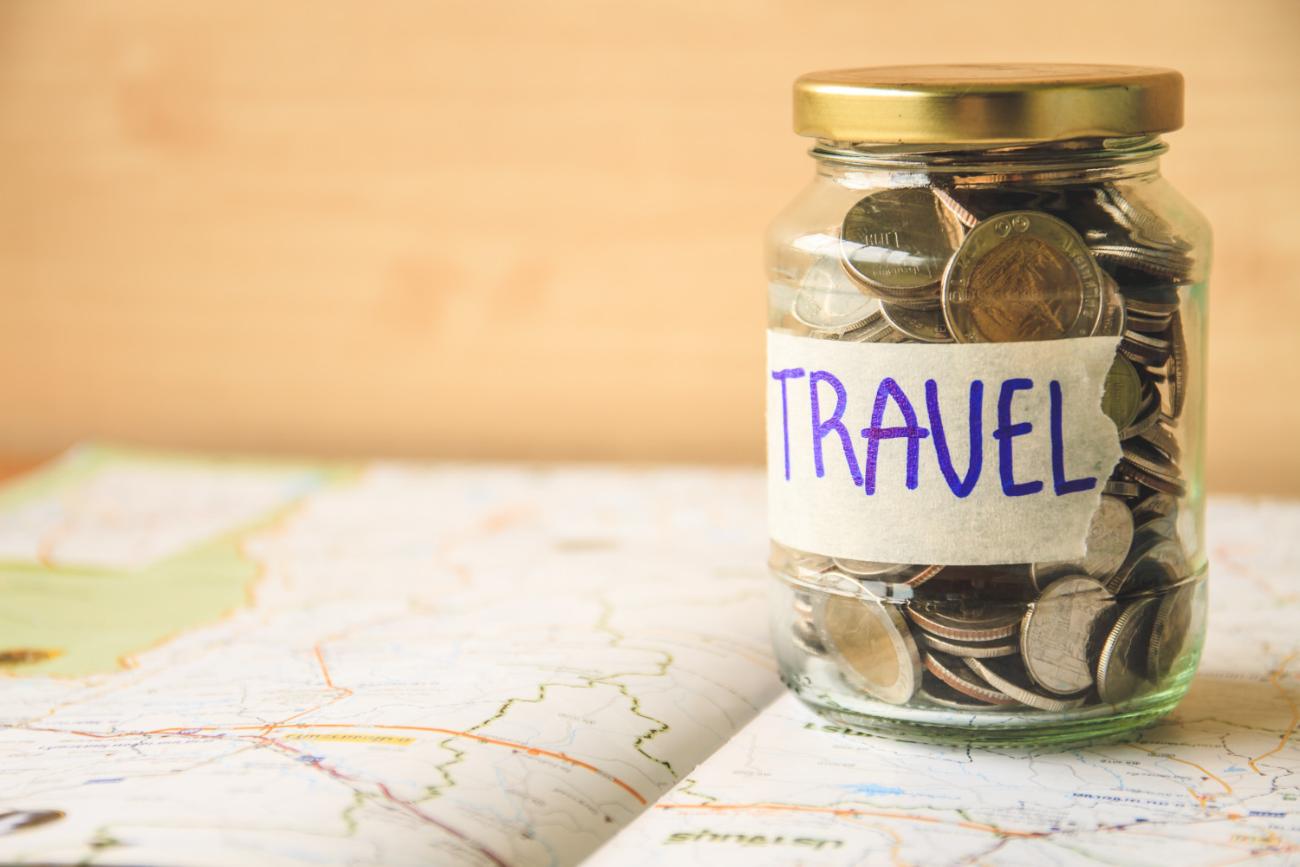
The result should be a route you are comfortable with financially. Avoiding the Panama Canal means a detour around the whole of South America, so it rarely pays off. Avoiding Ecuador, on the other hand, won't hinder your progress and save you money. Stocking up on food before getting into the Caribbean is also a sound logistical choice - unless you plan to stay for longer than your stocks can take you.
Saving money can mean detours, inaccessibility of various places, and more thought put into logistics. So it can result in a less elegant route.
On the other hand, being smart about it can result in a much lower bill overall.
Let me start this one by admitting that I don't believe anybody will actually take this route in its entirety, as delineated here. But it serves as an inspiration to those who are perhaps a bit unsure or simply like to combine two different sailing styles.
Some like to cross vast oceans and love to see nothing but the horizon for months. And then some like to stick to coastal waters for most of their journeys. Nothing wrong with that; at least it gives you something to look at any given moment.
And then there is the benefit of relative safety, a port or an anchorage close by most of the time, the ability to resupply whenever you like, to pick up and drop off people, and last but not least the lack of need for a really ocean-worthy boat and equipment.
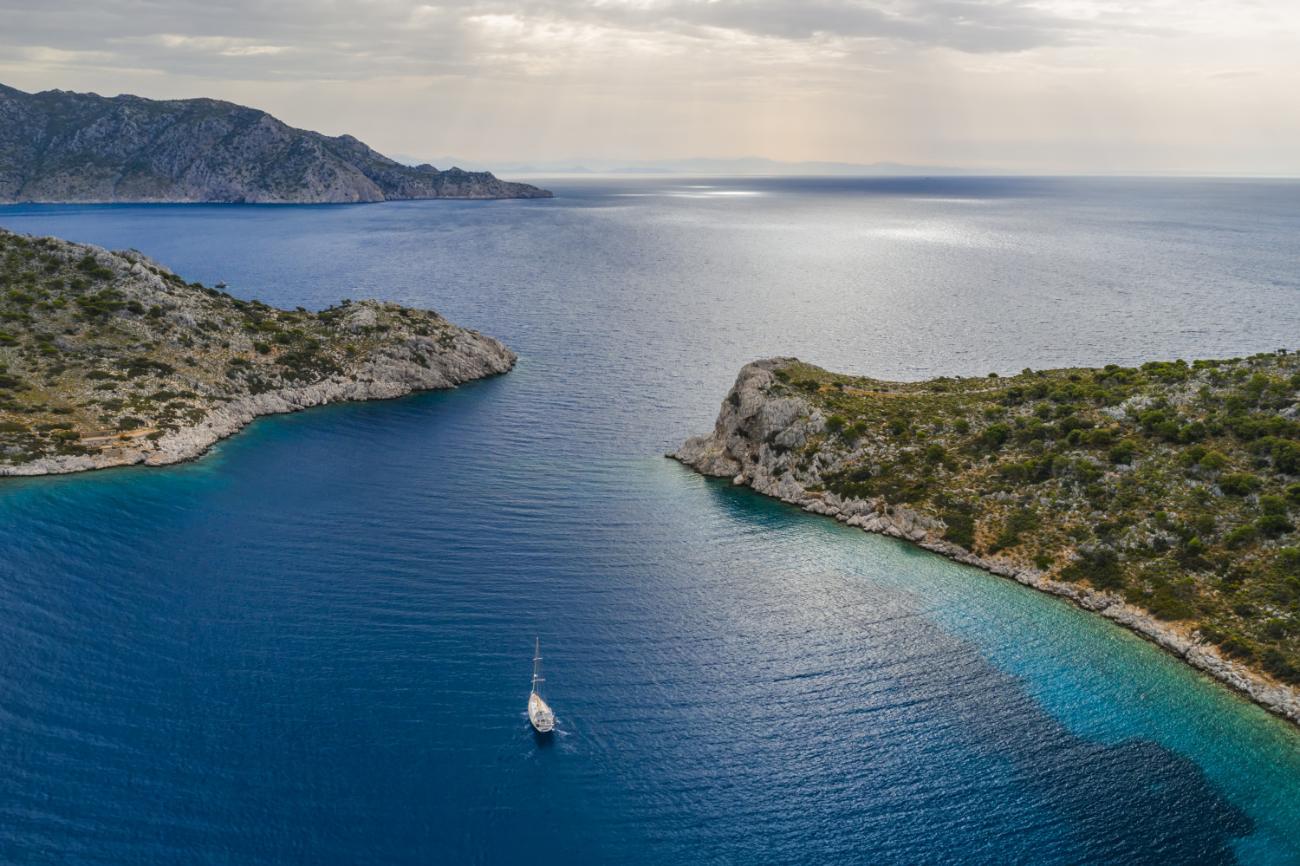
I'm talking about the coastal cruiser's dream of circling all the world's continents, whereby effectively circumnavigating the globe. Eventually. This is the longest route ever.
The idea is pretty simple. You can go around the world sticking to the coast with no crossings, except for the Norwegian Sea and a few short stretches in Southeast Asia.
Or, if you feel up to it (and want to avoid the freezing northern places), you can cross the Atlantic, the Pacific and keep close to the coasts otherwise.
As mentioned in the beginning, not many will actually take this entire route. But it is not uncommon for circumnavigators to have weeks or months where they do exactly this - stick to the coast and enjoy the country.
Lots and lots of time and resources are needed.
You will constantly be checking into countries and solving visas.
Understand the required paperwork for sailing the world This is an article on the topic of check-ins and paperwork, so have a read through it Read up on global licenses
Some areas are arguably less hospitable than others - the coast of Yemen as an example. So you might want to skip a few.
You don't need a proper ocean exploring boat - an island-hopping model will suffice. Many of the modern ones are capable of long crossings if needed here and there.
You don't need as much equipment as power, water, food, and all that jazz will be available most of the time.
The logistics will suddenly become a whole lot easier. Fewer provisions planning, less spare parts planning, broken stuff won't be a disaster… you get the point.
This is the true world tour.
I liked your article; it raised a lot of good points. I think the article could have benefitted from some maps.
I also think that, throughout the article, you have confused the Canary Islands or Madeira with the Azores. The Azores are not south from Gibraltor or France or Europe. They are 1/3 the way across the Atlantic Ocean, almost due west from Lisbon. The Canaries are south from Gilbrator, France and Europe and most people turn west there for the Caribbean.
Again, I liked the article.
Best wishes.
Leave a comment
You may also like, 41 sailboat cruising essentials for long trips.
In this post I list the items you are unlikely to have if you have never done bluewater or long-term cruising before. There are some essential safety product and …
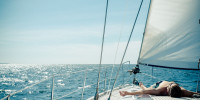
Everything You Need to Sail Around the World (by an expert)
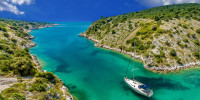
How Long Does it Take to Sail Around the World?
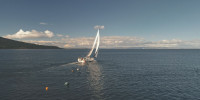
The Safest Sailing Routes Around the World (Which to Avoid)

How Big Should a Sailboat Be to Sail Around the World?
- Outremer 45
- Outremer 4X
- Outremer 4.zero
- Outremer 52
- Outremer 55
- Outremer 51
- Outremer 5X
- All the Outremer Fleet
- Personalized support
- Blue Water Sailing Seminars
- Our concept
- The Outremer team
- Our commitments
- Construction principles
- Our catamaran services
- After-sales customer service & Quality control
- Offshore Connected Catamaran Maintenance
- Concierge Services
- Our owners’ stories
- FAQ – Outremer catamarans

- Brokerage: used catamarans for sale
- Privacy Policy
- Legal Notice
- Grand Large Yatching
The Ultimate Blue-water Cruising Catamaran
Outremer [utʀ əmε: ʀ] draws its origins from blue-water cruising and etymologically from the color Outremer, a deep shade of blue reminiscent of its native coast, the Mediterranean Sea.
Sailing catamaran manufacturer, Outremer, has built over the past 37 years, catamaran sailboats of industry leading quality, designed for performance, to ensure your peace of mind and comfort onboard, whether for short distance cruising or for sailing around the world.
With you at every step
Combining the unique know-how of our talented French workers and the experience accumulated from millions of miles traveled, leading catamaran manufacturer Outremer, helps you make your dream come true from start to finish: from the definition of your project to building the sailboat of your dreams.
Thus, when becoming an Outremer owner, you receive all the support you need in order to ensure your experience onboard is a success. Our preparation package includes a skills assessment, training courses to learn how to sail your catamaran, seminars to prepare for ocean cruising and much more.
Outremer is not only a blue water catamaran manufacturer
Becoming an Outremer owner also means that you will benefit from a large range of services, from the purchase to the sale of your catamaran yacht in our brokerage.
Emergency assistance, spare parts, in need of a refit or simply looking for information? Outremer is your number one contact!
Not decided to purchase just yet? You can also charter an Outremer to get a taste of your future liveaboard catamaran.
Join the community
Passionate sailors.
With a fleet of nearly 400 catamarans around the world, Outremer forms an exceptional community: one of fun-loving adventurers.
To cultivate this bond with our sailors, we organize annual events such as the Outremer Cup, and offer platforms to help mainstream and share knowledge, such as the owners’ Facebook group and a technical blog.
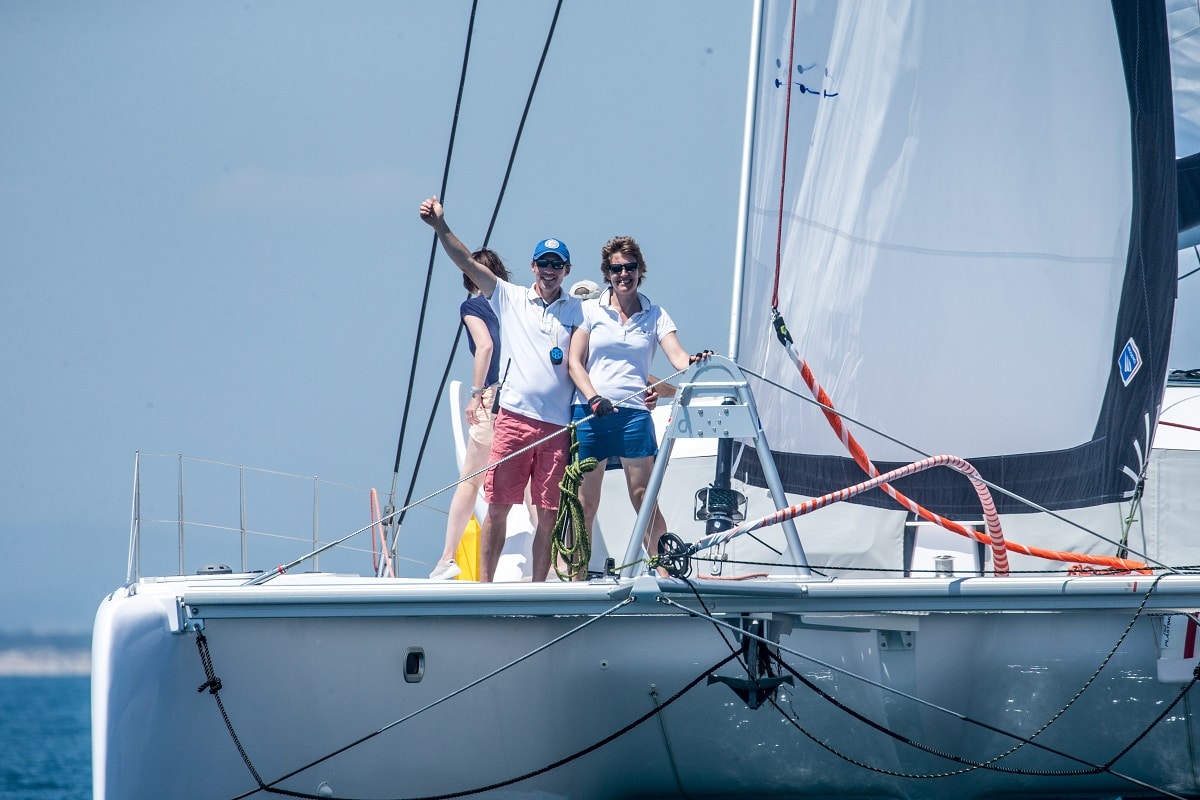
O’Week and O’Cup 2024: a look back in pictures!
Since the introduction of Outremer Week in 2018, around 1,000 owners of Outremer catamarans have been trained. Once again this year, almost 100 owners gathered at La Grande-Motte from 12 to 17 May for this new edition of O’Week.
Training at Outremer: dive into the heart of the O’Week Spring 2024
From the 12th to the 17th, we welcomed our future owners for a week of training and sharing. Between manoeuvres, sailing sessions, marine weather, medical care, motorisation, electronics and safety at sea, our participants acquired invaluable skills.
We Explore: What’s new on board and future expeditions to protect our oceans
The winter refit of the We Explore was recently completed! Intense work has been carried out to integrate even more linen and comfort on board this 5X!
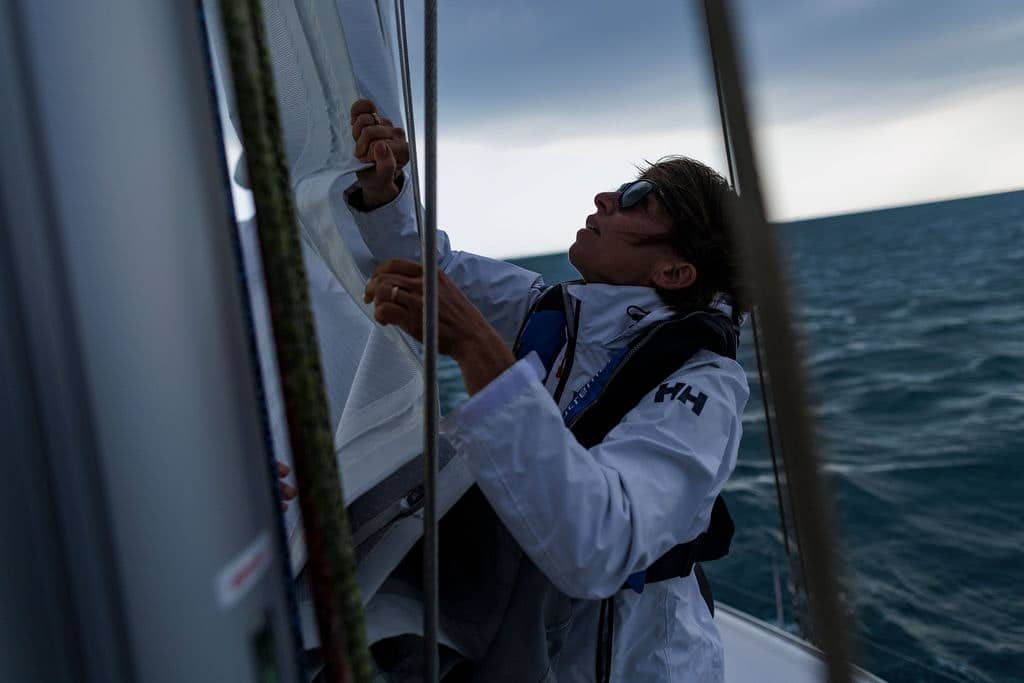
Setting off on a catamaran with the best sailing weather
When you’re getting ready to set off on a sailing trip, it’s vital to find out about the seasons and weather phenomena in your chosen sailing area. Even before choosing your cruising destination or travel itinerary, or even selecting your yacht!
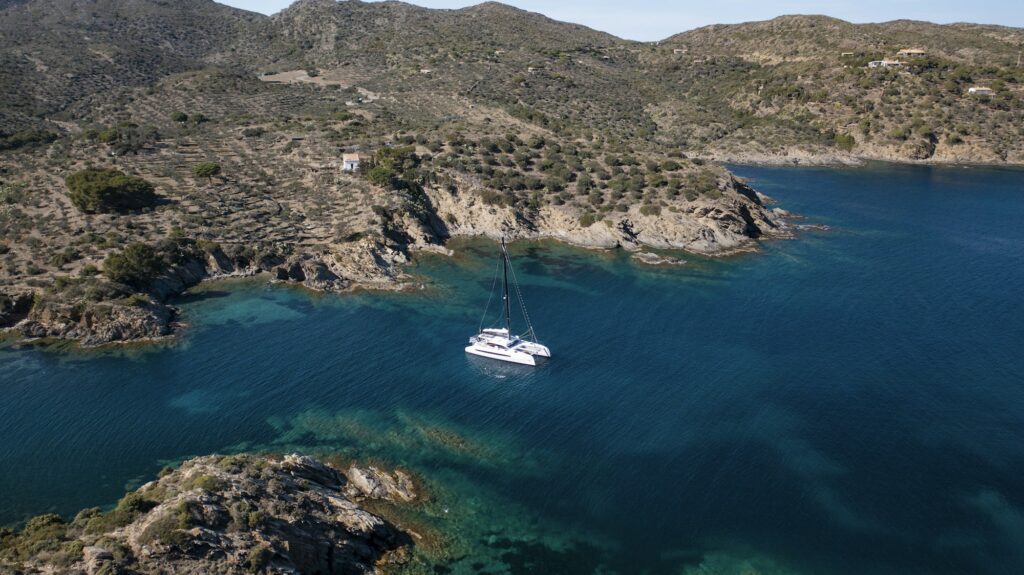
Catamaran VS Monohull: what should you choose to sail around the world?
Sailing around the world is a dream come true: you discover the world to the rhythm of the wind and the stopovers, exploring new destinations every day as you sail. If you’re just starting to read this article, you’re probably nurturing this project. Are you planning to sail around the globe? Then the choice of ship for your next voyage is crucial.
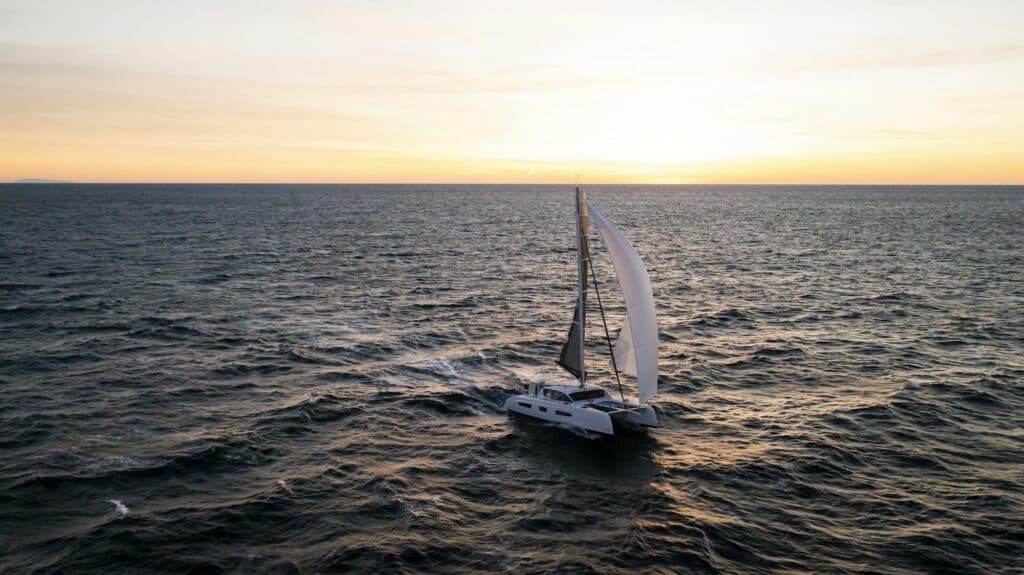
The Importance of Defining Success
In the Autumn of 2023, I ran a ‘Webinars for Women’ mini-series on transatlantic preparations. The first session was titled: “How to approach transatlantic preparation.” As I zoomed out of the nitty gritty of canned food recipes, spare parts inventories, and preventative sail repair and took a broader look at the framework for a successful crossing, I homed in on what I think the first and most important step is: defining your goal.

Sailing in the Bahamas : unforgettable stopovers
The Bahamas Islands are a dream destination to explore under sail! In the heart of the Caribbean Sea, the archipelago offers the chance to enjoy sailing through splendid scenery, pleasant places to stop off and memorable activities. In this article, the Outremer team tells you what they consider to be the essential stages of a catamaran cruise in the Bahamas.
Cannes Yachting Festival 2024
Let’s invent sustainable boating together.
The ambition at Outremer has always been to create innovative sailboats, convinced that sailing was, and still is, the most natural and respectful practice.
At a time when environmental and societal issues are at the heart of concerns, we have a determined ambition: to invent sustainable boating.
Invitation to set sail
As a French catamaran manufacturer, we are proud that almost 400 Outremer catamarans have been sailing on all the seas of the globe with couples and families living their dreams.

What Size Catamaran to Sail Around the World

Table of Contents
Anyone who knows you says this trip is already long overdue. The ocean is calling out to you and has been for a long time now. You’re more than ready to sail the seven seas. In fact, you’re virtually dying to do so. But first, you need to pick out a catamaran — moreover, one that is the correct size not merely for getting you around the world, but also for serving all your needs, wants, and goals on your trip.
You need to find the catamaran that will make all your trouble worth it. This seems simple enough, but as you begin your search, you quickly discover that there are so many (too many) options out there. Now you’re probably wondering, “Which size is right for me?” and “How do I figure this out?” In this article, we will break down how to choose what size catamaran to sail around the world with.
Some consider catamarans sized at 35 feet to 45 feet to be the best for ocean sailing. Many consider 45 feet to be the sweet spot when it comes to picking out a catamaran for trips around the world.
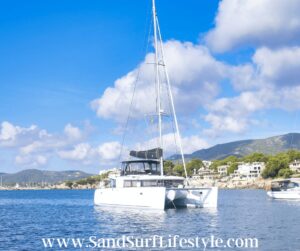
1) Basic comfort, speed, and circumnavigation of the vessel.
2) The amount of “cargo” you’ll have on the catamaran — in other words, the essential stuff needed in order to actually make your catamaran run, how many passengers will be on board, what it is you plan to do while on board, which items will be involved in making this happen, and how much space will be required for these activities.
3) Your budget in regards to catamaran size and, even more importantly, safety.
4) The actual measurements of the catamaran: 20 feet to 30 feet, 35 feet to 45 feet, and 50 feet to 60 feet being among the most popular sizes.
As we already stated before, the best catamaran size for a journey around the globe varies on a case-by-case basis. It depends entirely on your needs, wants, and intentions while out at sea. Nonetheless, the most important thing for everyone — new and seasoned sailors alike — to recognize while settling on a catamaran size is that it is never too early to consider anything and everything that might play a role on your trip. Every little thing matters, and the sooner you factor something in, the better you can plan for your voyage. This should also optimize the amount of fun you’ll have while on board.
Remember — it’s always better to be overprepared for the ocean than underprepared for it. Being underprepared while at sea can be the difference between life and death or, in less hazardous situations, the time of your life and utter, lasting misery.
The overall goal is generally to have a safe and successful experience while sailing your catamaran around the world. Of course, what counts as a successful trip will always vary from person to person, sailor to sailor, and passenger to passenger.
That’s why we went ahead and made you this little list — to make your intentions and, therefore, your catamaran size selection process — just a tiny bit easier. Ask yourself the following:
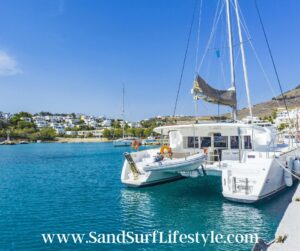
The ocean covered?
The places visited?
The company on board?
The memories made?
The knowledge gained?
The time spent on the water, and with the natural world?
The experience of actually steering a vessel through the sea, one of nature’s greatest miracles?
A combination of the above?
None of the above?
Think about it. Really take your time. Once you have a clear, honest idea of why you might want to sail a catamaran around the world, write it all down on a piece of paper. These notes will be your best friend while you read through this article and, eventually, decide on the appropriate vessel for your journey.
Initial Factors to Consider When Settling on a Catamaran Size
Primary items to consider when deciding on the size of your catamaran include basic comfort, speed, and circumnavigation.
For example, yes — the smaller, cheaper catamaran can carry a certain amount of people. But can it do so comfortably? Or will you and your passengers pay the price? We’ll get into this in more detail in just a moment. First, let’s talk about the speed of your catamaran. It’s all related — we promise.
When it comes to determining size, one must consider speed as well. Large, overloaded boats can move too slowly — but smaller ones can, too. This is where the shape of the boat comes into play. Boats with longer shapes and builds are absolutely your friends when selecting a catamaran — regardless of the size, you wind up going with. Not only are these better for speed, but they also come highly recommended by experts for circumnavigation and cargo purposes — the latter of which we will get into in more detail in the next section.
Regarding circumnavigation — what fun is sailing a catamaran if you can’t control it? Your ability to guide your catamaran should always be the top priority. Anything that seems to complicate or hinder this is something you should immediately rule out when deciding on a vessel.
How long does it take to learn how to sail? Find out here .
The relationship between catamaran size and essential “cargo”.
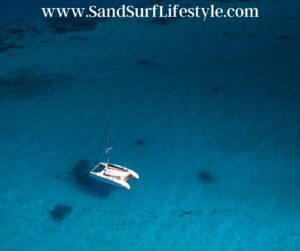
But there are other types of “cargo” as well. Necessary supplies, recreational items, the number of human beings, and how much space passengers will need while on board also matter — significantly.
For starters, ask yourself while you settle on a size for your catamaran whether you will have enough room for all the necessary supplies. Be honest with yourself. Longer, slower trips take more time and, therefore, require more of them. No matter what, you’ll need these items — food, water, first aid, medications, hygiene products, and other essential, rather heavy, and bulky supplies — while on board.
Additionally, if there are plans for fun and recreation while sailing — which, let’s be honest, there probably are — then you’ll need to ensure your vessel has the capacity for all of that as well. We’re talking furniture, sports stuff, audio equipment, and more. This aspect may seem like it should be an afterthought, but we promise you — it shouldn’t be. Be sure to keep it in mind while shopping around. What point is there to sailing around the world if you feel deprived, bored, or full of regret the entire time anyway? Make sure you have everything you’ll want and need before setting sail.
Furthermore, and as we already mentioned before, passenger “cargo” is also a thing. It’s vital that your catamaran have enough capacity for humans not only to survive but to travel comfortably.
Is this sail around the world all work with little to no play or human company? Then you won’t need as much room. The more likely scenario, however, is that you and the other people on board are looking to have fun — and therefore require adequate space to do so. This is a different type of “cargo,” but one that should be adequately considered throughout the selection process.
Similarly, imagine acquiring all the recreational items and loading them on board only to start sailing and discover that there isn’t even any room to use them all. Recreational, social, and even essential activities require the room in which to do them. Therefore, it’s important to have an idea ahead of time regarding what activities might be taking place on board. This will help you determine just how large of a vessel you need, as well as the shape of it.
What’s the point in sailing a catamaran around the world if you even can’t carry the things or people you need to make the trip worthwhile anyways?
Determining Catamaran Size in Relation to Your Budget
Of course, one of the most important considerations when deciding on a catamaran size is your budget. Larger catamarans with more features will cost more money upfront, yes. Nevertheless, the payoff regarding comfort, efficiency, practicality, and enjoyability while on board — as well as mandatory supplies you’ll need to carry on your travels and maintenance the vessel may eventually need — might make the investment worth it.
More importantly, safety is never worth skimping on, especially when it comes to sailing through the ocean over an extended period of time. If a smaller, simpler model is more affordable for you, just make sure it serves all your purposes, and that the lower price you’re paying is only in regards to the size of the catamaran. Paying less for a smaller vessel should not equal a higher risk factor while on board. Safety is key, and therefore, nonnegotiable.
The Best Catamaran Size(s) for Sailing Around the World
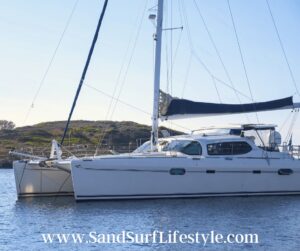
Some consider catamarans sized at 35 feet to 45 feet to be the best for ocean sailing. Many even consider 45 feet to be the sweet spot when it comes to picking out a catamaran for trips around the globe.
This isn’t to say that smaller vessels aren’t also an option. Catamarans sized at 25 feet to 30 feet are far more affordable — though, again, boats in this size range do tend to be more uncomfortable and less convenient. They also have less capacity. However, it is still possible to sail around the world in a catamaran sized within this 25 feet to 30 feet range.
Conversely, very large vessels are also doable. Catamarans in the 50 feet to 60 feet range absolutely do exist and are available for interested parties. However, they are extremely expensive. They are very much intended for those seeking total luxury while ocean sailing.
Again, a catamaran ranging between 35 feet and 45 feet should absolutely do the trick — for comfort, efficiency, space, and more importantly, function. These will get you around the world, and happily at that.
Either way, don’t forget that the size and price of your catamaran aren’t everything. Shape, safety, and circumnavigation are equally, if not more, important when it comes to ocean sailing.
Related Questions
What kind of recreational activities are popular while sailing? Depending on the length of the trip, people may want to do anything from eating fine cuisine to drinking and dancing, to sipping coffee and reading books, to even just tossing a basketball around. It just depends on the passengers on board.
Is a faster catamaran a better catamaran? Not necessarily. It just depends on how much time you want to spend at sea, and whether your trip is more about efficiency or luxury, and land time or water time. Just keep in mind that more time at sea means you’ll need more supplies and, therefore, more capacity for storing them.
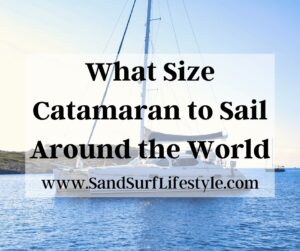
Please note: This blog post is for educational purposes only and does not constitute legal or medical advice. Please consult a legal expert or medical professional to address your specific needs.
Aloha! My name is Shawn and I Love the Beach and Ocean! From surfing to beach sports to boating and fishing I like it all. More importantly, I Love the people I get to meet who also share a passion for the sand and surf. Living and growing up near the ocean my heart has always been connected to the beach and its lifestyle. I wish to share my experience with those around the world. Mahalo (Thank You) for visiting and enjoy your stay here on my site!
Recent Posts
Exploring Shipwrecks: The Ultimate Scuba Adventure
As an Amazon Associate, I earn from qualifying purchases.Exploring shipwrecks has always been one of the most thrilling experiences for me as a scuba diver. It blends history, mystery, and marine...
Ride the Waves: Best Music Playlists for Surfing
As an Amazon Associate, I earn from qualifying purchases.Music and surfing go hand in hand for me, creating the perfect blend of rhythm and waves to enhance the overall experience. The right...
- 672 Wine Club
- Motorcycles
- Car of the Month
- Destinations
- Men’s Fashion
- Watch Collector
- Art & Collectibles
- Vacation Homes
- Celebrity Homes
- New Construction
- Home Design
- Electronics
- Fine Dining
- Gateway Bronco
- On Location – Olympic Games Paris 2024
- One&Only
- The Ritz-Carlton, Kapalua
- Saratoga Spring Water
- Wynn Las Vegas
- Sports & Leisure
- Health & Wellness
- Best of the Best
- The Ultimate Gift Guide
This Sleek New 112-Foot Aluminum Superyacht Has an All-Glass Sky Roof
The bluephire 34 is on the market with ocean independence for about $12.3 million (€11.5 million)., rachel cormack.
Digital Editor
Rachel Cormack's Most Recent Stories
This wild new 62-foot yacht has not one but two party decks.
- This Spanish Space Balloon Will Start Flying From Seville to the Stratosphere Next Year
This New 95-Foot Yacht Pairs the Agility of a Runabout With the Luxury of a Superyacht
- Share This Article

After spending 45 years building luxury yachts for industry heavyweights such as Sanlorenzo, Codecasa, and Benetti, Tureddi has finally decided to create something for itself.
Related Stories
- This Bonkers Cadillac Escalade Has Bulletproof Armor and a Smoke Screen
- Saleen Is Working on a Hydrogen-Powered Supercar
- Lewis Hamilton: The Spanish Grand Prix Usually Tells You How Good Your Car Is

Described as a “sports car of the sea,” Bluephire is an open cruiser with sleek, elegant lines and a low-slung profile. Designed for a Mediterranean lifestyle, the yacht is geared toward indoor-outdoor living and can cover some serious nautical miles. With a beam of almost 23 feet and an interior volume of 230 GT, Bluephire also offers a vast and comfortable interior.
The loft-like living quarters center around a striking glass salon that opens at both ends to connect the interior and exterior. The main living area features a comfortable lounge, a dining area to starboard, and a bar to port. The foredeck is dotted with sun beds, the lower salon is adorned with cozy lounges, and the pilot house offers another relaxation spot near the helm. Bluephire is also outfitted with three staterooms for up to six guests and well-equipped crew quarters. The yacht can be customized to the owner, with several options for color schemes and other details.
In terms of grunt, Bluephire is powered by two MAN V-8 engines rated at 1,000 hp that enable a maximum speed of 35 knots and a range of 450 nautical miles at a cruising speed of 14 knots. You can also opt for two MTU 16V 2000 M96L engines for a range of 370 nautical miles at a cruising speed of 25 knots.
Bluephire is currently for sale with Adrian Soos and Thomas Merlier of Ocean Independence , with an asking price of roughly $12.3 million (€11.5 million). The team says the yacht can be completed in a mere 18 months.

Rachel Cormack is a digital editor at Robb Report. She cut her teeth writing for HuffPost, Concrete Playground, and several other online publications in Australia, before moving to New York at the…
Read More On:
- Ocean Independence
More Marine

Palm Beach Motor Yachts Just Unveiled a Sleek New 90-Foot Flagship

Lürssen’s Newest Superyacht Is a 269-Foot Tri-Deck Behemoth

The Grand UK Debut
JULY 17 - 19, 2024 Head to the British countryside to test and evaluate the top luxury and performance vehicles of 2024.
Give the Gift of Luxury
Latest Galleries in Marine

WiLder 60 in Photos

Holterman X-95 Yacht in Photos
More from our brands, meet yawn, a psychedelic accessory brand providing education and better trips, nba, nfl pros back dartmouth labor push as afl-cio files for seiu, ‘the divorce’ wins shanghai golden goblet best film prize, new york’s mitchell-innes & nash to close chelsea space, transition to ‘project-based advisory’, the best yoga mats for any practice, according to instructors.

16 Best Trimarans For Sailing Around The World (And a Few For Daysailing)
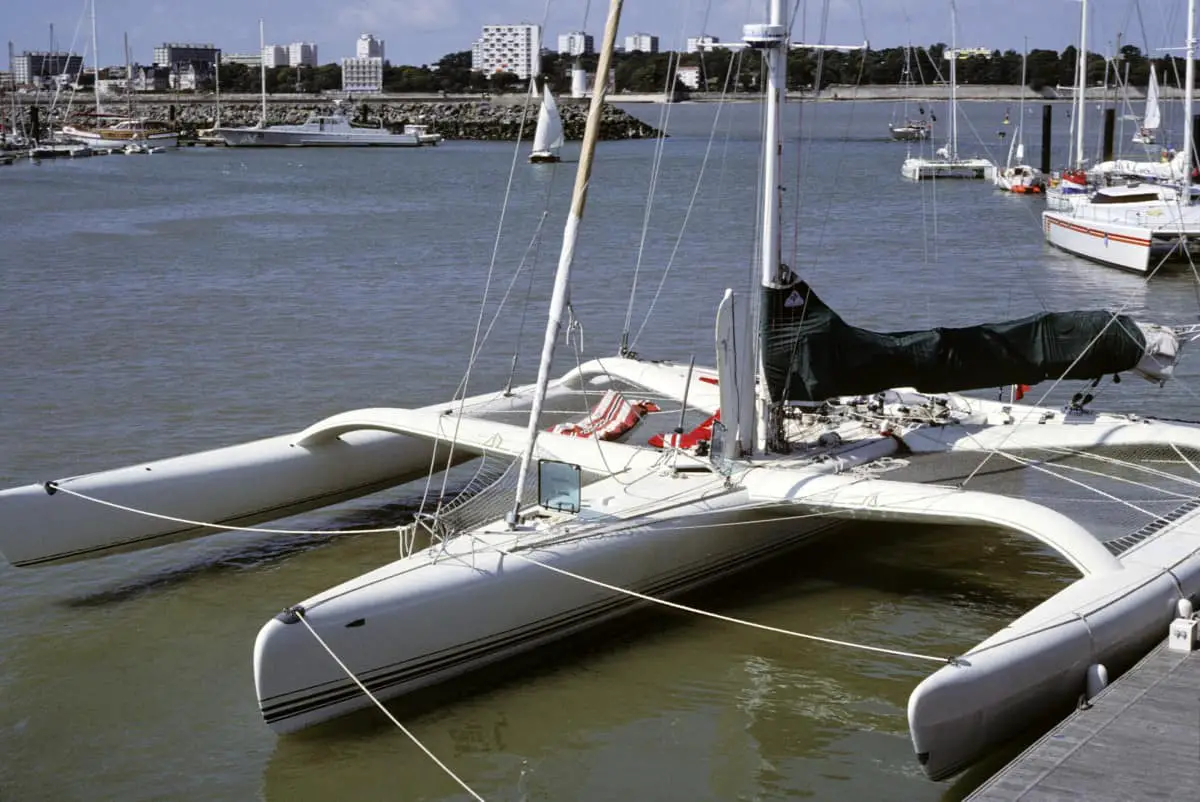
As an Amazon Associate, we earn from qualifying purchases. We may also earn commissions if you purchase products from other retailers after clicking on a link from our site.
Trimarans are growing in popularity worldwide, due to their light construction and high stability these multihulls are even faster than catamarans. Trimarans are still one of the lesser-known boat types so in this article ill be checking out some of the most popular models.
The best trimarans include:
- The Neel 43
- The Neel 47
- Dragonfly 28
- The Pulse 600
- Corsair 37
These tris are built with your safety in mind while also packing powerful speed and a wide array of comfort features to optimize your sailing experience , some are even foldable making them possible to load on a trailer and transport to the sailing destination of your choosing.
In this article, I have created a list of the 16 best trimarans in the market and their unique features. You’ll also learn the best options for different purposes such as circumnavigation, weekend sailing, racing, and more.
Table of Contents
What Is a Trimaran?

A trimaran is a multi hulled sailboat with three individual hulls; the main hull ( vaka ) and a pair of outrigger hulls ( amas ). These smaller outrigger hulls are attached to the main hull using beams.
While trimarans have a rich history dating back nearly four millennia, these types of sailboats have only gained popularity in the late 1900s and early 2000s.
Trimarans are primarily used as personal boats for sailing enthusiasts or racing. These sailboats draw their versatility from their lightweight design, making them faster and easier to handle at sea when compared to single-hulled boats (monohulls). Additionally, the three hulls also contribute to better stability, making it very hard to capsize (although more likely than a cat according to this study)
Trimarans come in various sizes, and some can be as small as 19 feet (5.8 meters) in length, while others go up to 60 feet (18meters). They’re also used for different purposes. Most trimarans are used for racing and recreational purposes, although some units are still used as ferries.
As with all things, to find out which is the best we need to understand what it will be used for. There is a big difference in requirements between a boat used for day sailing compared to offshore around the world sailing.
The list below highlights the best trimarans for different purposes.
Best Trimarans For Cruising, Liveaboard and Sailing Around The World
The Neel 43 is a French trimaran best suited for cruising. Its key features include:
- Easy maneuverability on the open sea by only a small number of crew members
This unit is also built for comfort, ideal for more extended travels. This 43-feet (13-meter) trimaran is also made with recyclable and bio-sourced materials, highlighting the manufacturer’s commitment to environmental consciousness.
This trimaran has a base price of €329,000 excluding VAT. This translates to approximately $370,138.
2.Neel 47 Possibly The Best
Named the best full-size multihull for 2020, the Neel 47 is a strong contender for one of the best trimarans in the market. This 47-foot (14.3-meter) long trimaran features optimized exterior and interior ergonomics for a unique design and look.
Still on design, the Neel 47 is ideal for couples looking to take a weekend off or spend some time as liveaboard. It has a spacious owner’s cabin and two bedrooms. It also features a spacious living room and kitchen and is optimized to ensure comfort for a couple.
The Neel 47 also has two basic guest cabins so your friends or children can tag along on your sailing adventure. Accordingly, this unit is ideal for those looking to explore the sea for the sheer joy of sailing.
The Neel 47 comes at a 571,139 euro ( $643,600 ) price tag, excluding VAT.
3. Rapido 60 The Fast and Comfortable Circumnavigator
The Rapido 60 offers a blend of performance, safety, and luxury, making it one of the best options for bluewater sailing. Measuring 59.3 feet (18 meters) in length, the Rapido 60 is an imposing unit. It’s made from lightweight sandwiches and carbon materials that provide speed and strength, allowing it to stand up to strong ocean currents.
The Rapido 60 also has spacious living spaces and is built for comfort at all points of the sail. Its design also optimizes safety. While it’s an ideal option for circumnavigating, it’s also an excellent choice for racing due to its speed.
This is also the same boat that The Youtube channel La Vagabond just purchased.
The Rapido 60 retails at $1,400,000 .
4. Rapido 40
The Rapido 40 measures 39.4 feet (12 meters) in length and is ideal for cruising around the world. The Rapido 40 features twin “C” foils, which provide added lift, enhancing its speed and performance whether you are sailing downwind or upwind.
Because it has C foils, this trimaran doesn’t have a central daggerboard, increasing interior space. Accordingly, it’s an excellent option for couples looking to cruise and enjoy great performances .
The Rapido 40 is made from high-tech all-carbon materials for a lightweight yet sturdy design. This material is also used for the countertops and furniture, and the cork flooring adds a touch of style.
This trimaran retails for $595,000 , making it a cheaper option than the Rapido 60.
5. Dragonfly 40
The Dragonfly 40 measures 40 feet (12 meters) in length. It features high-comfort standards, making it one of the best trimarans in the market for taking your family for a cruise. Because of its larger size, it has a better capacity, being capable of accommodating six to eight people, so you can bring your family and friends along.
It’s easy to navigate and extremely safe. With a maximum speed of 24 knots (44.5 km/h), this trimaran also provides fast speeds to make your cruise even more exhilarating.
The Dragonfly 40 retails from €509,000 exclusive of VAT, which rounds up to $572,000 .
6. Dragonfly 32
The Dragonfly 32 is a high-performance cruiser. Like the Dragonfly 28, this unit features a contemporary design for racing. This trimaran can accommodate five to seven crew members.
Although slightly longer than the Dragonfly 28 with its 32-foot (9.8-meter) length, the Dragonfly 32 has a max speed of 23+ knots (42.6+ km/h), making it one of the fastest trimarans for racing. This unit also has comfortable accommodation, which makes it an ideal option for a weekend cruise with family and friends.
The Dragonfly 32 has a base price of $350,000 .
7. Corsair 37
Thanks to a variable draft with a retractable rudder, the Corsair 37 is an ideal choice for shallow water exploration. This 37-foot (11.3-meter) long trimaran features advanced foam-cored construction designed for safety, making it virtually unsinkable.
The carbon hulls minimize weight, this makes for a lightweight ocean exploration sailboat with blistering speeds. One of its selling points is that this trimaran has previously been used for Arctic expeditions, possibly marking it as one of the better options for circumnavigation and offshore sailing in the northern waters.
This trimaran has a base price of $189,000 but can go up to $204,125 .
Best Trimarans For Day/Weekend Sailing
8. dragonfly 28.
The Dragonfly 28 is a 28-feet (8.75-meter) long sailboat that can accommodate up to five people. It comes in two versions:
- Touring version: This version is ideal for families.
- Performance version: This is built to provide optimal performance for the sports enthusiast within you.
It clocks a maximum speed of 22+ knots (22+ km/h) and is beam-folded. It’s an excellent option if you want a high-performance, comfortable yet smaller unit for your day or weekend cruise.
The Dragonfly 28 starts at €188,280 inclusive of VAT, which comes to around $211,600.
9. Dragonfly 25
Like other trimarans under the Dragonfly brand, this 25-foot (7.62-meter) trimaran is great for both racing and short term cruising. However, this high-performance boat delivers easy handling, making it perfect for couples looking to take a ride out over the weekend and seasoned sailors looking for an exhilarating racing adventure.
The Touring version features a lightweight build and offers comfort and accommodation to keep you, and the few guests you can fit, comfortable during the ride. This trimaran also has a Sport version, which is optimized for racing.
The Dragonfly 25 retails from EUR 86,800 .
10. Pulse 600
The Pulse 600 trimaran is a compact sailboat. It’s made from lightweight, carbon-reinforced construction and vacuum-formed materials for optimal speed. This trimaran is an ideal option if you are looking for speed.
It also features ample deck space, greater stability, and volume than most trimarans of similar size and build.
This trimaran measures 19.8 feet (6 meters) in length and can be sailed single-handedly by one person with minimal effort. The Pulse 600 has a base price of $38,800 , which places it in the lower price range.
The F-22 is one of the smaller trimarans in the market. Developed in New Zealand, the F-22 is a folding trimaran built for speed. The hulls are made from narrow fiberglass tied together using fiberglass beams and aluminum, minimizing bulk while optimizing speed.
The F-22 is roomy and is not as pricey as other models in the market. This trimaran has two main versions:
12. 2019 Weta Trimaran
The 2019 Weta trimaran is a 14.5-foot (4.4-meter) trimaran featuring a carbon frame, centerboard, rudder foil, and rudder shock. The hull is made from fiberglass and foam. The Weta is built for strength and speed based on these lightweight materials.
The 2019 Weta trimaran is easy to sail and is worth considering whether you want to take a quiet sail, race with your friends, or take kids to a sailing lesson. It has a simple design and is easy to set up independently. Thanks to its collapsible design, this trimaran is easily stored away with minimal space demands.
13. WindRider 17
The 17.4-foot (5.3-meter) WindRider 17 is one of the more versatile trimarans in the market. It packs high performance for a low cost. This trimaran has a light rotating mast to boost performance, and a full-battened mainsail optimizes visibility.
This sailboat is made from rotomolded polyethylene, which is more durable than fiberglass and demands less maintenance.
The WindRider 17 has a comfortable interior and can fit six adults. This is an ideal choice for social sailing for a couple or a family and friends. It’s easy to ride, and a shallow draft allows easy maneuverability.
14. Astus 22.5
If you’re looking for something small but still comfortable, this 22.5-foot trimaran is for you. Built for speed and maneuverability, the Astus 22.5 has optional foils to optimize speed. The modern design, coupled with the spacious interior, can fit up to four beds. Accordingly, this trimaran is suited for family outings.
This trimaran also has a foldable design, collapsing to only 16 feet (4.9 meters) for easy storage.
15. Multi 23 Trimaran
The Multi 23 trimaran has a contemporary design, featuring a vinyl ester and PVC foam core construction. The section below the waterline is made of solid glass for a sturdy base.
The beams are made of lightweight carbon, and the trimaran features a 33-foot (10-meter) aluminum rotating wing mast for optimal harnessing of the wind. While ideal for weekend excursions with family, once rigged with the asymmetrical spinnaker will get your heart pumping.
This trimaran packs high performance at a lower cost than most other options in the market. It’s a good choice if you are looking for a high-performing unit without spending an arm and a leg.
16. Challenger Class Trimaran
The Challenger Trimaran 15 is the best choice for persons with disabilities. It’s designed to provide disabled sailors an opportunity to explore their passion for sailing without worrying about aspects like safety or operation.
A man named Geoff Hold circumnavigated the British Isles in 2007, becoming the first disabled person to achieve this feat. He had quadriplegia.
Living up to its name, the Challenger can withstand harsh weather conditions while blending performance with speed.
Final Thoughts
Admittedly, no trimaran is best for everyone. But whether you are looking to race with your friends, take your loved ones or friends for a cruise over the weekend, or circumnavigate the ocean, you can rest assured that these lightweight trimarans will deliver speed, safety, and comfort to make it worth your while.
These brands are innovatively designed and feature intricate safety mechanisms that make them virtually unsinkable. Give them a shot and begin your ocean adventure.
- Basco Boating: A Comprehensive Guide & Introduction to Trimaran Yachts
- TheBoatAPP: New Trumarans: Which are the Best Ones
- Corsair Marine: Corsair 37
- Dragonfly: Dragonfly 28
- Rapido Trimarans: Rapido 60
- Neel Trimarans: Neel 43
- Yachting World: World’s Collect Yachts: Maxi Trimaran MACIF
- Yachting Monthly: Dragonfly 28 Performance
- Rapido Trimarans: Rapido 40
- Dragonfly: Dragon 32
- Dragonfly: Dragonfly 40
- Yachting World: Dragonfly 40 yacht tour: This cruising trimaran can do 24 knots
- Dragonfly: Dragonfly 25
- NauticExpo: Dragonfly 25
- Yachtworld: Corsair 37 boats for sale
- Cruising World: Neel 47 Trimaran: Best Full-Size Multihull0
- Neel Trimaran: Neel 47
- Multihull Solutions: NEEL 47 Boat Review | Cruising World
- Yacht World: 2022 Neel 47 for sale
- Farrier International: F-22
- Weta Marine: The Boat
- WindRider: WindRider 17 Trimaran Sailboat
- Astus Boats: Astus 22.5
- Boat-specs: Multi 23
- National Maritime Museum Cornwall: Challenger Trimaran #1 – BC26
Owner of CatamaranFreedom.com. A minimalist that has lived in a caravan in Sweden, 35ft Monohull in the Bahamas, and right now in his self-built Van. He just started the next adventure, to circumnavigate the world on a Catamaran!
Leave a Reply Cancel reply
Your email address will not be published. Required fields are marked *
Save my name and email in this browser for the next time I comment.
Recent Posts
Must-Have Boat Gear for Catamaran Sailors!
Sailing is probably the most gear-intensive activity I've ever done; there are so many decisions to be made about what gear to buy now, for tomorrow, and what to definitely never buy. The gear on...
6 Best Trailerable Trimarans For Bluewater and Coastal Sailing
Having a boat costs a lot of money, even when you are not using it, marina fees, etc. And once it is in the water most sailors never go very far from their "home marina" and sailing will be somewhat...


AMSTERDAM--( BUSINESS WIRE )--Tommy Hilfiger, which is part of PVH Corp. [NYSE: PVH], announces a multi-year partnership with the United States SailGP Team as Official Lifestyle Apparel Partner of the team. Sharing an ethos of disruption and innovation, Tommy Hilfiger and the US SailGP Team will use the partnership to push the boundaries of performance, design and culture.
“Since I was very young, I always loved the world of sailing and the nautical lifestyle – but SailGP is next level; it’s a whole new sport,” said Tommy Hilfiger. “By fusing intense racing and elite performance with international competition in iconic venues around the world, SailGP is making waves in adrenaline sport. Mike Buckley and the U.S. SailGP team have a unique vision to create a story and an impact that goes well beyond sporting competitions. I am so inspired by their grit, determination and innovation, and together we have the opportunity to disrupt sailing and bring something new to fans globally.”
The most exciting race on water, SailGP is world-renowned for its flying boats, record-breaking speeds and adrenaline-fueled races. The U.S. SailGP Team partnership will launch globally at the Season 5 opening Sail Grand Prix in November 2024, as the circuit brings world-class athletes from rival national teams to legendary global locations; previous seasons have included races from Sydney to Saint Tropez and New York.
“I’ve long been in awe of how Tommy Hilfiger has defined fashion in sports, so this partnership is a literal dream come true,” said Mike Buckley, U.S. SailGP Team CEO. “Tommy Hilfiger blends the world of style and athleticism like no other, and I get goosebumps when thinking about how we're going to shake up the world of sailing.”
Having collaborated with sailing teams and athletes since the early 2000s, Tommy Hilfiger continues to pioneer in sports sponsorship by supporting the breakthrough platform - both on the water and onshore. The US SailGP’s F50 foiling catamarans will feature the TOMMY HILFIGER logo on each side of the boat, as well as team uniforms, and capsule collections. Celebrities and special guests will be invited to exclusive partnership activations, such as riding with the team to experience the exhilarating reality of high adrenaline sailing during ‘6th Person Sailor’ moments, while VIPs will enjoy the highest standard of hospitality in the Adrenaline Lounge.
Sailing has been in the DNA of the TOMMY HILFIGER brand since Hilfiger first designed the iconic flag logo around the nautical alphabet for his initials - T, J and H – Thomas Jacob Hilfiger. Long inspired by an obsession with sports uniforms and design codes, Tommy Hilfiger got on board with competitive sailing in 2003, sponsoring American sailor Brad Van Liew in the Around Alone yacht race. In 2006, the Hilfiger Sailing team took home overall victory for the first Volvo Extreme 40 Grand Prix.
Friends of the brand are invited to join the community and conversation on social media using #TommyHilfiger, @TommyHilfiger, @SailGPUSA and #SailGP.
About TOMMY HILFIGER
TOMMY HILFIGER is one of the world’s most recognized premium lifestyle brands, uplifting and inspiring consumers since 1985. The brand creates iconic style, which comes alive at the intersection of the classic and the new, co-created with people who are shaping culture around the world. TOMMY HILFIGER celebrates the essence of classic American style with a modern twist. Tommy Hilfiger offers premium quality and value to consumers worldwide under the TOMMY HILFIGER and TOMMY JEANS lifestyles, with a breadth of collections including men’s, women’s and kids’ sportswear, denim, accessories, and footwear. Tommy Hilfiger has an unwavering commitment to sustainability and inclusivity.
Global retail sales of TOMMY HILFIGER products were $9 billion in 2023 and the brand is powered by more than 16,000 associates worldwide — present in 100 countries and more than 2,000 retail stores, including its largest global flagship store at tommy. com. PVH acquired Tommy Hilfiger in 2010 and continues to oversee a focused approach to growing the brand’s worldwide relevance, presence, and long term growth.
About PVH Corp.
PVH is one of the world's largest fashion companies, connecting with consumers in over 40 countries. Our global iconic brands include Calvin Klein and TOMMY HILFIGER . Our 140-year history is built on the strength of our brands, our team, and our commitment to drive fashion forward for good. That's the Power of Us. That's the Power of PVH.
Follow us on LinkedIn , Instagram , X and Facebook .
About The U.S. SAILGP Team
Energized by prestigious new owners and investors across U.S. professional sports, entertainment and technology, the U.S. SailGP Team is led by co-owners Ryan and Margaret McKillen, and Mike Buckley as CEO. Seven-time world champion Taylor Canfield is the driver, and the U.S. squad has an All-American roster of talented athletes. The Americans are one of 10 national teams in the SailGP global championship that races in iconic locations around the world using identical hydrofoiling F50 catamarans, flying at speeds approaching 60 mph. Visit SailGP.com for more information.
Tommy Hilfiger Media Contact Lyndsey Anderson // [email protected]
U.S. SailGP Team Media Contact Laura Muma // +1.773.960.3960 // [email protected]

UK Edition Change
- UK Politics
- News Videos
- Paris 2024 Olympics
- Rugby Union
- Sport Videos
- John Rentoul
- Mary Dejevsky
- Andrew Grice
- Sean O’Grady
- Photography
- Theatre & Dance
- Culture Videos
- Fitness & Wellbeing
- Food & Drink
- Health & Families
- Royal Family
- Electric Vehicles
- Car Insurance Deals
- Lifestyle Videos
- UK Hotel Reviews
- News & Advice
- Simon Calder
- Australia & New Zealand
- South America
- C. America & Caribbean
- Middle East
- Politics Explained
- News Analysis
- Today’s Edition
- Home & Garden
- Broadband deals
- Fashion & Beauty
- Travel & Outdoors
- Sports & Fitness
- Sustainable Living
- Climate Videos
- Solar Panels
- Behind The Headlines
- On The Ground
- Decomplicated
- You Ask The Questions
- Binge Watch
- Travel Smart
- Watch on your TV
- Crosswords & Puzzles
- Most Commented
- Newsletters
- Ask Me Anything
- Virtual Events
- Betting Sites
- Online Casinos
- Wine Offers
Thank you for registering
Please refresh the page or navigate to another page on the site to be automatically logged in Please refresh your browser to be logged in
Popular theory claiming Easter Island’s population collapsed due to ‘ecocide’ is disproved
How modern archaeological research has rescued the reputation of the world’s most remote ancient civilisation, article bookmarked.
Find your bookmarks in your Independent Premium section, under my profile

Sign up for a full digest of all the best opinions of the week in our Voices Dispatches email
Sign up to our free weekly voices newsletter, thanks for signing up to the voices dispatches email.
New archaeological research has disproved one of the world’s most famous historical narratives - the environmental cautionary tale that claimed that the ancient civilisation of Easter Island in the Pacific Ocean collapsed because the islanders destroyed its ecosystem.
The research instead reveals how that civilisation thrived through tenacity and innovation until it was ultimately destroyed not by Indigenous Polynesian environmental catastrophe, but by European aggression, disease and exploitation.
The archaeological investigation shows that the island’s population remained stable at around 3,000 until the arrival of often violent and disease-carrying European and European-originating whale-hunters, slavers and colonisers in the mid-19th century.

The population’s ability to survive at a stable level up until that time appears to have been due to advanced horticultural techniques that the islanders used to maximise food production.
The new research, conducted by scholars from three American universities and an indigenous Easter Island scholar, shows that the early islanders identified areas of the island as being suitable for intense horticulture and then used sophisticated techniques to increase crop yields.
Their use of those techniques (rock-mulching and rock-gardening) implies a sophisticated knowledge of horticultural agronomy - technologies they almost certainly brought with them to the island, along with relevant plant food species, when they first arrived there in around 1200 AD.
Rock-mulching involved an initial realisation that the natural soils available do not have the required nutrients and then another realisation the missing nutrients could be added to the soils by grinding up rocks and mixing the resultant rock dust with the soil.

Rock gardening helped regulate ground surface temperature, wind speed and humidity. By strewing small rocks and stones around their gardens, and by planting crops in the small spaces between them, they gave plants greater protection from wind and wind-borne sea salt and also helped maintain more constant temperature and humidity levels. The Easter Island civilisation was a Polynesian one, like the cultures of hundreds of other islands scattered across the Pacific.
Most of those islands are very remote and are often hundreds of miles apart - but what makes Easter Island unique is that it is arguably the most remote and isolated place ever settled by humans in ancient and medieval times.
It is 2,200 miles from the nearest large land mass, South America, and 1,150 miles from the nearest other land. Linguistic, genetic and other evidence suggests that the Polynesians who colonised Easter Island in around 1200 AD came from the Gambier Islands, around 1,700 miles away.

The Polynesians were among the world’s first great mariners. Using 20-metre-long catamarans, they used the stars, the sun, the wind, wave and swell direction - and knowledge of seabirds and tiny bioluminescent marine microorganisms - to enable them to navigate with very substantial accuracy.
The Polynesian explorers who discovered and settled on Easter Island almost certainly had no prior knowledge that the place existed. Like many other ancient Polynesian explorer-colonists, they would have set out into the unknown with no way of knowing whether they would ever find land.
With Easter Island being 1,700 miles from the Gambier islands, they would have been nearing or exceeding the limits of their return-permitting range. Indeed some long-range Polynesian explorer-coloniser expeditions must have occasionally ended in lethal failure – when they failed to find new lands and starved to death on the high seas.
Although the small islands scattered across the Polynesian Pacific account for only around 0.2% of that part of the Pacific Ocean’s total area, Polynesian mariners were more skilled in finding tiny specks of unknown land than any other people on Earth.

Using their knowledge of wave and swell phenomena, tell-tale land-originating bioluminescent micro-organisms and seabird behaviour, they were able to increase their chances of finding previously unknown islands. And using giant twin-hulled canoe catamarans, they were able to take adequate amounts of food and fresh water.
They also brought with them the Polynesian tradition of ancestor worship and the linked phenomenon of carving statues (representing those ancestors).
The globally famous giant stone statues of Easter Island are the world’s best-known Polynesian monumental works of art. Although only around 600 completed Easter Island statues survive intact or in fragmentary state today, it’s likely that several thousand were made over the centuries - from five-tonne ‘small’ statues to giant nine-metre, 86-tonne ones.
It’s likely that the first Easter Islanders arrived as a group of around a hundred people on around six ocean-going canoe catamarans. By around 1300, the naturally expanding population reached the island’s carrying capacity - around 3,000 people.

The island’s palm-trees were not suitable for making large ocean-going boats, so the inhabitants became completely isolated. Over the next 500 years, they chopped down most of the palms - and turned the best 1% of the land into mulch-enhanced food gardens and used up to a further 10% of land to cultivate yams, bananas and sugar cane.
All the crop species had been imported, probably on that first 1200 AD voyage. They had also imported chickens and a type of rat; species which provided protein over subsequent centuries.
It had taken huge bravery, skill and determination to discover and settle Easter Island - and centuries of hard work and dedication to maintain a stable successful society.
But that society and most of its members were not able to survive the arrival of disease-carrying violent Europeans in the mid-19th century; many died of European diseases and others were kidnapped and enslaved.
European (including British) businessmen took control of the land, turning it into a vast ranch, populated by 50,000 sheep. Ultimately, it was those sheep which destroyed Easter Island’s surviving environment - and it was disease and brutal slavery which killed most of its inhabitants.
By the 1860s 95% of Easter Island’s Polynesian population were dead or had been forced to leave. But, over the past 130 years, the indigenous population has recovered and now makes up 45% of the 7,800 inhabitants of the island, also known as Rapa Nui – and part of Chile since 1888.
The ground-breaking study, disproving the Indigenous ecocide theory, published yesterday by Science Advances , was co-authored by American archaeologists Dylan Davis (Columbia University), Robert DiNapoli (Binghamton University) and Terry Hunt (University of Arizona) - and by Gina Pakarati, an Indigenous independent researcher living on Easter Island.
Join our commenting forum
Join thought-provoking conversations, follow other Independent readers and see their replies
Subscribe to Independent Premium to bookmark this article
Want to bookmark your favourite articles and stories to read or reference later? Start your Independent Premium subscription today.
New to The Independent?
Or if you would prefer:
Want an ad-free experience?
Hi {{indy.fullName}}
- My Independent Premium
- Account details
- Help centre
More From Forbes
Sir ben ainslie's reshuffle led to big wins for british sail team.
- Share to Facebook
- Share to Twitter
- Share to Linkedin
Ben Ainslie, longtime driver and now CEO of Emirates Great Britain SailGP Team, before a practice ... [+] session ahead of the Emirates Sail Grand Prix presented by P&O Marinas in Dubai, UAE. 8th December 2023.
No one can control the wind, and no one knows that better than Ben Ainslie CBE, also known as Sir Charles Benedict Ainslie, one of the world’s most renowned sailing competitors.
The British four-time Olympic gold medalist has spent the last two seasons at the helm of Great Britain’s Emirates GBR team , first as the crew’s captain, or driver, to use competitive sailing terminology, and most recently as the organization’s CEO.
With a hard-fought win in Halifax, Canada, just three weeks ago and a total of three wins this season, Ainslie's team is gearing up for the thrilling New York Grand Prix this weekend. The event promises both excitement and challenges, just like any other team in the SailGP Circuit.
“New York is perhaps our (SailGP’s) Monaco,” Ainslie said, referring to the popular but difficult Formula 1 auto racing venue, also known as racing’s crown jewel.
“As a location, New York is iconic. But it’s a tricky circuit,” Ainslie added, during our Zoom interview this week. “There’s not a lot of space in New York Harbor, and whether the wind is blowing over Manhattan or Jersey City to wherever, it’s going to be disturbing and make for a pretty challenging race course.”
Midway through SailGP’s current and fourth season, the Emirates GBR made a personnel move that has begun to pay off. Ainslie said he opted to “step off the boat and replace himself at the driver position with fellow veteran Giles Scott.
Samsung Makes Surprise Free Offer For Galaxy S24 Ultra Buyers
Wwe smackdown results, winners and grades as drew mcintyre destroys cm punk, in photos: full ‘strawberry moon’ rise marks once-in-18-years event.
The 36-year-old Scott has also won his share of titles, including six sailing World Championships and two Olympic gold medals, at Rio De Janeiro 2016 and Tokyo 2020, both in the Men’s Finn sailing competition.
Mills with Giles Scott, Emirates Great Britain SailGP Team driver after winning the final race on ... [+] Race Day 2 of the ROCKWOOL Canada Sail Grand Prix in Halifax, Canada. 2 June 2024.
“Giles is now steering the boat, and he’s a seriously talented sailor and has been involved with us in the America’s Cup. One of the top names in the sport.”
Ainslie mentioned that even with Scott’s track record and expertise in sailing, SailGP is a different animal. SailGP’s format and treacherous courses are their own trial by fire—or, perhaps, trial by water.
“The opportunity to train (for SailGP races) is very limited,” Ainslie said. “You might get one or two days on the water before each event.”
Ainslie added that during Scott's first few events after taking over the driver spot from him, there was “either no wind” on practice days or training days that got canceled because of conditions.
Yet, Scott drove the boat during Emirates GBR’s win in Halifax. Paired with Emirates GBR strategist and fellow Olympic gold medalist sailor Hannah Mills , the British team’s trajectory has only gone up and puts them in a great position for the next SailGP season.
“The way it goes is that there’s little preparation for these sailing events,” said Ainslie, “and keep in mind these are the best sailors in the world.”
SailGP teams have eight-member crews, with six on board during the race. The six on-board roles are driver, strategist, wing trimmer, flight controller and two grinders.
Part grit, part strategy, part hive mind
Looking at the standings of the SailGP’s first three seasons, it’s clear that Team Australia, led by Tom Slingsby, is the team to beat. Slingsby made his name in sailing or racing boats much smaller than SailGP’s 50-foot double hulls, 24m sail F50 foiling catamarans—winning an Olympic gold medal in the Men’s Laser class at the London Summer Games in 2012.
But the British Emirates team are also within the top tier. In the first two seasons of SailGP, the British team took 4th place overall, and finished in third place last season.
Related story: How Hannah Mills is rewriting rules in sailing
Ainslie says that racing in SailGP is very different from racing some of the smaller boats that both he and Slingsby have raced in Olympic circuits.
“It’s very much a team game. And that was a change for me, coming from a single competitor background.” He added that the skillset gained from racing Finn and Laser boats is not necessarily transferable to SailGP. That said, in sailing Ainslie said there is “an innate feel for the sport, the water and the waves, and that doesn't really change, whether you’re doing ten kilometers per hour or a hundred kilometers per hour.”
Meanwhile, communication in SailGP is key. It’s one thing Ainslie said that the Emirates GBR team does well, and helps keep them on their game.
“Communication is absolutely critical. We’re maneuvering on a really tight course with so many other boats, and the people on board have to know exactly what maneuver is coming up and when.”
All members of SailGP teams wear not only protective gear that looks customary and similar to other racing sports. They also wear helmets and communication systems that filter out wind and water noise, while allowing crew members to hear each other succinctly.
“We have our shorthand ways of communication. There’s probably a bit of British slang in our boat,” said Ainslie. “But, there’s definitely no time to have a debate or waffle. It’s got to be really clear.”
Each boat has a crew of five; the helmsmen steer the boat, while the flight controllers manage ride height to ensure the boat doesn’t touch down during maneuvers. Wing trimmers control the boat’s 24m wing sail, and two grinders that keep up hydraulic pressure to power adjustments to the sails for optimum speed.
Sir Ben Ainslie, in action as driver of Emirates Great Britain SailGP Team, during a practice ... [+] session in Dubai, United Arab Emirates. 6 December 2023.
Ainslie also said that the Emirates GBR team has worked in the past with Great Britain’s Special Forces to optimize and tighten up communications techniques, on and off the water.
As SailGP moves toward its 2024-2025 season, the international racing league is looking to add teams and sponsor partners. SailGP announced this week that a Brazilian team will be added for Season 5, which starts in November.
Hannah Mills, a decorated Olympic gold medalist and an Emirates GBR strategist, explained that her team may have the ultimate sporting partner in Emirates.
“Having Emirates come on board with our team was massive. It gave us a lot of autonomy in how we run the team and gave us a competitive advantage,” Mills said. “Being part of the Emirates family is prestigious.”
The airline group based in the United Arab Emirates has already made a hugely successful foray into soccer , the world’s most popular sport, as title sponsor for mega clubs Real Madrid , AC Milan, and England’s Arsenal FC, among others.
“In the Middle East,” Mills added, “sailing has become a really big sport. And there is also a big push there to get women involved, and make it accessible to anyone who wants to go sailing.”
In addition to Emirates GBR’s win in Nova Scotia in early June, the team also scored back-to-back wins last September in Saint-Tropez, France, and Taranto, Italy, adding points to the current season standings.
Since mid-season, the British team has perhaps found its stride, with Scott driving the boat and Ainslie running the organization at large. Ainslie spoke humbly about their quick progress since the May SailGP race in the Bahamas, in which Emirates GBR placed 8th.
“It’s a team sport, and the course is tough for everyone.” But by adding Scott to the mix, Ainslie said, “We’ve had quite some turn-around.”

- Editorial Standards
- Reprints & Permissions
Join The Conversation
One Community. Many Voices. Create a free account to share your thoughts.
Forbes Community Guidelines
Our community is about connecting people through open and thoughtful conversations. We want our readers to share their views and exchange ideas and facts in a safe space.
In order to do so, please follow the posting rules in our site's Terms of Service. We've summarized some of those key rules below. Simply put, keep it civil.
Your post will be rejected if we notice that it seems to contain:
- False or intentionally out-of-context or misleading information
- Insults, profanity, incoherent, obscene or inflammatory language or threats of any kind
- Attacks on the identity of other commenters or the article's author
- Content that otherwise violates our site's terms.
User accounts will be blocked if we notice or believe that users are engaged in:
- Continuous attempts to re-post comments that have been previously moderated/rejected
- Racist, sexist, homophobic or other discriminatory comments
- Attempts or tactics that put the site security at risk
- Actions that otherwise violate our site's terms.
So, how can you be a power user?
- Stay on topic and share your insights
- Feel free to be clear and thoughtful to get your point across
- ‘Like’ or ‘Dislike’ to show your point of view.
- Protect your community.
- Use the report tool to alert us when someone breaks the rules.
Thanks for reading our community guidelines. Please read the full list of posting rules found in our site's Terms of Service.
Pink Retreat to bring 500 Lilly Pulitzer lovers to Palm Beach and West Palm Beach

An annual gathering of ladies who love Lilly Pulitzer will bring a flurry of brightly colored clothes to Palm Beach this week.
The Pink Retreat runs from June 20-23 and includes stops on the island — where the brand's eponymous founder sold her first colorful shift dress — and West Palm Beach, said founder and organizer Tosha Williams.
This year's event will be bigger than ever, with 500 registered attendees and Discover The Palm Beaches, the county's official tourism marketing agency, as the presenting sponsor, Williams said. It coincides with the brand's 65th anniversary, which Lilly Pulitzer is celebrating this year with new collaborations and collections .
"A lot of women who came previously, they're bringing sisters and moms and friends with them," she said. "I'm excited for the continuation of the relationship building."
Williams is from the Washington, D.C., area but now lives in Tennessee. She founded the event as a gathering for friends from Facebook groups dedicated to the brand.
From the first Pink Retreat's simple schedule in 2017 with about 100 attendees, the event has grown into a multiday celebration of the colorful lifestyle for which Lilly Pulitzer is known.
"Our destination has the honor of hosting The Pink Retreat year after year,” said Kelly Cavers, chief sales officer of Discover The Palm Beaches. “Our vibrant blend of people, cultures and colorful coastal towns that welcome everyone make The Palm Beaches the perfect destination to host this ultimate girl’s getaway, where women can reconnect and share their love for fashion and friendship."
This year, the convention features a lineup of activities that include a walking tour of Worth Avenue, cookie-making classes at Ganache Bakery, catamaran rides, journaling lessons, West Palm Beach food tours, croquet lessons, make-your-own mermaid mosaics, Latin and Caribbean dance classes, tassel-making with local fashion designer Amanda Perna and a silent disco.
Punctuating the four-day affair are some of the signature events for which The Pink Retreat has become so well-known: A welcome party Thursday night is sponsored by West Palm Beach and the Downtown Development Authority; Lilly Pulitzer technical design manager Linda Marie Iem will discuss the latest collection and details in a talk; and the Orrico sisters of C. Orrico on South County Road will host two talks to share their memories of Lilly Pulitzer and life in Palm Beach.
Also, the Henry Morrison Flagler Museum will host a Gilded Age-style afternoon tea, where attendees don Lilly Pulitzer dresses and wear fascinators while sipping the museum's Whitehall Special Blend tea and eating tea sandwiches, scones and sweets.
"Afternoon tea is an absolute staple," Williams said. The museum doesn't typically offer tea service in the off-season, but opens for The Pink Retreat, she said. "That's pretty special."
The Gardens Mall will host a ladies night, and the weekend will wrap up with two more signature events: The Pink Party at the National Croquet Center, and a farewell brunch at the Art Gallery of Camilla Webster, both in West Palm Beach.
The Pink Retreat draws women from around the country and from a range of backgrounds, making it a perfect place to get away from an increasingly polarized world, Williams said. "We can come together no matter what you believe or how you vote," she said. "It's just a weekend where we can let our hair down and have a good time."
The jump in registration for Pink Retreat from last year is part of a rebuilding effort Williams undertook following the COVID-19 pandemic, she said. Discover The Palm Beaches did a lot of marketing and the convention also received a boost from word-of-mouth support from past attendees, Williams said.
Some of the new activities at this year's Pink Retreat — including the dance classes — are designed to bring more of the flavor of South Florida to participants, she said. "It adds more diversity to their world, and more flavor and more vibrancy," Williams said. "I think it's really important for them to see and touch and smell and experience the different cultural aspects of South Florida."
Williams is proud of the inclusive space she's created at The Pink Retreat.
"There's women of all shapes, sizes, colors, sexual orientation that feel comfortable, and I think that there's a lot of to be proud of in that," she said.
The diversity happened organically, Williams said.
"I think because I'm a Black woman doing in this in the Lilly space, that is traditionally mostly white women, a lot of women felt comfortable coming out of the Lilly closet, if you will," she said.
In her traditionally Black spaces, the brand was seen as "country club," or "bougie," she said.
"I feel good in the colors," she noted. "The colors bring sunshine, and I'm just going to do me. I think a lot of other people, other ethnicities might feel the same way. I can't speak for them, but I think that because they see a woman of color, it's like, 'I'm gonna be welcome,'" at The Pink Retreat.
The representation, both in the brand and in the retreat, matters, Williams said.
"I like that women can come to The Pink Retreat and see themselves represented in that way," she said. "I think that's pretty amazing."
Kristina Webb is a reporter for Palm Beach Daily News, part of the USA TODAY Florida Network. You can reach her at [email protected] . Subscribe today to support our journalism .

IMAGES
VIDEO
COMMENTS
The best catamarans for sailing around the world include: Lagoon 42. The Fountaine Pajot Ipanema 58. Manta 42. Catana 50. Dolphin 42. Gunboat 62. These cats focus on speed, safety, and comfort for longer journeys. This article will show you the seventeen best catamarans for long journeys, and why they're the best.
The couple sailed their catamaran around the world for no less than 546 days, covering more than 34,140 nautical miles and 27 countries. Menu Fountaine Pajot - sailing catamarans. Dealers ... to explore the world on a catamaran. Onboard their Fountaine Pajot Hélia 44 "Starry Horizons", the couple criss-crossed the seas and oceans for no ...
Yes, you can sail a catamaran around the world. In fact, full-size catamarans are some of the best circumnavigation sailboats on the market. They offer superior comfort, safety, storage space, and speed when compared to monohulls. Catamarans have become increasingly popular since the 1990s, and they're seen in ports all over the world.
Photo: Leopard Catamarans. Displacement: 14.5 tons Beam: 24ft 2in Draft: 4ft 11in Features: Forward-facing cockpit, 3 or 4 cabins, 8 to 12 berths, up to 4 heads, up to 5 showers, 2 45hp engines, 780L water capacity, 700L fuel capacity. The big unique selling point of this best catamaran for sailing around the world is the forward-facing cockpit - a shaded and well-ventilated area to relax ...
Xquisite X5 Plus. 2022 saw the Xquisite X5 named the Cruising World magazine's Best Cruising Catamaran of the year - yet again (it won the Best Multihull over 50ft award in 2017) . As Ed Sherman said: 'There are 40,000 man-hours invested in this boat. And you can see it.'.
August 30, 2022. Catamarans are generally longer than monohulls, but their accommodations and handling vary widely between sizes. The best size catamaran to sail around the world is 45 to 50 feet. The smallest catamaran with space for long-term provisions and a cabin is around 30 feet in length, and a 55 to 60-foot catamaran is the largest that ...
For her first voyage - aboard the Outremer 51 #39 named Moby, the family chose to follow the trade winds. Bénédicte, Loïc, Victor, Arthur and Anna headed for the world's most famous ports of call, to discover 32 countries and 121 islands. All this in three years and 50,000 nautical miles aboard their catamaran on three oceans: the ...
HH50. HH boats are built in Asia as cutting-edge sailing catamarans for the owner/sailor market. They're designed by Morrelli and Melvin, one of the multihull world's top design firms. These boats are also semi-custom, so you won't find many on the used market.
Gemini 105M Courtesy of Gemini Catamarans. Pioneering catamaran sailor, builder and designer Tony Smith launched the first of his 33-foot Gemini 105M's (10.5 meters = 33′) in 1993, and soon after found a ready and willing stream of sailors enamored of the boat's compact size, affordable price tag, and such innovations as the nifty lifting rudder and transom steps.
There are 8 different ways to Sail around the world, Join a research vessel. Get on a friend's boat that is already out sailing. Date the owner of a boat. Get paid to work as a; Mechanic, Chef, or General helper. Use Your specialty skill to help the crew; online marketing, language teacher, musician, etc.
Displacement. When choosing a catamaran for sailing around the world, one important factor is displacement. Displacement refers to the weight of the water a catamaran displaces when floating. Size of Catamaran Displacement. Small 10,000 to 20,000 pounds. Medium-sized 20,000 to 40,000 pounds. Large 40,000 to 60,000 pounds.
Lagoon 380. The long-time best-seller from the world leader in catamarans, with more than 1,000 produced over almost 20 years from 1999. With its characteristic vertical windows, the 380 and its ...
Bénédicte can testify to this development: "The catamaran we've chosen sails easily in light airs. From 4-5 knots, it moves under sail, whereas classic catamarans need 10 to 15 knots to move properly, depending on the points of sail. So we use the engine very little and sail almost exclusively. On long journeys, sometimes the weather ...
Catamarans are also very fast and easy to handle. Dual engines make maneuvering in and out of ports easier-and if you're sailing around the world, you'll be stopping in a lot of ports. Because they're lightweight and have such a low water resistance, they can go incredibly fast with wind alone in the open ocean.
Additionally, the catamaran's sails are designed to maximize performance in different conditions, making it a great choice for both racing and cruising. If you're looking for a catamaran to sail around the world, the Nautitech 44 Catamaran should definitely be at the top of your list. Specs. Price: $550,000-$850,000; Length: 44.19 ft
Leaning towards the upper-sized catamarans for around-the-world voyages, the maximum size is 55-60 feet which offers significantly enhanced levels of comfort. Can you sail a catamaran around the world? As touched upon above, the answer to the question "Can you sail a catamaran around the world" is yes you can but traveling in comfort can ...
The perfect sized catamaran is 37 to 47 feet long. If you get too much smaller, living space gets cramped and cargo capacity drops. Too much bigger, and your expenses and difficulty of handling a big boat get higher. That's not to say that there are smaller catamarans or much larger ones that work for you. Everything from your skill level and ...
On the occasion of the Paris Boat Show which took place this December 2022, Fountaine Pajot welcomed Michel and Minouche, a couple of owners of an Astréa 42, who are realizing their dream: sailing around the world in 4 years. After 2 years of sailing, and halfway through their trip, these two courageous 70-year-olds share with us in this new ...
The Fast Route - for the minimum time. The Pleasure Route - for the maximal pleasure. The Traditional Route - the road most taken. The Arctic Route - for the rough ones. The Dangerous Route - without regards for piracy. The Cheap Route - with a budget in mind. The Coast Lover's Route - never going far from the coast.
Our PREFERRED Sailmaker: http://bit.ly/precision_sailsPLEASE SUBSCRIBE: http://bit.ly/2EmmGnLWANT US TO MAKE MORE VIDEOS? https://www.patreon.com/nahoaWe're ...
With a fleet of nearly 400 catamarans around the world, Outremer forms an exceptional community: one of fun-loving adventurers. To cultivate this bond with our sailors, we organize annual events such as the Outremer Cup, and offer platforms to help mainstream and share knowledge, such as the owners' Facebook group and a technical blog. ...
4) The actual measurements of the catamaran: 20 feet to 30 feet, 35 feet to 45 feet, and 50 feet to 60 feet being among the most popular sizes. As we already stated before, the best catamaran size for a journey around the globe varies on a case-by-case basis. It depends entirely on your needs, wants, and intentions while out at sea.
It's the largest saltwater sandbar in the world. ... so I decided to book a four-hour group tour with Captain Bob's on its 46-foot double-hulled catamaran. The boat can hold up to 65 passengers ...
Brazil will join the startline of the global racing championship from the beginning of Season 5, which commences in November 2024. The most exciting racing on water, SailGP is a global championship with national teams battling it out in identical high-tech, high-speed 50-foot foiling catamarans at iconic venues around the world.
This Sleek New 112-Foot Aluminum Superyacht Centers Around a Striking Glass Salon The Bluephire 34 is on the market with Ocean Independence for about $12.3 million (€11.5 million). Published on ...
The Rapido 40 measures 39.4 feet (12 meters) in length and is ideal for cruising around the world. The Rapido 40 features twin "C" foils, which provide added lift, enhancing its speed and performance whether you are sailing downwind or upwind. Because it has C foils, this trimaran doesn't have a central daggerboard, increasing interior space.
The Americans are one of 10 national teams in the SailGP global championship that races in iconic locations around the world using identical hydrofoiling F50 catamarans, flying at speeds ...
It's likely that the first Easter Islanders arrived as a group of around a hundred people on around six ocean-going canoe catamarans. By around 1300, the naturally expanding population reached ...
Slingsby made his name in sailing or racing boats much smaller than SailGP's 50-foot double hulls, 24m sail F50 foiling catamarans—winning an Olympic gold medal in the Men's Laser class at ...
The Pink Retreat draws women from around the country and from a range of backgrounds, making it a perfect place to get away from an increasingly polarized world, Williams said.